

ADDING VALUE TO HILL FARM ENTERPRISE – P17
THE HEART OF AGRICULTURE
Manitou material handler on test

Simmental breed ticking the boxes for family farm



Manitou material handler on test

Simmental breed ticking the boxes for family farm
● Pressure on farm businesses
● Calls to pause BPS phase-out
By Rachael BrownDEFRA Secretary Steve Barclay told farmers he would continue with the phase-out of the Basic Payment Scheme (BPS), with the NFU left deliberating how hard it was prepared to ‘fight’ on the issue.
Mr Barclay attended this week’s NFU Council to hear from farmers and growers about the impact the weather has had on their businesses, in what he described as an ‘open, frank and often emotional behind closed doors conversation’.
NFU president Tom Bradshaw said Mr Barclay had been clear the Government would continue the BPS phase-out.
“We have to decide how hard we fight with that,” Mr Bradshaw said, adding the union would ‘champion MPs to make the point about the resilience and stability BPS payments gave’.
NFU members were keen to instil in the Defra Secretary’s mind the relentless stress they had been under, and the Government must recognise ‘this is not business as usual’.
Derbyshire upland farmer Jane Bassett highlighted there had been a 35-40 per cent increase in numbers of fallen stock in March 2024 compared to March 2023, due to the ‘horrendous lambing conditions and Schmallenberg’.








Harvest update: Light land reaches the finish line
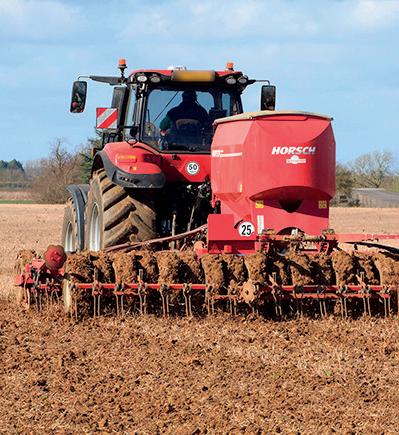



The Polish government is suggesting Polish families dig underground shelters; I think this puts some of our challenges here on-farm into context, says Ian Garnett. See p94-95.

THE NFU is using the upcoming Police and Crime Commissioner (PCC) elections as a timely opportunity to shine a light on rural crime issues and reflect on ways in which police forces combat crime in the countryside.
With the elections taking place in England and Wales on May 2, the NFU has written an open letter to every candidate standing.
Rachel Hallos, NFU vice-president, said the union was asking PCCs to ensure priorities for addressing rural crime were detailed in their police and crime plan, and to recruit a dedicated rural crime specialist.
NFU Mutual said rural crime had cost UK farmers £49.5 million in 2022, with the full scale in rural areas often ‘underestimated, under-reported and not fully understood’.
It comes as the Labour Party released details of its plans to help protect communities from rural crime through a national strategy.
Launching the party’s rural crime
From page 1
LINCOLNSHIREarablefarmerAndrew Wardwarnedaboutincreasesin strawprices.
Hesaid:“24outof49fieldsthatI farmwillnothaveacropthisharvest.”
MrBradshawsaidwhile18,000 SustainableFarmingIncentive(SFI) applicationsshouldbe‘applauded’, itwasstill‘onlyaquarteroffarm businesses’,addingtheenvironmental benefitSFIbringscomesatacost tofarmersand‘doesnotreplace thelike-for-likelossofincomeas aresultofthephase-outofBPS’.
Headded:“Weareworkingwith Defratocomeupwithasolution, butatthispointintimeIcannot saythereisactuallyanythingon thetablefromthem.”
Atatimewhenthereisa‘lackof confidence’,manyfearfoodsecurity wasyetagainatrisk.
MrBradshawsaid:“IfDefra continuesonthepathitison,it willnothavefoodsecurity.”
Allthesepressures‘paintahorrible story’fortheindustryanditcomes
strategy in the North Yorkshire village of Cawood on Tuesday (April 23), Labour leader Sir Keir Starmer said the five-point plan would bring agencies together to ‘get a grip’ of rural crime to ensure ‘everyone feels safe where they live’.
Labour’s plan includes measures to increase police patrols in rural areas, to introduce tougher measures to clamp down on anti-social behaviour, to implement new laws to prevent farm theft and fly-tipping, to expand local drug enforcement teams and coordinate action across different bodies including the Home Office, Defra and the National Crime Agency.
CLA president Victoria Vyvyan welcomed Labour’s strategy and said the first place to start was to rectify the ‘chronic underfunding of rural police forces’.
Policing Minister Chris Philp said the Conservatives’ rural crime plan was ‘working’ with a 15 per cent drop in crimes against rural households since March 2020 and a 55 per cent drop in overall crime since 2010.
atatimewhenprovisionaldata sharedbytheNFUfoundtherewere 32on-farmfatalitiesbetweenApril 2023andMarch2024,withthedeath rateinfarming21timeshigherthan theaveragerateacrossallindustries.
Butwhiletheindustry acknowledgeditmust‘take responsibility’oftheissuethroughthe positiveactionson-farm,pressures farmersfaceandthesqueezeon ‘profitability’couldnotbeignored.
ChairoftheFarmSafetyPartnership andNFUdeputypresidentDavidExwood agreedwithfarmersthatpeopleneed tobe‘valued’withinGovernmentpolicy andbysupermarkets.
MrBradshawaddedthat‘fair returnsfromthemarketwasoneof thesolutions’toeasesomeofthe pressure.
EastRidinglivestockfarmer
AndrewSewellsaidwemust‘hammer themessagehometosupermarkets’, adding‘nootherindustryallows peopletooperatemachineryfor90 hoursaweek’.

JEREMY Clarkson will return to screens next week with the launch of series three of Clarkson’s Farm.

rPig and poultry sectors impactedBy Rachael Brown
PROPOSALS to improve country of origin labelling were welcome, but suggestions of introducing ‘method of production or welfare labelling’ systems were ‘dangerous and complex’.
That was the message from NFU deputy president David Exwood at NFU Council, with warnings from the union’s chief sustainable supply chains adviser that it could be the ‘tip of the iceberg’ of what is to come, if not challenged, with particular consequences for the pig and poultry sector.
Mr Exwood urged members to respond to the consultation, adding the Defra Secretary was quite keen on labelling as the solution, and that there was a ‘danger’ Defra could react
quickly to the consultation, which closes on May 7.
Defra proposals on ‘fairer food labelling’ covers two areas – country of origin labelling, which looks to improve consumer understanding of food origin labelling; and method of production labelling, which would involve a mandatory five-tier labelling for pigs, poultry and eggs.
The NFU does not support any mandatory welfare or production method of labelling.
NFU president Tom Bradshaw said the proposals must be challenged robustly, adding ‘in reality, [Defra] see labelling as an excuse to allow in lower standard imports’.
“We have always said the science and evidence should drive these things. Several different retailers have said to me there is clear evidence that
there is no welfare issue or difference between the different systems of production, so what is this welfare labelling going to deliver on behalf of the consumer,” he said.
“It is very open to misinterpretation and huge concerns it could end up driving consumers to a misjudged decision about the food they want to buy.”
The NFU has urged the Government to begin the process of enshrining a set of core environmental and animal welfare standards in law for agri-food imports, setting a minimum threshold in domestic regulation that imports must meet to access the UK market.
Farmers and the union also questioned whether this was an opportunity to focus on ‘improving awareness and understanding of the labels and logos of existing assurance schemes’, such as Red Tractor and RSPCA Assured.
A search for new income streams is the focus of the series, with Mr Clarkson going up against newly-promoted farm manager Kaleb Cooper (pictured, left) to see who can make the most money.
The first four episodes of series three will launch globally on Prime Video on May 3, followed by the remaining four episodes a week later on May 10.
UKSUPERMARKETShavebeen accusedofusing‘inconsistentand misleadingfoodlabelling’,leaving consumersunawareofwhere theirfoodcomesfrom.
Accordingtoanewsurveyfrom consumermagazine Which?, more thantwo-thirds(68percent)of the2,011UKadultsquestioned saidtheywouldbemorelikely tobuyaproductlabelled‘British’.
Yetdespitethefindings, researchersfoundplentyof examplesoffruitandvegetables atmajorsupermarketswith novisibleoriginlabellingonthe shelfedgeortheproducts.
InoneAsda, Which? found cauliflowerswithaUnionJack ontheshelflabelwhichwere actuallyfromSpain.
Underthecurrentoriginlabelling rules,itisarequirementforthere tobeacountryorplaceoforigin labelonmeat,fish,freshfruitand vegetables,buttherulesdonot generallyapplytoprocessedmeat orfrozenorprocessedfruitand vegetables.Thereisarequirement toprovideoriginlabellingifit wouldbemisleadingnotto.



Editor
Olivia Midgley, 07787 240 750 olivia.midgley@agriconnect.com
Head of News and Business
Alex Black, 01772 799 409 alex.black@agriconnect.com
Chief Reporter
Rachael Brown, 07974 039 778 rachael.brown@agriconnect.com
News and Business Reporters
Jane Thynne
jane.thynne@agriconnect.com
Chris Brayford, 07773 110 733 chris.brayford@agriconnect.com
Business Reporter
Cedric Porter cedric.porter@agriconnect.com
Arable Technical Specialist
Ash Ellwood, 07786 190 188 ashleigh.ellwood@agriconnect.com
Head of Machinery and Farm Technology
Toby Whatley, 07583 054 831 toby.whatley@agriconnect.com
Machinery Reporter
James Huyton, 07787 242 185 james.huyton@agriconnect.com
Head of Livestock
Katie Jones, 07786 856 439 katie.jones@agriconnect.com
Features Editor and Head of Livestock Sales
Angela Calvert, 07768 796 492 angela.calvert@agriconnect.com
Livestock Specialists
Ellie Layton, 07814 997 407 ellie.layton@agriconnect.com
‘most at
DEFRA is ‘steering’ towards a more ‘moderate system’ to deal with the threat of bluetongue this summer, which would mean a single 50km zone around the first protected case, which would expand further if more cases were found.
Speaking at NFU Council, chief animal health and welfare adviser Cat McLaughlin, said the industry cannot end up with prohibitive restricted movements and not enough abattoirs to support the farmers in the zone, adding ‘we want to control the disease, but ensure farmers can maintain business viability’.
She said there were five counties identified along the South Coast which were ‘most at risk’.
“Certainly in the early days, the pain will be shared unevenly across the country, if bluetongue happens how



FARMERS have been warned that animal activism has ‘ramped up over the past three months’ and was ‘becoming more intimidating’.
National Pig Association chair, Rob Mutimer, said after a ‘very quiet time over the past five years’, increased activity from animal activists was one of the ‘major issues’ facing the pig sector right now, not only at farm level, but he said he was also alarmed by the increased number of processors which were being targeted.
“What is more worrying for me, is they are becoming more intimidating in the way they work,

Defra is aiming to limit the impact of any bluetongue outbreak.
we all think it is going to happen,” she added.
Ms McLaughlin said a bluetongue vaccine was crucial going forward, but there was a need to ‘demonstrate to pharmaceutical companies there was a commercial need for it’ and buy-in to use it.
Animal activism has ‘ramped up’
they are intimidating staff who work for processors. They have been in some of their offices.”
Mr Mutimer shared with members at NFU Council this week about the distressing videos that had been shared on social media.
“Some of the social media videos we have seen with names of certain companies, with a scarecrow painted on them with a noose round their neck. It is very concerning.”
Mr Mutimer said the police and anti-terrorism police had been kept informed and were dealing with the matter ‘very seriously’.
Ms Mclaughlin said given the threat of a number of exotic diseases, the industry needed to become ‘more resilient’.
NFU vice-president Rachel Hallos said: “There is a reality that we need to face as an industry and take responsibility of – how do we face these diseases as a result of climate change.”
Ms Hallos raised concerns around the capacity of the Animal and Plant Health Agency to carry out testing, as well as the slaughter capacity, adding ‘there has got to be an out for stock’.
African swine fever (ASF) is another disease threat the sector must keep a close eye on.
National Pig Association chair, Rob Mutimer, said there would be a ‘30day standstill’ of all pigs in the country if there was an ASF outbreak, adding members needed to have a ‘contingency plan’ if the disease does arrive and should look to ‘increase their biosecurity and ensure all farm records are up to date’.
THE Royal Countryside Fund has announced a new strategy, looking to raise £15 million over the next four years.
The charity, which was founded by the King in 2010 as The Prince of Wales, said the funding would ac-
celerate the organisation’s scale and reach as an operational, delivery-focused charity by increasing and diversifying its quality programmes of support to reach even more rural communities and farm businesses.
Keith Halstead, executive director of The Royal Countryside Fund, said it wanted ‘to become the countryside charity of choice for people living and working in rural and farming communities across the UK’.
To find out how we can protect what matters most to you, search ‘NFU Mutual Farming’ or contact your local agency.

Farm insurance
Covering small farms, large farms and everything in between.
Provided by NFU Mutual Agents, located in rural towns and villages throughout the UK.

Risk Management Services
Expert advice to identify the health and safety dangers facing your farm and provide personalised solutions for everyone’s safety.

Financial planning
From pensions to investments, life cover to business protection, we’ve been helping customers with their financial planning needs for 95 years.

rShepherdess battling landlord over quit notice sheep, with Ms Davies taking over the day-to-day running of the flock from 2018.
By Jane ThynneA WELSH shepherdess said she may be forced to ‘give up farming’ after being told she can no longer allow her sheep to graze on land that has been cared for by her family for almost 40 years.
In 2017, Claire Davies went into business with her father Hugh, who had been a tenant of Ty Mawr Sheepwalk – a 142-hectare unenclosed pasture in the Elan Valley – since 1984.
Together they managed a 300strong flock of Welsh Mountain
Following Mr Davies’ sudden death in 2021, Ms Davies was told just two days after the funeral by the owner of the land, the Elan Valley Trust, she would have to vacate.
Ms Davies said her dad was ‘known and loved’ by everyone and had farmed the land for years.
She said: “While I was really grieving the loss of my dad, I now had to start dealing with the prospect of losing my sheep.”
She has spent the past two-and-ahalf years fighting to save her flock.

She said: “They got in touch multiple times to say they wanted to buy my sheep, but I said no.
“Those sheep are hefted to the hill. They have not given me any just reason why I cannot stay.”
A statement from the Elan Valley Trust said it valued ‘the close-knit community of the Elan Valley, our tenants and our staff’ and it had paused the future letting of the tenancy while an investigation into Ms Davies’ complaint was underway.
It said it complied with agricul-
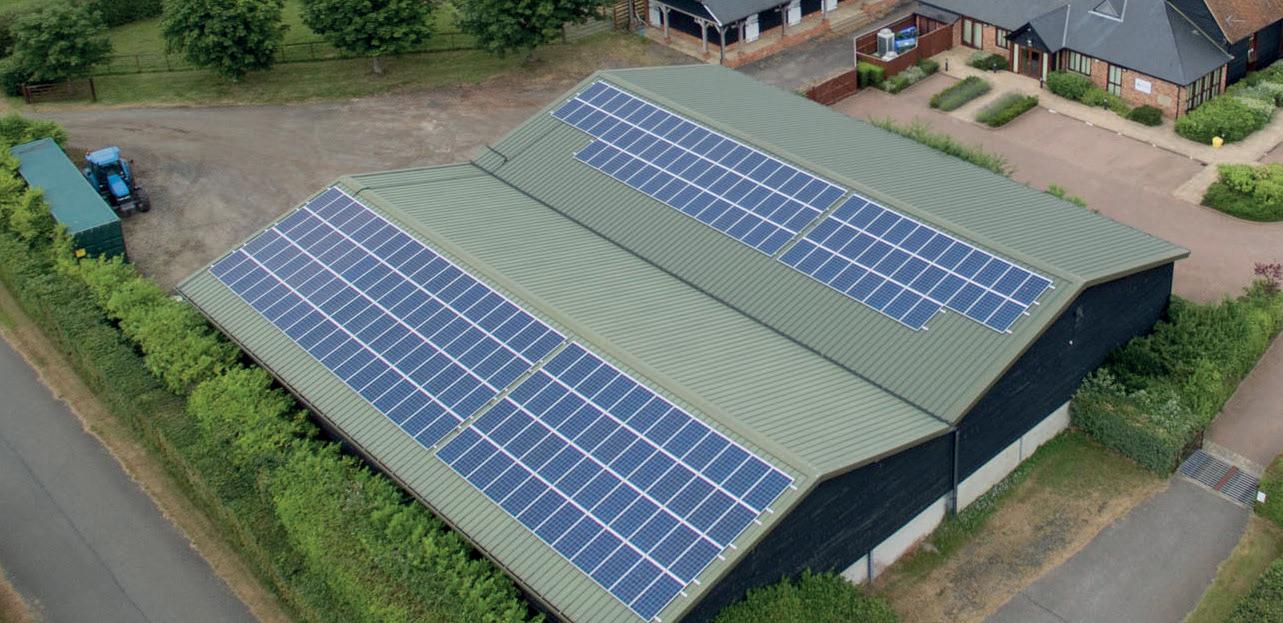

tural tenancy law and balanced this with furthering the objectives of the charity.
It said: “We offer long-term starter tenancies in line with charity law. These are advertised and recruited using a fair and transparent process.”
It added it was appointing an external expert to evaluate its procedures and conduct throughout the letting process.
Ms Davies said: “I feel like they have taken everything away from me. I have lost my dad, my job and my community. I am just a girl on my own trying to fight this. I am heartbroken.”
IT is time for the Government to ‘pay attention’ to the issues farmers face in accessing Universal Credit, with many fearing for the longterm future of their businesses and family farms.
That was the message from North East Fife MP and deputy leader of The Scottish Liberal Democrats, Wendy Chamberlain, ahead of a debate on Wednesday (April 24) to discuss how farmers have been impacted by the transition from working tax credits to Universal Credit.
Farmers Guardian had raised the profile of the issue last month by documenting the challenges farmers faced in accessing ‘vital’ financial support with many fearing for the long-term future of their businesses and family farms.
Ms Chamberlain said the transition to Universal Credit had presented several key issues for farmers – including administrative ‘burdens’ – which had left farmers
unable to access financial support during a ‘challenging’ period with the weather and waterlogged crops.
She said it was a ‘widespread issue’ and it was time the Government ‘paid attention to this issue and helped farmers continue their practices’.
She added farmers were an ‘integral part’ of society.
“Despite this, the Government has turned its back on farmers who may be struggling during the winter months or whose crops have faced flooding.”
A spokesperson for the Department for Work and Pensions said income levels were taken into account on a monthly basis to ensure benefit payments were maintained at a fair and continuous level despite recognising how farmers can experience periods of low earnings.
DEFRA has insisted post-Brexit health and safety checks will be implemented as planned on April 30, despite claims they were to be scrapped to avoid ‘significant disruption’ which may fuel food inflation.
The department said it had ‘full confidence the facilities, infrastructure and systems at the border’, will be ready in time for the launch of its fivetimes delayed Border Trade Operating Model (BTOM).
The new measures will see physic-

al checks placed on high-risk goods – live animals, germinal products, products of animal origin and animal by-products – carried out some 22 miles from the Dover arrival point at the new Sevington facility.
However, Lucy Manzano, head of port health and public protection at Dover District Council, said the authority’s view was clear that the border ‘is not ready’.
“Systems are not ready, and the infrastructure for food inspections [Sevington] is not sufficient to process the volumes and full range of food that [if enforced in accordance with the BTOM] will require a physical check from April,” Ms Manzano said.
“The Government-run Border



New measures, due to launch on April 30, will see physical checks placed on high-risk goods carried out some 22 miles from the Dover arrival port.
Control Point at Dover [Bastion Point] is being maintained to temperature –so incurring operational costs – but is not being mobilised.”
Ms Manzano added: “From April 30, Defra plans to allow controlled animal products from around the world to arrive and move uncontrolled by the Port Health Authority, freely away from the border without checks.”
Defra said checks will be scaled up to ‘full check levels in a sensible and controlled way’ while Port Health
Authorities will be conducting documentary checks on consignments of all risk levels.
A UK Government spokesperson said: “Checks are commencing from April 30 and, as we have always said, the medium and high-risk goods posing the greatest biosecurity risk are being prioritised as we build up to full check rates and high levels of compliance.
“Taking a pragmatic approach to introducing our new border checks minimises disruption, protects our biosecurity and benefits everyone –especially traders.”



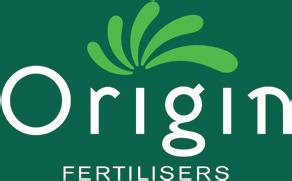



















rUpdate expected in coming weeks
THE Sustainable Farming Scheme (SFS) must be ‘taken forward together otherwise it will fail’.
That was the message from newly appointed Cabinet Secretary for Rural Affairs in Wales, Huw Irranca-Davies.
With nine months to go until the SFS officially launches, there were, by the Minister’s own admission, ‘knotty issues’ to grapple with and ‘many thousands’ of consultation responses to get through.
Many raised concerns that Mr Irranca-Davies’ unwillingness to pause the scheme meant he was not prepared to make significant changes.
But the Minister stressed it should not be interpreted that way and, given the scale of responses, he would be ‘surprised’ if there were not changes.
Mr Irranca-Davies said both the ‘detailed and the broad brush responses’ to the consultation would be reviewed.
He said he was keen to look into ideas to sequester carbon within soils and grassland, but he denied this implied a movement away from the controversial 10 per cent tree planting target.
“I have deliberately and very clearly





Farmer confidence in Wales’ new Cabinet Secretary for Rural Affairs and Climate Change Huw Irranca-Davies will come down to whether he can deliver change. Rachael Brown reports.
said we will reflect and engage with stakeholders before we design a scheme to take forward,” he said.
The Minister confirmed there would be an SFS update ‘within weeks’.
Mr Irranca-Davies laid the blame of

uncertainty surrounding SFS payment details directly on the doorstep of Westminster, adding Welsh farmers had been ‘betrayed’ by the settlement left from the withdrawal of the EU.
But despite budgetary constraints and questions about the scheme design, he said it was still ‘realistic’ to launch the scheme next January.
He added he was confident about take-up of the scheme, ‘as long as there is good will and trust on all sides’.
Mr Irranca-Davies said it could mean ‘not everything’ would proceed right at the same time and at the same pace, but that ‘delivering certainty’ with SFS was key.
“We need to agree on where we agree. On those areas where we do not have an agreement, we need to work rapidly to resolve them and be open to ideas,” he said.


TR MODELS (Rear, Front/Rear)
TL MODELS (Offset)
•
•
•
In recent months, Labour has distanced itself from the situation in Wales. In an interview with Farmers Guardian, Shadow Farming Minister Daniel Zeichner said Labour would not be introducing a similar policy in England.
In response, Mr Irranca Davies said he wanted to see ‘less brick bats’ being thrown back and forth, and instead ‘respect the fact that in post-devolution politics there is the ability to do things differently and learn’.
One issue where Welsh farmers would be looking across the border was bovine TB, with many arguing this was an area where Wales could take lessons from England.
Mr Irranca-Davies denied that bTB was being used as a ‘political tool’ and pointed towards the launch of the bTB technical advisery group (TAG).
“I am not going to tell the TAG group where they should be heading

to look at evidence – they are independent-minded,” he said.
When probed about whether he would support targeted culling if the TAG found enough evidence for it, he said he would not ‘pre-empt’ where the group would go, adding badger culling was not part of current Government policy but badger vaccination was.
In the last week, there have been warnings of further protests if change does not come.
While the Minister said he could not change whether a protest took place, he was concerned by the small minority at the last protest who said they wanted to put this ‘climate nonsense in the bin’.
He added that while his commitment to protecting the vitality of Welsh farming was ‘sincere’, he was not going to walk away from the need to tackle the climate and nature emergency.


LABOUR has set out plans to build houses on green belt land by loosening planning laws to create a new class of ‘grey belt’ land for low quality green belt areas.
Labour leader Sir Keir Starmer said his party was committed to a ‘brownfield first’ approach, but would create a new class of ‘grey belt’ land.
The category will include land which is ‘poor-quality scrubland, mothballed on the edge of town’, highlighting a dis-

used petrol station in Tottenham which was currently designated as green belt.
At least 50 per cent of housing development on these sites must be considered affordable, Labour said.
However, the party said it would rule out building on ‘genuine nature spots’.
CPRE chief executive Roger Mortlock said they had campaigned for a brownfield-first approach, more genuinely affordable housing and an end to speculative development.
“We welcome Labour’s support for these policies. There are enough ‘shovel-ready’ brownfield sites in the



UK for 1.2 million new homes – this is where we should start.”
However, he added the rhetoric was concerning.
He said: “The green belt is crucial to solving the climate, nature and food crises and it is protected by law for a reason. This new approach must be considered against this reality.
“We must also abandon the existing piecemeal approach and look at the green belt as a whole. If done badly Labour’s policy could permit landowners to run-down land for speculative development.”
Colin Brown, head of planning and development at Carter Jonas, said it was encouraging Labour was ‘at







least attempting to grapple with the green belt conundrum’.
“I absolutely agree that there are many sites designated as green belt which do not reflect the public’s perception of what the green belt actually is.
“There is also some logic in prioritising the use of ‘grey belt’ land where releases are needed to meet housing requirements. However, a future Government will have to use multiple levers to genuinely achieve a step-change in housing delivery,” said Mr Brown.
He added this included delivering some development on green belt land which does not neatly fit the ‘grey’ label, with difficult decisions needing to be made on housing.












Olivia Midgley, Editor – olivia.midgley@agriconnect.com

And finally... Gone are the days when you could buy a farm for £3,000, but our feature on P17 shows the pride and passion that has seen a family business evolve over the generations, with some stunning photography to boot.
YOU only have to talk to a neighbour or colleague, scan social media or read our brilliant In Your Field writers’ columns over the past few weeks to get a sense of the frustration felt by farmers right now.
Defra Secretary Steve Barclay would have been in no doubt about the seriousness of the situation facing agriculture and the desperation felt by many when he appeared in front of NFU Council members this week.
While the Secretary of State’s visit to Stoneleigh was a shrewd political play as the Conservatives turn up the dial in their bid to win the rural vote, it does show a willingness to listen and, hopefully, to offer some meaningful support. He is the first Secretary of State to attend the quarterly meeting in many years.
As NFU president Tom Bradshaw will have articulated in his private discussions with Mr Barclay, the industry needs cashflow solutions, not only now but to last the next 12 months.
While stemming the phase-out of Basic Payments, or at least paying out a proportion early as done in previous years, would be an obvious solution, this is not something that can be done


every time an exceptional weather event or food security crisis occurs.
There are levers the Government can pull in times of disaster, similar to the European Union’s crisis reserve fund, and perhaps now is the time for it to put in place structural financial mechanisms which can stand ready to give the industry a shot in the arm in times of need.
Despite farming’s shocker of a season being illustrated across national media almost daily, the paradox of high beef, lamb and land prices, alongside farmers’ concerns about the future of the industry, is almost unprecedented.
From the outside, it seems almost incomprehensible, but for those living it, they need a lifeline, and they are looking to the Government to act. With Labour snapping at the Conservatives’ heels, now is an opportune moment for them to show up to the table with a solution.
As the risk of empty shelves becomes more of a reality and with all political parties nodding to the importance of food security, surely now is the time for the Government to put its money where its mouth is.
‘There is a place for everyone in agriculture’
Background: Iwasfirstintroducedto thefarmingworldaround10yearsago whenImetmyfather,anarablefarmer.
Ihadneverembarkedonapathin theagriculturalindustry,becauseIdid notknowIhadaplaceinitbackthen.
WhenIwasreunitedwithmyfamily, mybrotherScottwelcomedmeto InverurieYoungFarmers’Club.
Tothisday,theclubisstillafantastic waytosocialiseandconnectwith thosefrombothfarmingandnonfarmingbackgrounds.
Iamveryproudtohaveseenthem engagingwiththewiderfarmingsector outsideScotlandandwhattheyare workingtoachievewithintheindustry.
However,fromanearlyage,my hearthadbeensetonacareerin veterinarynursing,whichIstilllove.My caringnature,towardsbothanimals andpeople,fitswellwiththejob.
‘Agricultureisinyourgenestoo’was
aphraseIhavetoldmyselfmorethan once.ThemoreIheardit,themorethat little‘agri-seed’withinmegrewcurious andeventuallyitbecameimpossibleto ignore.
IfeltIwasmissingoutonsomething veryinteresting—andveryimportant. Change: I received a phone call from the wonderful Jane Craigie last year with the offer of a careerchanging opportunity to join her rural communications agency, Jane Craigie Marketing.
Withouthesitation,Iaccepted. AyearonandIamnowworkingas accountexecutiveandtraineestaff writer,studyingafoundationcoursein marketing,whileremaininganRVN one-day-a-week.
Mynewcareerhasmeploughing intoeveryaspectofagriculture. Fromdesktofield,Imanageclient socialmediaaccounts,captureand

Lois Campbell editfilm,interview,writereleases,and gettoworkwithsomeamazingpeople involvedintheTurriffShow, FarmstrongScotlandandAgriScot. Icouldnothavebeenmorewarmly receivedbytheindustry.Ihavemet someofthemostinspiringpeopleover thepastyear,elevatedbytheirpassion andknowledge,alongsidemy colleaguesatJaneCraigieMarketing. Optimist: In a conflicting world where opinions and political rules
Turriff, Aberdeenshire Lois Campbell, 27, is a registered veterinary nurse who has transitioned into a career in rural communications with Jane Craigie Marketing.
change as quickly as the tide turns, farmers remain eternal optimists by adapting to their environment. Theyarecommittedtodoingtheir jobswell.
Ifitwasnotforthewonderfulpeople withintheindustry,Iwouldnotbe nearlysobravetodowhatIamdoing now.Ihavesomuchtolearnanditgets meexcitedeverydaytocommunicate theimportanceofagriculture.
Belonging: There is a place for everyone in agriculture — it is important we all find a way to support it.
MORE INFORMATION
If you would like to be featured, email chris.brayford@agriconnect.com
THE Government’s plan for ‘nature recovery’ is seriously flawed, with an increasing amount of predation from all directions.
We all commend the Government’s work and considerable taxpayers’ money for the sake of the environment we all live and work in, but if there is not serious management of all species that predate on all wildlife, this policy will fail.
All ground nesting birds are particularly vulnerable in this area, and numbers are declining due to predation, not poor habitat.
Traditional and historical management has become increasingly restricted in recent years, which is increasing the rate of decline and once some of these iconic bird species are lost, they will never return.
No system of management is perfect in everyone’s eyes, but the problem of predation needs addressing now, before it is too late.
Stephen Ramsden, Harrogate, North Yorkshire.IN most UK families a child will sit down at the table and wait for food to be put in front of them, not giving a thought as to how hard their parents had to work to earn the money, do the shopping, prepare the food and wash up afterwards.
This is much the same attitude described by Glyn Lucas, senior auctioneer at Harrison and Heth-
■ IF you would like to send us a letter for consideration, please note that our email address has now changed to fgeditorial@agriconnect.com



erington, in his article (It is time for a political overhaul, FG, March 22) , except that he is describing the naive attitude of Government in taking it for granted there will always be food on the table for the population.
Farmers know more than anyone how fragile and weatherdependent the food supply is and that farming cannot be switched on at the drop of a climate catastrophe or trade-disrupting international conflict.
Gillian Herbert, Linley Green, Herefordshire.I NOTE Tesco’s profits have increased vastly, to £2.3 billion before
FARMERS Guardian’s story ‘Farmers must get greater help to measure methane on-farm, say experts’ attracted dozens of comments online. Here are some of the most popular Facebook posts:
■ “The same amount of methane is produced if the grass is left in the field to rot as is produced if that grass goes through an animal.
“How much methane is produced from all the leaves that fall off a tree and rot?
“How much CO2 has all that grass and leaves removed from
tax (Tesco profits highlight unfairness in supply chain, says Ulster Farmers’ Union, farmersguardian.com) .
Do we expect the NFU to make a strong public statement that these excess profits should be allocated
the atmosphere in the first place? Look at the bigger picture.”
HUW CAUNTER
■ “First find out how much methane is produced. Then tax it. If any farmers go along with this protocol they need their heads looking at. Tell the experts to jog on and leave farmers alone.”
STEPHEN GOWENLOCK
■ “They should concentrate more on how much pollution comes from all the planes every day, but they will not do that.”
CLIVE HODGE
more equally between Tesco’s suppliers and sellers? Thought not.
Richard Smith, Mancetter, Warwickshire.
site we may also collect some technical information about how you use our site, for example, the type of device you are using, your operating system, IP address, uniform resource locator (URL), clickstream and length of visit. How we use the information you provide: We will use your personal information: • to administer the Competitions, on the basis that the use of your personal data for this purpose will be necessary to enter you into the competitions and, if you are successful, contact you to notify you of your prize; and, • if you are new to Farmers Guardian and where you have agreed to this, to provide you with news and updates from time to time about our services; and, if at any point in the future you do not wish to receive any news and updates from us or from, you can unsubscribe from our marketing list at any time by following the steps below. To unsubscribe from any communications using the link on the email we send you or by emailing us at dataprotection@farmersguardian.com. We will not use your information for any purposes except those listed in this policy without letting you know and getting your permission, if necessary, first. Who do we share your information with? We will not disclose your information to any third parties without your consent, except where:
• it is necessary to enable any of our staff, employees, agents, contractors, suppliers or commercial partners to provide a service to us or to perform a function on our behalf;
• we have a legal obligation to disclose your information (for example, if a court orders us to); or
• there is a sale or purchase of any business assets, or where Farmers Guardian or any of its group companies are being acquired by a third party. Where we use third parties as described above to process your personal information, we will ensure that they have adequate security measures in place to safeguard your personal information. For how long do we keep your personal information? We keep your personal information for 36 months for the purposes for which it was collected or for any period for which we are required to keep personal information to comply with our legal and regulatory requirements, or until you ask us to delete your personal information. Your rights: You have a number of rights in relation to your personal information. These include the right to: • find out how we process your personal information; • request that your personal information is corrected if you believe it is incorrect or inaccurate; • obtain restriction on our, or object to, processing of your personal information; • ask us not to process your personal information for our own marketing purposes; and





AS prices reached new highs, tight supplies were expected to support the lamb market for much of this year.
There was an all-time record AHDB deadweight lamb price in the week ended April 13, at almost 851p/kg; 33.8 per cent more than the same point last









There was an alltime record AHDB deadweight lamb price in the week ended April 13, at almost 851p/kg.


year, and more than double where it was at the end of 2019.
Isabelle Shohet, red meat market analyst at AHDB, said: “The revised






estimated carryover for 2024 of old season lambs is now 4.1 million head from January to May, which is a decline of 185,000 head or 4.3 per cent compared to 2024.
“The predicted number of new season lambs to be slaughtered in the first six months of the season has fallen from our previous estimate to 1.57m head – a decline of 82,000 head from the same time in 2023.”
An estimated 6.4m lambs were to be slaughtered during the second half of 2024, which was an increase of 0.8 per cent compared to the same period in 2023.
Adult sheep slaughter numbers were expected to drop by 3 per cent, following a steep decline in numbers over the first few months of the year.
AHDB estimated that total UK sheepmeat production would fall
by 1.4 per cent to 282,000 tonnes for the whole of 2024. That figure would be the smallest annual output in Defra records, which go back almost 40 years.
Prices have also been breaking records in the auction ring. Reporting on last week’s sheep sale in Ashford, Kent, auctioneer John Rossiter of Hobbs Parker said: “Yes, I will admit it, I was wrong again. I thought we had hit the top of the trade in the last two weeks and, despite the huge prices already achieved, they lifted another 50p/kg on last week.
“A truly phenomenal trade throughout, with a slightly smaller entry but with a lot more quality on offer – genuine finished hoggets selling to £320, £300, and £282, with the overall average on the day a staggering £199 head for all sheep sold.”























A SLOWDOWN in food inflation was credited with driving down general inflation, but for many products retail inflation is still much higher than farmgate inflation.
In a basket of 11 goods regularly monitored by Farmers Guardian, the retail price was lower in March this year than March 2023 for four products, according to calculations from the Office for National Statistics (ONS). That contrasts with a fall in six of the nine farm products used to make those retail goods.
The price of a pint of milk has fallen by 7.1 per cent over the year and Cheddar prices were down 10.6 per cent, but milk prices fell 20.8 per cent.

Meanwhile, shoppers were paying 12.6 per cent more for their pork chops, but farmers were getting 0.9 per cent less for pigs.
The bread price also edged up, while milling wheat prices were 14 per cent lower. Wholesale carrot prices in March were 17.5 per cent less, while retail prices were 19 per cent higher.
Farmgate inflation outstripped retail inflation for lamb, with March deadweight prices 47.3 per cent higher than March 2023, but retail prices were only 4.7 per cent higher.
Egg, beef mince and apple farmgate inflation was higher than retail inflation, but the 1.4 per cent rise in deadweight steer prices was less than the 3 per cent increase in beef steak prices.
The figures are based on ONS inflation data and monthly farmgate or wholesale price data as calculated by

This week Asda announced a 24 per cent increase in 2023 earnings before interest, taxes, depreciation and amortisation.

AHDB (milk, cattle, sheep, pig, wheat and barley prices), Defra (wholesale fruit and vegetable prices) and the British Free Range Egg Producers Association.
While concerns over farm profitability increase, supermarkets are reporting bumper results. This week Asda announced a 24 per cent increase in 2023 earnings before interest, taxes, depreciation and amortisation, to more than £1 billion. Total sales for the year were 7.1 per cent higher

at £21.9bn, with like-for-like sales up 5.4 per cent.
Keeping consumer prices under control is a key strategy for the retailer, according to co-owner Mohsin Issa, adding it was investing in price and quality.
In media interviews, Mr Issa claimed Asda’s relationship with suppliers was at an all-time high. Asda’s market share has been eroded by competitors over the last few years, down to 13.4 per cent from 17.3 per cent a decade ago, according to Kantar.




UK dairies are more closely focused on the liquid market than other countries in Europe, which has implications for farmgate milk prices. Cedric Porter reports.
rNon-aligned prices dropped by 10.6ppl
UK MILK prices lag behind many other European countries, with some of the biggest falls in values over the last year.
The average milk price for a group of EU and UK dairies in February was €43.98 (£37.96)/100kg, according to the Dutch dairy sector organisation and the European Dairy Farmers association. That was 15 per cent less than in February 2023.
The average for the 12 months to the end of February was €42.90 (£37.02)/100kg. The prices are for

manufacturing and not liquid use.
The only UK dairy on the list of 16 dairies is Saputo. In February, its price was €42.59 (£36.76)/100kg, ranking it 12th out of the 16 dairies, which was 3.2 per cent lower than the overall average.
The 12-month price was 2.6 per cent less than the overall average at €41.78 (£36.06)/100kg. The price had fallen 23.1 per cent over the year – the second largest drop after Hochwald Milch in Germany.
Taking into account the currency difference and expressed in euros per litre, the average UK milk price

Powerful mixing augers with adjustable knives ensure thorough mixing of all types of feed, including bales. Gentle mixing, consistent ration quality.

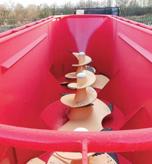
in February according to Defra was 43.69 euro cents per litre (38ppl), with the 12-month average at 42.55cpl (37ppl). Arla UK’s February price was higher than the European average at the equivalent of 45.8cpl (40ppl), but it had fallen at a faster rate of 16.7 per cent in the previous year.
Soumya Behera, senior dairy analyst at AHDB, said: “The different structure of the UK dairy industry compared to many other parts of Europe has an impact on milk prices.
“The UK is unusual in that 60 per cent of the milk sold is for liquid use rather than manufacturing, which is a much higher proportion than other European countries.
“Alignment and contracts can protect sellers from a volatile dairy market. Over the last year, we have seen UK-aligned prices fall by 7.3ppl on average, but the drop for nonaligned sales has been 10.6ppl.
“Other reasons for higher European prices include higher costs of production because of more indoor systems. Meanwhile, countries outside Europe, such as New Zealand, that are exposed to global markets can experience more market volatility.”
Lower prices and new regulations could change the face of European dairying, with reduced output in some of the larger and more established milk producers. In January (latest available EU figures), Ireland
The UK is unusual in that 60 per cent of the milk sold is for liquid use rather than manufacturing
SOUMYA BEHERA
produced
152,880 tonnes of milk; a drop of 17.7 per cent on the January 2023 figure. Irish production in the year to the end of January was down 4.5 per cent to 8.677 million tonnes.
French production over the year was down 2.6 per cent, with a yearon-year decline in German and Dutch output during January.
Overall, EU production in the 12 months to the end of January was down 0.1 per cent to 144.355mt.
“The difficult autumn, winter and spring has hit Irish milk production over the last few months,” said Ms Behera.
“But there does seem to be some longer-term factors at play that are limiting European production, including new nitrate and other environmental regulations.”
There was evidence of a shift in production eastwards. Romanian milk output increased by 5.5 per cent


over the last year to 1.144mt, with Polish production up 2 per cent to 13.051mt and Estonian production 7.2 per cent more at 802,000t. Belgian, Latvian, Portuguese and Swedish production also increased.
Over the same time period, UK production fell 0.1 per cent to 14.855 billion litres. The average Polish farmgate milk price in February was €47.65 (£41.12), according to Italian dairy consultancy CLAL –that was only 0.8 per cent less than the year before.
“There has been consolidation and investment in larger herds in countries such as Poland and Estonia which has increased national output, but that might come at the cost of reduced output by smaller herds,” said Ms Behera.

ENGLISH and Welsh Agricultural land prices rose 1 per cent over the first three months of the year to a record £22,857/hectare (£9,250/ acre), according to property consultancy Knight Frank, which has been tracking the market for 80 years.
The latest figure represented a 6 per cent increase over the year,
outperforming the 4 per cent increase in the FTSE 100 share index and the 1 per cent increase in UK house prices. Of the major asset groups, only gold fared better, with an 11 per cent increase over the year.
Land and gold are often seen as safe havens in turbulent economic times.
Andrew Shirley, head of rural research at Knight Frank, said: “The
farmland market has remained remarkably resilient amid economic headwinds.
“Our research highlights that low supply volumes combined with strong demand from a wide range of buyers, including those looking to participate in environmental schemes, are supporting prices.”
He added that the Government’s
Fertiliser applications for first cut silage have been significantly hampered by the weather this spring. The poor weather conditions have led to unfavourable soil conditions, resulting in delayed or reduced slurry and fertiliser applications. This situation is particularly concerning as these first cuts constitute a large part of next winters forage.
Keep in mind that grass will start to head out at its usual time. Although extending the first cut growth period might increase grass silage yields for some, it’s important to note that this could lead to lower D-value and reduced intake potential of the silage. Also, the regrowth for second cut will be slower, meaning that although you will gain extra yield on the first cut, you will lose out on first cut silage quality and second cut yield.
clarification that land enrolled in environmental schemes did qualify for agricultural property relief had reassured landowners.
He expected that the upcoming General Election might slow down market activity, while reducing direct supports and lower commodity prices could keep land prices in check.
with Philip Cosgrave Agronomist, Yara UK Ltd.
As we approach early May, check the base of the sward for dead/ decaying leaf and stem material. What happens at the base of the sward has a significant impact on feed value, comparable to seed head emergence. This dead or decaying material may be the result of waterlogging or the wet conditions, especially in fields with heavier grass cover. If dead material is present at the base, consider cutting sooner rather than later.
Finally, if mowing in early May, be careful that field conditions have improved enough to minimise soil contamination by machinery operations, particularly raking.
DANISH Crown has been found guilty of using misleading climate marketing by using the expressions ‘climatecontrolled pig’ and ‘Danish pig is more climate-friendly than you think’.
In March 2024, Danish Crown was convicted by the Western High Court in Denmark of greenwashing as it could not document the accuracy of the labelling scheme ‘climate-controlled pig’.
The Vegetarian Society of Denmark and the Climate Movement Association, who brought the case, subsequently chose to appeal the claims on
which the court did not support them to the Supreme Court.
On Friday, April 12, Danish Crown notified the Supreme Court and posted a statement on the company’s website where it acknowledged that the groups were also correct on all of the remaining charges, and so admitting to misleading consumers in a major campaign.
Danish Crown accepted it did not comply with the requirements of the marketing law, and accepted a ban on using these statements.
It said: “Since the lawsuit was initiated, we have emphasised that it is crucial for us and the rest of the business world to be able to communicate our climate actions in order to differ-


entiate ourselves and make climate effort a good business – and we still believe this.
“At the same time, the long and thorough process in the Western High Court has led to both healthy reflections and a useful debate about the boundaries when a company needs to communicate about sustainability.”
It said it had learned from the lawsuit.
“We now wish to look forward and instead focus our efforts on transitioning to a less climate-impacting production. In these efforts, we will naturally communicate about our climate actions within the framework of
the Western High Court’s decision and this affirmative response to the plaintiffs’ other claims,” it said.
“This means that we will also continue to communicate about our climate actions in Danish Crown, but, of course, with great attention to ensuring that the promotions in our marketing reflect the guidelines that have been clarified in connection with the lawsuit.”
The Climate Movement and the Vegetarian Society of Denmark said they were pleased Danish Crown was now conceding saying it was a significant step in stopping ‘greenwashing’ in Denmark.


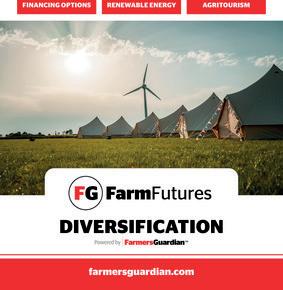


Farmers Guardian delivered directly to your door every week including full digital access. Plus, check out our brand-new features exclusive to Farm Futures members. A one membershipyear is only £289 Insight – Quarterly, in-depth, analytical reports into the latest agricultural trends. Recent topics include, diversification and low carbon agriculture Exchange – A series of digital events focused on learning from real case studies and exchanging knowledge with agricultural thought leaders Weekly Digest email – From the desk of FG’s editor every Sunday morning, discover exclusive insights which impact the business of profitable farming Members’ Lounge – Enjoy an exclusive space for members to network at leading events, such as LAMMA, CropTec and Farm Business Innovation.





 Edited by Angela Calvert
Edited by Angela Calvert






















The Amsden family, who farm near Hawes, have looked to the British Limousin breed to improve the quality and profitability of their hill farming enterprise. Katie Fallon reports.
In the heart of the Yorkshire Dales, overlooking the traditional market town of Hawes, East Shaw Farm is home to fourth generation farmer David Amsden, who farms together with his mother Alice, wife Samantha, and their two children – Esther (five) and Elizabeth (three).
East Shaw Farm was once home to a small dairy herd, and David’s great grandparents were originally tenants on the farm before his grandfather purchased it for £3,000 in 1948.
Alice says her father milked cows until 1974, when bulk milk tanks came in, prompting him to leave dairy and go into beef.
After studying for a degree in agri-food marketing with business studies at Harper Adams University, and working as a buyer at the supermarket retailer Morrisons and then at the Navy, Army and Air Force Institutes, David returned home to the farm in March 2020.
However, before coming back to the farm full-time, David and his
sister, Lydia Sunter, went into business together, buying the fish and chip shop in Middleton-in-Teesdale, Co Durham, in 2012.
David says: “It was a five-year plan to turn the business round, sell it and re-invest the proceeds into East Shaw, but 12 years later Lydia is still successfully running the business.”
David came back to the farm fulltime just three weeks before the Covid-19 pandemic began.
He says: “Having seen the bright city lights, I realised that farming was for me; I love the Yorkshire Dales and my Limousin cattle.”
Today the family run a herd of
50 pedigree Limousin cattle under the East Shaw prefix, a 30-head commercial suckler herd and a flock of 500 Swaledale ewes across a total of 243 hectares (600 acres) of grassland, in-bye pastures and fell ground.
The farm is run across three holdings, including East Shaw Farm, Litherskew Farm, Hawes, and some grazing land at Redmire, with grazing rights on Staggs Fell and Wether Fell.
The family began to keep pedigree Limousins more than 20 years ago, when Lydia received a Limousin
heifer calf from Carlisle auction market for her 16th birthday.
Alice says: “The heifer was called Rombolds Sophie, sired by Dauphine.
“It was that calf along with another heifer, called Beck Vivien by Mas Du Clo, which were the foundation cows and their bloodlines still dominate the herd today.”
David says: “We could not have a herd of pure Limousins overnight without buying-in some cows, but we also concentrated on the cows we already had.
“We wanted good-natured, easy-calving cows with plenty of milk and good locomotion. The

farm is 1,200 feet above sea level, so our animals must be hardy.” Always working to improve the quality of their cattle, a number of cows are artificially inseminated using a selection of Limousin bulls including Huntershall, Haltcliffe, Wilodge, Ampertaine, Mas Du Clo and Sympa bloodlines.

Two home-bred stock bulls are also used; a Wilodge Vantastic son and another by Ronick Hawk.
David says: “For us, it is about trying to get a balance between having a cow that can calve a shapely calf and feed it.”
Mainly operating as a closed herd, David recently bought three


heifers to introduce new bloodlines, two of which have been flushed, with their embryos transferred into commercial cows to increase pedigree cattle numbers.
David says: “We tend to put embryos into older recipients, which is quite unusual, in the hope they will calve easily and feed their
calves well. We have also recently flushed our home-bred heifer East Shaw Rglenda, which has been successfully shown at the Great Yorkshire Show and Wensleydale Show.”
To assist with the all-year-round calving system, a purpose-built calving shed was put up seven




years ago, which includes 18 individual calving pens.
David says: “The cows are brought into the calving shed three weeks before calving and stay here for six to eight weeks after calving. “It is a quiet space for bonding and, with haltering all our cows, they and their calves are easy to handle.”

Alice says a good temperament is vital, so therefore genetics and handling are key.
She says: “People buy breeding stock from David as they know they will be quiet cattle.”


gimmer lambs are also sold at Hawes, with a proportion sold privately on-farm.”



A selection of heifers are retained annually for breeding, with about 25 pedigree bulls and 20 heifers sold for breeding either through Leyburn auction market or privately on-farm.
Store heifers are usually sold at 12 months old, and bulls between 12 and 17 months old.
The cattle are fed a diet of homegrown baled silage and rolled barley during winter, before being turned out to graze pastures during summer.
David says: “We tend to sell store cattle in the ‘feeding section’ of the sales at Leyburn, as most farmers wanting a bull will buy from this sale ring and pay substantially more than feeding price for a good-quality, quiet bull.”
Alongside the beef enterprise, the family also run a flock of 500
■ 243 hectares (600 acres) of grassland, in-bye pastures and fell ground
■ Flock of 500 Swaledale sheep, selling 300 Mule gimmer lambs annually
■ Herd of 50 pedigree Limousins
■ 1,000 round bales of silage made annually
■ 25 pedigree breeding bulls sold each year, privately and through Leyburn auction market
■ Supplying beef and lamb to Middleton-in-Teesdale fish and chip shop
Having seen the bright city lights, I realised that farming was for me; I love the Yorkshire Dales and my Limousin cattle
DAVID AMSDEN
Swaledale sheep, with 200 ewes put to the Swaledale ram to breed replacements and 300 put to the Bluefaced Leicester rams to breed North of England Mule gimmers.
There are 10 pedigree Bluefaced Leicester ewes which are also used to breed Bluefaced Leicester rams to use within the flock.
David says the ewes and lambs graze the pastures and in-bye land, with hoggs and any geld ewes kept on the fell during summer, before being brought down for tupping in September.
He says: “We were in a scheme where we had to winter the sheep off the fell, and after a few years the sheep lost their hefts, so we have kept most of them off the fell ever since.”
Lambing starts in February, with everything lambed inside.
David says: “We lamb early to get the Mule wethers to market before the price drops. We usually sell at Hawes auction market’s spring sale of lambs at the start of June.
“Additionally, most of the Mule
Any Swaledale ram lambs not suitable for breeding are sold deadweight, with a selection retained each year to be sold for breeding at the Swaledale Sheep Breeders Association ‘B’ district ram sales at Hawes the following autumn.
A handful of cattle and surplus lambs are also used to make beef and lamb pies which are sold through the fish and chip shop, now run by Lydia.
David says: “When we first took over the chip shop, the quality of pies that were available at the time were not great, so we thought we would try and make our own using the beef and lamb we produced on-farm.”
Earlier this year, the family gained national recognition for their pies after Lydia won supreme championship at the British Pie Awards with a minted Wensleydale lamb and potato pie, using lamb produced at East Shaw Farm.
Since returning to the farm, David has been focused on improving the quality of stock across all enterprises, increasing prices in the live ring and securing a premium for breeding animals.
He says: “My long-term goal is to continue improving the genetics of the herd and transition to a full pedigree Limousin herd, selling more quality breeding animals.
“I really believe in the British Limousins.”
“We may look at diversification in the future, but that is on the back burner for now as the farm and the stock is the priority. Most importantly, the farm is a great place to raise a family.”




David Shelton, who runs a mixed operation comprising 650-head of finishing beef, 230,000 broilers, bed and breakfast pigs, a 20-hectare (50-acre) solar farm and combinable crops across 890ha (2,200 acres) in Leicestershire, is constantly driving his business forwards. Olivia Midgley finds out more.
David Shelton, who supplies Morrisons, is one of the retailer’s ‘top 50’ Sustainable Beef and Lamb Scheme producers and last year was named Sustainable Farmer of the Year at the British Farming Awards.
But never one to stand still, he is pressing ahead with his goals of becoming net zero and has made a number of developments in the last six months.
Mr Shelton said: “Since winning the award in addition to farming traditionally to improve soil organic matter with farmyard manure and cover crops, we are currently looking at applying biostimulants to farmyard manure and chicken manure to make more use of nutrients.
“We are also looking at application of potash and phosphate from the residue of burning poultry manure in power stations. We have invested in soil nutrient mapping and variable rate inorganic fertiliser application.
“On the livestock side, we are looking at improving health status and sourcing of boughtin beef cattle to finish at a younger age. Finishing at 370kg deadweight and reducing days to slaughter therefore improves emissions.”
Mr Shelton appeared on a Farmers Guardian Farm Futures digital round table back in November, where, alongside experts from Lloyds Bank, the Agricultural Industries Confederation and the bioenergy and anaerobic digestion consultants NNFCC, he talked about opportunities for farming businesses to improve their sustainability credentials.
“I cannot stress enough the importance of collecting data,” he told the event.
“On the beef side, we buy-in cattle which finish between 18-28 months at similar deadweight.
“By regular weighing you can see which animals are performing better and are most suitable for the system.
“Genetics and breeding are going to have a lot to do with reducing emissions [in livestock] in the future.”
By running a mixed enterprise, he feels he is able to get close to net zero goals.
“I do not think we will get there purely on beef alone, but certainly by mixing all the elements together with woodland, environmental creation and renewable energy we are heading in the right direction,” he added.





A true pioneer, Mr Shelton, who formerly owned, floated and sold major car retailer Motorpoint, urged other farmers to make changes, however small they think they might be.
“I would like to say to any entrants for the awards to keep an eye on ongoing research into farming sustainably and carbon capture plus emissions reduction. Do not be afraid to try
XNSF partners with farmers to ensure the quality of their produce, providing a comprehensive suite of food safety and quality services spanning from farm to fork. Our farm assurance scheme covers food safety, animal welfare, traceability, provenance and environmental protection, assuring consumers the
new practices and techniques to improve sustainability,” he said, adding winning the honour had been a big boost for his team and family.
“I was absolutely thrilled to be recognised for all the effort my team has put in. They have taken on board all the practices we have implemented in our quest to achieve carbon neutrality by farming sustainably.”
food they eat is safe and responsibly produced. With more than 30 years of experience, NSF is a leading inspection and certification body for Red Tractor, delivering assurance and certification services.
Succession planning and diversi cation are at the heart of Bluebell Dairy in Derbyshire. Rachael Brown reports.
The Brown family have been milking their herd of Holstein Friesian cows at Brunswood Farm, Derby, since 1953. But in 2007 they embarked on a new venture, in search of a way to preserve the tenanted farm for future generations, while also ensuring their herd could continue producing its wonderful creamy milk.
The answer was becoming a micro dairy, milking 25 cows to produce artisan ice cream on-site for their customers.
Located on the eastern edge of Derby, outside Nottingham, with millions of customers within an hour’s reach of the farm, the business has grown from strength to strength over the last 17 years.
The farm has its own ice cream parlour, cafe, and play park, with its latest attraction the ‘Cow Palace’ proving a hit among visitors, with hourly milking demonstrations using a robot.
Owner Rosemary Brown said: “The cows, the ice cream, and the milk from the farm is central to the whole enterprise. We bear that in mind, whatever we are doing.”
But the motivation behind diversifying has always been family sustainability, with Rosemary’s son and daughterin-law running the business alongside her and her husband Geoff.
“When we started Bluebell, our
plan was to create a sustainable business, because as a dairy farm on its own it was not going to thrive,” she said.
After 35 years, Rosemary and Geoff have moved out of their farmhouse, enabling their son and his wife to move in.
“We are seeing our succession policy happening,” said Rosemary.
Rosemary said the decision to diversify from the farm’s traditional dairy roots was initially a ‘really tough one’, but for the family business to move forward and to stay at the farm, it was a change that needed to happen.
As a family, they have invested heavily over the years, with one of the biggest costs being infrastructure and putting up new farm buildings.
Rosemary said: “The last 12 months have been particularly challenging in terms of costs to the business – utility bills have been huge.”
The family are hopeful that installing solar panels will fuel ‘most of the energy requirement on the farm’, but the process –including planning – has taken ‘over 18 months’.
Looking to the future, the Brown family are exploring putting in a ‘larger indoor play facility’, but Rosemary said the main aim was to ‘fully understand their customers again’ in a post-Covid-19 world.
She said winning the Family

Farming Business of the Year award was something they were ‘really proud of’.
“I was sat next to the Farming Minister, and I introduced myself

as a farmer, and I said that we are winners of a British Farming Award. It gives you a lot of credibility, and the confidence that what you are doing is right,” said Rosemary.
X Entered into the Sustainable Farming Incentive FARM FACTS
X Second year of Natural England Mid-Tier Countryside Stewardship scheme
X Micro dairy with 25 cows in milking herd and 150 followers
X Changed grassland to herbal leys
X Invested in solar panels
XGoodyear Farm Tires is a premier European agricultural tire brand with a 120-plus-year heritage. Trusted for generations, we are dedicated to enhancing farm productivity.
Our mission is to improve crop yield by offering farmers a range of high-performance, durable, and
value-driven agricultural tires. The line-up includes 85, 70, 65, and XL series Tractor Drive Radials, alongside specialised designs for sprayers, harvesters, and industrial applications.
Splitting his time between the family’s mixed beef and arable farm, guest lecturing and researching at the Royal Agricultural University, advising on farming policy at Defra and his entrepreneurial seasonal business, Dr Henry Webber enjoys maintaining a host of varied job titles.
He says: “When you have lots of little jobs, you have to have a fair bit of flexibility to be able to be on the farm during the busier times such as harvest or when the weather is good, but likewise if another job avenue becomes busy, being able to adapt is fairly important.”
When Dr Webber was growing up on the farm, he says he was always interested in history and the natural world.
“I decided not to go to agricultural university as I felt like I had got quite a bit of experience because I had grown up with it, so instead I went to Bristol University to do archaeology,” Dr Webber says.
He stayed at Bristol to complete both a masters degree and PhD and was able to merge his interest in farming, with his interest in history.
“I enjoyed archaeology and learning about both history and soil, so I decided to merge it all,” he says.
Dr Webber’s PhD studies were focused on how archaeological sites impact current soil variability, and




With interests in farming, history and research with added entrepreneurialism, Dr Henry Webber spoke to Ash Ellwood about how he has managed to combine his passions.
how that could be incorporated within precision farming techniques.
“Where there had been an old Roman villa site in the middle of a field 2,000 years ago, typically that would mean people and livestock had been there and you still can see [the effects of that] in the soil.
“You can sometimes find double the

amount of phosphorus in the soil in that patch, just because of the archaeology and the history that had taken place there.
“The premise of my PhD was, if we know where all of the archaeological sites are across the country, this information might be able to help nutrient management and precision application of fertilisers.
“But also, the other way around, if you have got precision farming techniques, drones and satellites looking at crop variability, can we actually explain some of those variations by understanding the archaeology,” he says.
Fast forward to the present day and Dr Webber spends part of his week on his family farm in Essex and the other part working part-time for Defra as a Senior Policy Adviser in the fertiliser team.
He says: “[Working at Defra] is an interesting role that is completely different from day-to-day work on the farm.
“It helps to widen my understanding of how decisions made at the
national policy level and the impacts on real-world situations, both on farm and with local landscapes.”
At the family farm, Dr Webber is involved in all aspects of the arable enterprise, which comprises 120 hectares of combinable crops including Group One milling wheat, beans, millet, and grassland on a flexible rotation.
The farm is split into three blocks with the furthest taking roughly 40 minutes by tractor to get to, with two sites based predominantly on heavy clay soil types and one on glacial till.
The farm is a mixed enterprise which, within the past 10 years, has also included a pedigree suckler herd of South Devon Cattle.
“We wanted to bring some beef cattle back onto the farm, mainly for breeding purposes and those that do not make the quality for future breeding, are sent to slaughter for beef,” says Dr Webber.
A further diversification to make use of a range of older livestock buildings is an equine livery yard which includes 30 stables, with clients


boarding horses at the farm on a ‘DIY’ basis.
“Some of the buildings are old turkey sheds which is where I got an inspiration for my own business, because we used to sell turkeys from the farm at Christmas time, but not anymore,” he says.
Dr Webber’s diversification stream is a personal venture that originally followed on from selling turkeys at Christmas from the farm gate.
“I guess it is one of those things, when you are on the family farm, you want to have your own enterprise to help with succession planning and generational change as it occurs.”
“I think it is always pretty important that people have something that they can manage, own, decide on and experiment with,” he adds.
The seasonal enterprise is the sale of mistletoe trees, selling roughly 150 trees per year for the past 15 years with his winter being the busiest period for the diversification, often when the farm tends to be within its quieter period.
“It is actually a nice little diversifica-
tion, because it is mostly winter-based so during the spring and summer, apart from keeping the trees happy, you do not tend to get that many orders, but during the winter months I will be delivering quite a few trees out and about over the country or packaging them up and posting them to people,” says Dr Webber.
Mistletoe is classed as semi-parasitic; Dr Webber sells a host tree, often a common crab-apple, that has been pre-germinated with mistletoe berries, to enable the customers to plant the tree and have active mistletoe growing so people can pick their own from the garden.
“I buy host trees at various ages, growing them for two or more years and then I will plant four or five mistletoe berries or seeds on each tree.
“It is quite a slow process, as once the seeds are planted on the tree, it takes a year and a half for the mistletoe seeds to germinate through the bark,” he says.
Once the seeds are planted on the host tree, the seed creates a shoot that secretes enzymes that penetrates the outer bark layers of the tree.
Eventually the seed head drops off,
leaving a green shoot protruding from the bark. Eighteen months to two years later, a green leaf appears from the shoot and the trees are ready to sell, he says.
“Once I know the mistletoe is growing, the trees can be planted out instead of being in the grow bags that I keep them in for the duration of the time they are with me,” adds Dr Webber.
The main input associated with the trees is irrigation, but he utilises techniques such as shed roof water collection to cover some of the water requirements.
He says: “As the trees are grown in bags above ground, it makes it a lot more work from a watering perspective.
“Although, it is a lot easier when it comes to selling them, otherwise we would be removing them from our heavy clay soils which would be much more challenging.”
Dr Webber is a research fellow at the Royal Agricultural University based in Cirencester which consists of guest lecturing, regular teaching and a
couple of different research projects.
“I really liked the blend of academic research and practical implementation, as you can research the fundamentals of an idea by reading papers, but then you can test out and experiment with the idea on farm which is something I am really interested in,” he adds.
One of Dr Webber’s current research topics is looking further into mistletoe, working with the University of Essex.
“I am doing a bit of research on mistletoe – looking into how it grows, but also investigating the potential of using mistletoe as a bio-adhesive or a biological super glue.
“This is because the mistletoe berries are so sticky and will stick to anything. Even when they are wet, they will still stick, but they are completely biodegradable.
“In certain areas, such as medical, there might be a use for a type of glue to work inside the body where it will break down into organic compounds.
“That sort of thing I always find so interesting and it is blending farming and production with research and development,” says Dr Webber.
Alongside 120 hectares of arable ground, the mixed enterprise also farms a pedigree suckler herd of South Devon cattle.

On lighter soils, crops are making good progress, with completion near for some growers.


rPlanting progress despite wet soils
By Jane ThynneAS April draws towards a close, some growers on lighter sandy soils are reaching the final stages of their spring drilling campaign. However, growers with a heavier soil type are still struggling with wet soil conditions.
Mixed farmer based in Whittlesford, Cambridgeshire, Charlie Deller, says despite the continued months of rainfall, spring planting has been completed as planned.
He says: “We are on very light ground and it takes a lot for us not to be able to drill. In a normal year, we would usually have been worried about drying out [too much] by now. We have just managed to get the last bit of our spring barley in.”
Mr Deller says that this season’s spring drilling has benefited from an early sugar beet harvest in 2023, which, in his area, saw the entire crop lifted in October.
“With the sugar beet gone so early, we were able to get winter wheat in behind that.
“I think if all of that ground had been waiting for spring barley, we could have been in trouble. But we managed to get 100 acres [40 hectares] into wheat rather than stuck with spring barley which I do not think we would have got done.”
Aside from slightly increasing winter wheat seed rates, the team had largely stuck to average seed rates.
However, the farm had invested in a power-harrow combination drill following the wet autumn.
“We would never have got on some of the land with our usual tine drill,” he says.
“Where we are [in the country], we are used to drier often and often drought-like conditions.
“We have rolled everything now to keep the moisture in, basically we just have to hope the weather is kinder – that is about all we can do.”
It was a case of ‘better late than never’ for Ben Cooper, who farms Pewsey Vale in Wiltshire.
“We have finished [spring planting] just this week,” Mr Cooper says.
“It is a lot later than we had hoped for, being more than a month later than planned and it is not in beautifully, but it is in.”
Mr Cooper has managed to drill 80ha with Laureate spring barley, while a further 26ha was originally planned to be drilled with Canyon spring oats, but due to a seed shortage, the area was instead drilled with Merlin spring oats.
The general shortage of spring seed has also prevented Mr Cooper from increasing the seed rates by any significant amount.
He says: “It is slightly higher at about 9kg per acre [22kg/ha] and a bit more for the oats. But there was not a lot of seed around.”
Owing to the weather, Mr Cooper says nothing had been direct drilled this spring.
“We ploughed or at least cultivated everything – we had to.
“I honestly think for people who have not moved the ground, their crops this year are not going to be good.”
While drilling has been completed on his own farm, Mr Cooper
I tried ploughing [the fields] last week and had to stop as there was brown water coming into the furrow
COOPER
says he still has roughly 20ha of organic spring oats to drill into contracted land.
“Those fields are just far too wet,” he says.
“I tried ploughing [the fields] last week and had to stop as there was brown water coming into the furrow.
“So now, I am hoping to start at the end of next week, if the weather holds,” says Mr Cooper.
HI-TECH optical sensors in fields could provide an effective means of monitoring beetle numbers arriving in oilseed rape.
Results from a new study comparing standard monitor methods with optical sensors show increases in pollen beetles two days ahead of water traps and four days ahead of plant counts. In terms of early detection and numbers of beetles recorded, it is the most efficient pollen beetle monitoring method, according to researchers.
Prof Emily Bick, of the University of Wisconsin-Madison, who led the study alongside scientists from Rothamsted Research, FaunaPhotonics and the University of Copenhagen, says: “The pollen beetle is a significant pest of OSR at budding stage. Many farmers
in western Europe are now abandoning OSR as a crop because damage is so severe from pollen beetles, additional insect pests and reduced availability of approved synthetic insecticides.”
Automated near-infrared optical sensors recorded the signal of light backscattered by insects flying through a detector beam. Researchers were able to record insects in-flight and detect each insect’s wing beat frequency, which often differs from species to species.
Pollen beetles have a wing beat frequency of 120Hz, so insects within the range of 100-140Hz were considered pollen beetles. Sensors were run continuously in fields in Denmark. In all fields in the study, pollen beetles were found in significant numbers and were shown to aggregate; beetle density was related to the plant’s growth stage, with more beetles occurring on plants









after the budding stage than before inflorescence development.
Rothamsted’s Dr Sam Cook, senior author of the study, says: “Our study suggests potential for precision agriculture to reduce insecticide use through targeting of pollen beetle aggregations – in other words treating only areas of the crop where pollen beetle density is high.
“Optical sensing of pollen beetles gives us more efficient monitoring in both time and space, so it is a promising tool for early warning of insect pest immigration. The aggregation pattern of pollen beetles post-immigration could be used to precisely target control measures in OSR crops,” he adds.
The aggregation of pollen beetles usually occurs first on the downwind edge of the field and then expands to the centre. Early detection via sampling and monitoring should correspond with this migration pattern,





Increases in pollen beetles two days ahead of water traps and four days ahead of plant counts were observed during a new study.

allowing for more effective control. A network of similar sensors at a crop or landscape scale could serve as the basis of a pest map, says Dr Cook.
“A system that links the number of sensed insects immigrating into a field, temperature, and crop growth stage would better predict the risk of economic damage and provide an avenue for fully automated pest monitoring.
“Pollinators may be identified to avoid non-target insecticide effects on these beneficials, thereby contributing to both pesticide reduction and biodiversity protection,” he adds.



Poor field conditions from wet weather has delayed potato planting across many regions. Farmers Guardian talks to two agronomists about tackling another challenging season.

THEREisbuildingfrustrationabout thelackofplantingprogressinFife. However,avoidforcingcropsinto wet,coldsoils.Doingsonotonly compromisessoilhealthandrooting, butislikelytomeansloweremergence, increasingtheriskofrhizoctonia andlittlepotatodisorder,especially inmoresusceptiblevarieties.
Experienceshowscrops plantedintogood,warmseedbeds invariablyovertakethoseforcedinto sub-optimalconditionsearlierinthe season,soitisusuallyworthholding outwherepossible.Plantinglater doesinevitablyreduceanalready tightgrowingwindow,sowemust ensurenothinginhibitsestablishment andcropdevelopmentonce seedisfinallyintheground.
Particularcareisneeded withtimingofpre-emergence contactherbicidestominimiserisks toemergingcrops.Manyproducts allowapplicationatupto10percent cropemergence,butinaseasonlike this,itmaybeworthgoingearlierto avoidanypotentialcheckstogrowth.
Adequateseedbednutrition isessential,particularlyfor water-solublenutrientssuch asnitrogenandsulphur,whichare likelytohaveexperiencedhigher winterlosses.Nbuildsearlyyield potential,whilesulphurisintegral tonitrogenuseefficiency.
PreviousresearchinScotland hasfoundyieldresponsesinpotatoes fromsulphateapplicationsofupto 120kg/hectare,socheckyouare applyingenoughtogetthebestout ofN.Ifconditionsturndrylaterinthe season,afoliarNtop-upmayalso beworthwhiletomaintaincanopy healthandlongevity.
Phosphateandpotashare equallyimportantforestablishment, andapplicationsshouldbetailored tosoilrequirementsandcropofftake.
Roughly,onetonneoftubers
THEEastMidlandshasbeenone oftheworstaffectedregions,with someareashavingrecordedtheir entireannualrainfallinthepastsix months.Unsurprisingly,planting progressiswellbehindschedule,with verylittleinthegroundbymid-April, exceptforafewearliesonlightersoil. Growersareunderstandably eagertogetgoing,butprevious seasonsshowpatiencecanbea virtue,especiallywhensoilsappear dryonthesurfacebutremainwet atdepth.Workingwetsoilstoosoon riskssmearingandcompaction,which impedesrootingandcompromisesthe crop’sabilitytoaccessnutritionand waterthroughtheseason.
Lastyear’swetAprilisagood example;somepressedonwithplanting
insub-optimalconditions,while otherswaitedforsoilstoimprove, andinmanycasesthoselater-planted cropssooncaughtupand outperformedearlierplantings.
Fieldsshouldbeassessed individually,socultivations,planting andagronomydecisionscanbetailored accordingly.Plantingislikelytobe staggered,soextracareandflexibility isneededtomanagecropsatdifferent stages-witharangeofplantingdates, youcannottreateverythingasone whenitcomestootheraspects, suchasweedcontrol.
Pre-emchemistryiskeytoearly weedcontrol,withactivessuchas metribuzin,prosulfocarb,aclonifen, andpendimethalinbeingthemain residualoptions,pluscarfentrazone


removes1kg/haofphosphate and5.8kg/haofpotash.
Laterplantingcouldpotentially exacerbatepotatocystnematode orfree-livingnematodeimpacts,so wheresoiltestinghasidentifiedhigher levels,applyappropriatetreatments offosthiazateorfluopyramtohelp developingcropsescapeanyinitial feedingdamage.
Oncepotatoeshaveemerged, experienceshowsfoliarphosphitebasedbiostimulantscangivea
providing specific contact activity.
Asever,herbicidechoicedepends ontargetweedspectrumandanysoil typeorvarietalrestrictions.Glyphosate isalsoanoptionforcontrollinggrassweeds,butmustbeusedbefore cropsemerge–makesuretocheck labelrestrictionsasnotallglyphosate productsareapproved.
Ifconditionsarewetaroundplanting butsoilsdryoutinthefollowingweeks, bewareofridgescrackingandexposing emergingcrops,whichcouldincrease potentialrisksfromcontactchemistry.
Finally,taketimetoplanblight strategiesifnotdonealready.With ongoingconcernsaboutnew,more aggressivegenotypesandfungicide resistance,arobustplanshouldbein place,utilisingarangeofactivesand
valuableboosttorooting,sothey maybeagoodoptiononcethereis sufficientleafareatotreat(typically fromrosettestageonwards).
Lookingahead,itisworthnoting thatUKandEuropeansupermarket stocksaregenerallytight,andwill depletefurtherintothesummer, sofarmersmaybeencouragedto startliftingearlierthisseason. Thiswillpotentiallyconstrain the2024harvesttonnage,although pricescouldriseifthathappens.

modesofaction.Productchoices canthenbefine-tunedastheseason progressesdependingontherisks toindividualcrops.
rBull trade sees high of 5,000gns for champion
TOPPING trade for Longhorn cattle at the society spring show and sale at Worcester, as well as setting a new breed record of 6,000gns for a Longhorn senior heifer, were Ben and Tori Stanley, of the Derbyshirebased Melbourne Park herd.
Sale leader was Melbourne Park Kiggle, a March 2022-born daughter of the former Midlands Club bull of the year, Southfield Nuke EX94. Out of a home-bred female by Blackbrook Trapper, it was knocked down to Ben and Jennifer
Sutton, Monmouth, for their Whitehouse herd.
Joint second top price was 5,000gns for John and Pat Stanley, Coalville, with Blackbrook Godiva by Blackbrook Darth Vadar EX92 and out of a Blackbrook Acer EX90 daughter. It found a new home with David Blockley, Bradford. Bulls
Also selling for 5,000gns and leading trade for bulls was the pre-sale show champion, Longbridge Warren by Gorse Yukon, from Jane Grant and Trish McDonnell, York.
The buyers were A.C. Butler and Partners, Tamworth.


Messrs Stanley sold their first prize senior heifer, Melbourne Park Kate, a daughter of the 2022 Great Yorkshire Show champion, Herbertsherd Issac for 4,200gns to Jane Grant and Trish McDonnell.
Next, at 4,000gns, was February 2022-born Carreg Warrior from B. and M. Llewellyn, Llandeilo. This Fishwick Lord of the Rings EX93 son sold to Goodman Bros, Witley, who also paid 3,000gns for the reserve champion, Gentons Went -
TOPPING the single outfits at Gisburn’s sale of ewes and lambs was G. Brierley, Rochdale, with a pair of Texel shearlings with a Texel lamb apiece at £375 or £187.50 per life.
Other single continental outfits above £300 came from J. Wilson, Settle, at £322, £308 and £300.
Suffolk cross Mule shearlings with single Texel cross lambs from W. Vose and Sons, Halsall, achieved
£275 or £137.50 per life. The overall average for all correct single outfits of all ages was almost £112 per life.
Messrs Vose had the top priced double outfits, selling two pens of 10 Suffolk cross Mule shearlings at £365 or £121.66/life, with others from the same home to £330.
Other good continental cross twin outfits with good sized lambs sold above £300 per family.
Mules topped at £302, with most being in the £270-£280 bracket.
Mixed mouth Mashams from R. Schofield, Skipton, sold at £288/outfit.
A batch of in-lamb hoggs sold to £190, while geld gimmer hoggs saw a top of £172 for continentals and £129 for grass-wintered Cheviots.
Auctioneers: Gisburn Auction Mart.
TRADE for the milking cows and heifers was exceptionally good at the dispersal sale of the all-year-round calving herd of commercial Holstein Friesians for Richard and Sarah Hall, Ellesmere, at Market Drayton.
The top price was £2,350 for a second calver by Larcrest Collude which was a fortnight calved.
worth, a January 2022-born son of Gentons Ramses EX93, from Bertie Facon, Banbury.
AVERAGES
10 senior heifers, £2,703.75; 7 junior heifers, £759; 4 senior bulls, £3,727.50.
Auctioneers: McCartneys.
THE Border and Lakeland Holstein Club show and sale at Carlisle topped at 4,900gns for Absolute Genetics, Preston, with the reserve champion, Richaven Chief Adeen by Stantons Chief whose third dam, Lavenham Adeen, was champion at the Great Yorkshire, UK Dairy Expo and AgriScot. The buyer was the Caldwell family, Maybole.
The championship went to Grayridge Milo Zambese, a daughter of Eclipse Milo consigned by Jim and David Gray, Glasgow, which sold to the Baltier Farming Co, Newton Stewart, for 3,000gns.
A Westcoast Yamaska daughter, due with its third calf in July from a British Blue service, made £2,200.
A fifth calver by VH Bolus, which had calved in January and due next January to the Aberdeen-Angus, sold for £2,000.
Fresh-calved heifers sold to £1,930 and £1,900. Close calving heifers in-
A second calver, six weeks calved made £2,300. Third calvers sold to £2,220 for a daughter of Seagull Bay MVP, five weeks calved.
calf to the Aberdeen-Angus stock bull sold to £1,700, recently served heifers sold to £1,100 and heifer calves to £420.
122 milking cows and heifers, £1,521; 5 in-calf heifers, £1,460; 38 recently served heifers, £774; 41 heifer calves, £335.
Auctioneers: Gwilym Richards and Co with Market Drayton Market.
A BIG lift in trade on the fortnight was seen at Lockerbie’s store cattle sale.
Bullocks topped at £1,690 for a 13month-old Limousin from Messrs Taylor, Little Red Hall, with Aberdeen-An-
gus bullocks from the same home to £1,440. Limousin heifers at 11 months old sold to £1,310 for Messrs Sloan, Hunterhouse.
Topping the pence per kilo at 388p
was a Limousin heifer from Messrs Wilson, Reddings. Bullocks topped at 348p/kg for Messrs Howatson, Heithat, with a Limousin.
Auctioneers: Harrison and Hetherington.
Also selling for 3,000gns to the Donald family, Welton, was Woodcatt Willows Arina Red by Blondin Willows Red consigned by the Horsley family, Penrith. From the same home and making 2,700gns was a daughter of Solarpower which was bought by the Wilson family, Carlisle.
The Innes family, Nairn, sold 60 cows and heifers, topping at 2,350gns for Urchany Attico Shady by Gen-IBeq Attico Red.
AVERAGES
33 cows in-milk, £1,967.32; 110 heifers in-milk, £2,034.52; 2 Jerseys, £1,522.50; 5 faulted cattle, £1,094.10.
Auctioneers: Harrison and Hetherington.
average £3,397.06
THE Spring Selection sale at Carlisle featured the best heifers from the Wolfa, Woodcatt and Drointon herds, with the 20 heifers on offer averaging £3,397.
The Wolfa consignment of six from Sue and Richard Armstrong, Penrith, topped the sale at 5,500gns for Wolfa Crush Rose by Crushabull and bred from a strong cow family going back to the Bosdale herd, Ontario. The buyer was the Innes family, Nairn.
From the same home, Wolfa Sidekick Apple 3 by Sidekick and a full sister to Absolute Sidekick Advocatt, which sold for 8,000gns in the Black and White Sale in December, sold for 5,200gns to Scott Forsyth, of Baltier Farming Co, Newton Stewart.
The Horsley family, Penrith, sold eight heifers, topping at 4,800gns for Woodcatt Arrows Sharon, a December-born daughter of Arrow, which was bought by the Donald family, Carlisle.
They also sold Woodcatt Mitch -

to the Innes family, Nairn.
ell Ashlyn, bred from the Tri-Day Ashlyn cow family for 4,000gns to James Sloan, Mauchline.
Andrew and Debbie MacKellar,
THE Southwest Charolais Club spring show and sale at Exeter topped at 4,500gns. This was for February 2022-born homozygous Penhargard Topgun (P) by Simontorp Marabour AV out of Cockerington Mable (P) from T.J. Stacey and Sons, Looe. It was bought by C.P. and A. Heard, Okehampton.
The overall champion was Maxworthy Thomas, a September 2022born son of Rosebrough Napoleon out of Maxworthy Pink from D.P. Daniel, Launceston. This single F94L carrier sold for 4,300gns to Clarke and Parfitt Farming, Exeter.
Also selling for 4,300gns was the reserve overall champion, Trenestall Topman, a May 2022-born Balbithan Nairn son out of Penfound Happiness from W.F. Palmer and Son, Truro. It went home with A.R. and P.D. Crane, Barnstaple.
The third bull to sell for 4,300gns
was second prize winner, homozygous polled Penhargard Trojan (P), a July 2022-born bull out of Penhargard Raspberry by the Pharmer AV Askome from Messrs Stacey, which took the eye of K.H. May and Partners, Exeter.
The female champion from Messrs Daniel was the myostatin-free, November 2021-born Maxworthy Skyblue, also by Napoleon and incalf to Balthayock Muskateer.
It sold for the top female price of 2,900gns to P.A. and L. Webber, Crediton.
The second highest female price of 2,000gns was for March 2023born Polgoda Ugene by Dooley Rascal out of Polgoda Pip from D.R. and B. Stacey, St Austell. The buyer was S.P. Gubbin and Son, Launceston.
Auctioneers: Kivells.
Staffordshire, sold six heifers, topping at 3,200gns for Drointon Ryder DB Supra, whose fourth dam was Blondin Redman Seisme Red EX97, the two-time World Dairy Expo and Royal Winter Fair grand champion. The buyer was Ewan Kennedy, Ayr. Several calves sold for 3,000gns,
AVERAGE
20 heifer calves, £3,397.06. Auctioneers: Harrison and Hetherington.
TRADE was up on the year at the Stars of the Future show and sale at Darlington, peaking at £1,920 for the second prize-winning young bull from J. and F. Hartley, Low Shipley.
It sold to A.S. and S.M. Kemp, Sherburn, who also paid £1,900 for the first prize winner from J. and P. Armstrong, Sherburn Tower, and £1,630 for the third prize winner from D.R. and R.L. Burns, Leicestershire.
The top priced heifer at £1,900 was an 18-month-old Limousin from R.A. and S.L. Wearmouth, Long Newton, which went to Edward Scott, Heighington.
British Blondes from I. Appleton, Elwick, topped at £1,710, Limousins from S. and J. Dent and Son, Darlington, sold to £1,690,
and British Blues from K. Mellor, Horncastle, reached £1,650.
A Limousin from R.M. Reed and Son, Northallerton, topped the steers at £1,680.
The pre-sale show champion was a black Limousin yearling heifer from the Hutchinson family, Eastgate, which went on to sell for £1,420 to E.W. Grieves, Stockton.
In reserve was a June 2023-born red roan Limousin steer from the Stones family, Marrick, which made £1,430 to G.B. Howsam, Lincolnshire.
Young bulls, £1,125 (+£25 on 2023 with 26 more sold); steers, £1,251 (+£117 with 35 more sold); heifers, £1,203 (+£90 with 50 less sold).
Auctioneers: Darlington Farmers Auction Mart.

rLimousin cross heifer leads prices at £2,200
THERE was a strong trade for the 495-head on offer at the Farmers Guardian- supported April store cattle fair at St Asaph, with a packed ringside of buyers from all parts of the UK.
Top price was £2,200/head for an 11-month-old Limousin cross heifer from Trefor Jones, Llanllyfi, which sold to D.B. Roberts, Kenley.
Steers sold to £2,050 for an 18-month-old Limousin cross British Blue consigned by T.E. and F.M. Edwards, Betws Cwerfil Goch, which was knocked down to Hargreaves Farms, Preston.
Heifers over 12 months old topped at £1,800/head for two Limousin crosses from Archer Farms, Llanerchymedd.
Steers
Young steers up to 12 months old topped at £1,760/head for a pair of


To find out where we will be next, go to farmersguardian.com/mth-roadshow
Limousin cross British Blues from Red House Farm, Aberhafesp.
The pre-sale show was judged by Gordon Amos, Market Harborough, who awarded the championship to the winning pen of four or more steers, which were four 11-monthold pure Limousins from R.L. Howatson, Plas Newydd, which went on to sell for £1,725/head.



Messrs Howatson also won the award for the best consignment of up to 10 Limousin-sired cattle.
The winning pen of four or more heifers were five 21- to 22-monthold Limousin crosses from Archer Farms, which sold for £1,725/head.
The prize for the best consign-
ment of 11 or more Limousin-sired cattle was won by G. and S. Evans, Bryn Bras.
AVERAGES
Steers, £1,475.52; heifers, £1,330.94; overall, £1,412.29 (+£8.31 on 2023).
Auctioneers: Jones Peckover.

St Asaph saw 495-head on offer at its cattle fair.

THE Goodrest herd of pedigree
Limousins was dispersed at Rugby on behalf of Paul and Jessica Semple, Kenilworth, along with a draft from Nigel Hollick’s Honesberie herd, Priors Marston.
Trade peaked at 6,500gns for September 2022-born Goodrest Torbjohn, a homozygous polled bull with an F94L/F94L Myostatin status, which has a top 1 per cent score for age at first calving. By the Swedish Oddbjorn av Stromvik, out of Grahams Poppy, it sold to James Milligan-Manby, Grimsby.
Females sold to 5,900gns for the maiden heifer, June 2021-born Goodrest Sequin by Greensons Orson and out of the Hinz daughter Grahams Luna. Homozygous polled and carrying two copies of F94L, it sold to N.A.S. Johnson, Lutterworth.
Cows and calves sold to 5,100gns twice. Firstly, for five-year-old Grahams Poppy with a five-month-old heifer calf at foot, Goodrest Umeshu, and in-calf to Lego. By Claragh Franco, and also out of Grahams Luna, it sold to G.H. and J. Samuel, Ledbury.
At the same money was Greensons Rosello, a 2020-born cow by Homerep and out of Greensons Jello, which sold with a four-month-old bull calf at foot to Adam Kunz, Wetherby. Mr Kunz also bought the top price in-calf heifer, Goodrest Trinket by Khw Kenni and in-calf to Palve, for 4,400gns.
In-calf cows topped at 3,900gns for 2015-born Greensons Lyrical by Greensons Hewlett, in-calf to Lzb Nautilus, which sold to Messrs Samuel. The Honesberie draft topped at 5,300gns for the cow and calf outfit of 2018-born Honesberie Olwyn by Gizmo, which sold with its the sixmonth-old heifer calf, Unity, by the herd’s French stock bull Oscar. The buyer was Messrs Johnson.
AVERAGES
Goodrest: 10 cows and calves, £4,079.25; 4 in-calf cows, £3,097.50; 1 in-calf heifer, £4,620; 11 maiden heifers, £3,803.18; 1 bull calf, £2,940; 5 bulls, £5,754; Honesberie - 8 cows and calves, £4,698.75; 8 maiden heifers, £2,651.25; 2 bulls, £3,832.50.
Auctioneers: Rugby Farmers Mart.
Aberdeen-Angus store cattle were in demand at Hexham and topped the sale at £2,000 twice. Firstly, for a steer from G. and J.H. Tomlinson and Son, Sunniside, and then for a heifer from K. Hall, West Butsfield.
The four Limousin steers from G. and E.A. Herdman, Consett, topped at £1,900 to average £1,847.50.
The section for younger cattle saw four 13-month-old Hereford cross steers from A. Parker,
High Wooley, sell for £1,470/head, with the same age AberdeenAngus cross steers to £1,580 for Messrs Hall.
J. Browell and Sons, Throckington, sold 11-month-old Limousin cross steers to £1,610, and T. Hutchinson and Son, Hexham, sold 10-month-old Limousin cross heifers to £1,510 and steers to £1,360. Auctioneers: Hexham and Northern Marts.
April 28. LEE END, openAMandPMTrials,start9am, first30dogsforeachtrialdrawnbyballotfromentries receivedbytextto07970836186by6pmonApril24, maxentriestwodogsperhandler,checkNorthLancs Facebookpageformoredetails. SOUTH YORKSHIRE, opentrial,LowerEastfield,Sheffield,S357AY,enteron field,9amstart,thoserunningthreedogsaretobeon thefieldfor9am,judge,S.Jarvis(Lincolnshire).
May 4. NEILSTON,AgriculturalShowSheepdogTrials, 8amstart,LandsofHolehouse,Neilston,G783LE,only twodogspermittedperhandler,£5entryfeeperdog, first60paidentriesaccepted,entriesmadeby contactingthesecretaryonsecretary@neilstonshow. co.ukorJemmaReid,BurnhouseFarm,WaterfootRoad, NewtonMearns,G775RU. BUTTERTON MOOR, open trial,9amstart,£10pre-entrytoStevenAllen,tel:07805 903665,postcode:ST137TF.
May 5. MID SHIRES SHEEPDOG SOCIETY, theJohn ThomasOpenMemorialTrial,EastcoteHallFarm,Solihull,
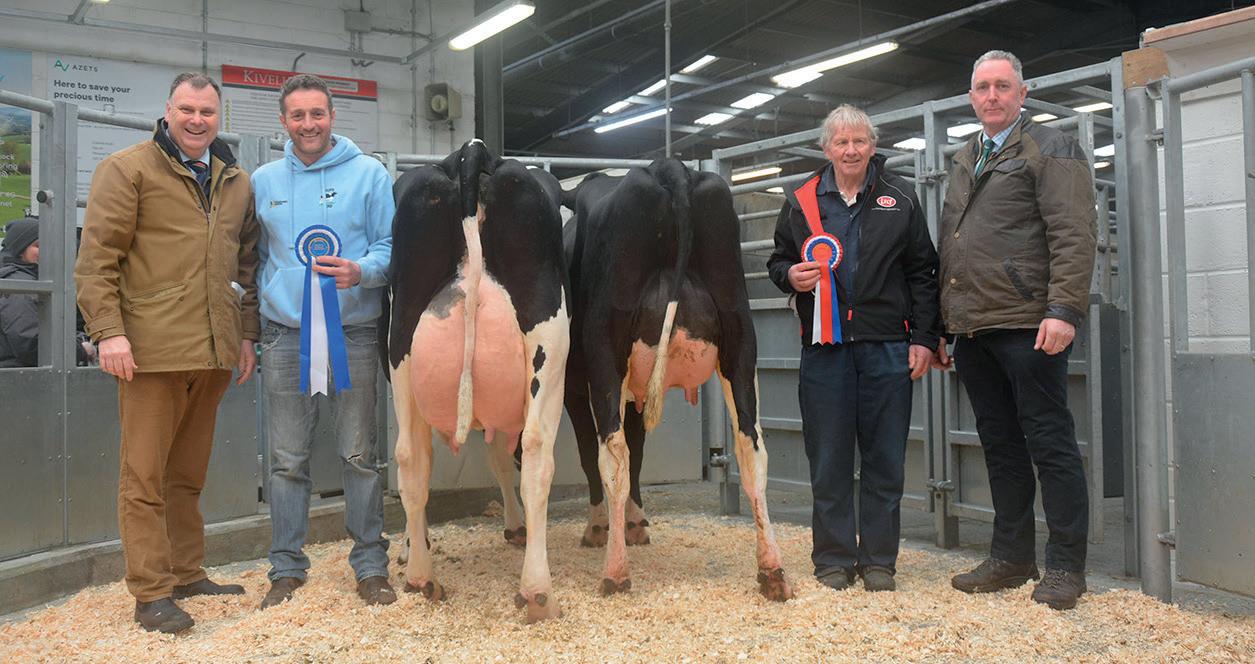
B920JA,includestrophyforhighestplacedqualifying dogwhichhasnotwonanopentrial,top10dogsfrom SundaytrialandtopfivedogsfromMondaymorningtrial toqualifyfordoublegatheronMondayafternoon,dogs canrunonbothdaysbutonlyonedog/handlercan qualify,pre-entryrequired,entriesopenApril3,max threedogsperhandler,8amstart,contactGillBurbidge, tel:07950738732.
May 6. WENNINGSIDE OPENS, Wenningsidefarm, Keasden,LA28ET,pre-enterfirst50dogs,topfive placedenteredintoadoublegatheratNorberonMay10 intheafternoon,twodogsperhandler,£10perdog,preentrytoHannahTaylor,tel:07375057621. MID SHIRES SHEEPDOG SOCIETY, theJohnThomasOpenMemorial Trial,EastcoteHallFarm,Solihull,B920JA,top10dogs fromdaytrialandtopfivedogsfromMondaymorning trialwhichwillberestrictedto30dogs,doublegather finalofthese15dogstoberuninafternoon.
May, 8. WENNINGSIDE, opentrial,Wenningsidefarm, Keasden,LA28ET,pre-enterfirst50dogs,topfive placesenteredintoadoublegatheratNorberonMay10
rReserve champion sells for £2,400
THE Spring Challenge show and sale of dairy cattle at Holsworthy topped at £2,900 for the overall champion and first prize-winning heifer Westtown Penny 8, yielding 42kg, from Steve Davey and Partners, Woolsery.
Other heifers sold to £2,300 for Bocaddon Nacash Klr Marble from S.R. Gilbert and Son, Sheepwash, who also sold heifers to £2,250, £2,200 and £2,050, with their consignment averaging £2,075.
Messrs Mitchell, St Kew, sold a fresh heifer, Laram Redcarpet Primrose GP81, at £2,250, with Thuborough Farms, Sutcombe, realising £2,200 for their heifer, Thuborough Yamalight Jessebell.
Graham and Grace Dart, Holsworthy, continued their herd dispersal, topping at £2,080 for a home-bred heifer. L.T. Harvey and Sons, Penzance, sold their last dispersal
consignment, peaking at £2,020 for a fresh heifer, with others to £2,000.
Reserve champion and first prize cow went to Hoops Tonga Butterscotch 4 GP82, a second calver yielding 53kg from J.G., F. and S. Ley, Sutcombe, which made £2,400.
The Gilbert family sold the second calver, Bocaddon Pepper cc Piglet, for £2,100, and Messrs Ley sold the second prize cow, Hoops Porto Anna GP82, at £2,080.
In-calf heifers topped at £1,620 for a heifer due in June to the Hereford from K.J. Waldon and Partners, Umberleigh. Yearling heifers sold to £700 for S.J.W. and E.M. Maynard and Son, Lifton. A consignment of 30 youngstock born from October 2023 to January 2024, on behalf of Wills Bros, Wadebridge, topped at £850 for Willsbro Hanx Fare 5847, a January-born heifer.
A November-born heifer, Willsbro Hanans Roxy 5661, and a Januaryborn heifer, Willsbro Eyecandy Rozelle 5871, both realised £780.
Auctioneers: Kivells.
intheafternoon,twodogsperhandler,£10perdog,preentrytoHannahTaylor,tel:07375057621.
May 10. WENNINGSIDE, opentrial,Norber,Austwick, LA28DJ,30dogs(followedbydoublegather),twodogs perhandler,£10perdog,topfivedogsplacedeachday ontheMay6,8and10tobeenteredintoadoublegather intheafternoon,pre-entrytoHannahTaylor,tel:07375 057621.
April 27. LLANGADOG, heldontheoldracecoursefields onA4069towardsLlangadog,pre-entryrequired, contactC.Price,tel:07815289410.
May 4. RHOSGOCH, NorthWalesSheepDogSociety AffiliatedSocietiesTrials,opentrialsonly,Rhosgoch, LL669AA,8amstart,contact07703483863.
May 4 and 5. ERWOOD (SOUTH WALES SHEEPDOG TRIALS ASSOCIATION), Sunday,localonlywithin 14-mileradius,contactAnnaProthero,tel:07795178451,
oremail:anna_prothero@hotmail.com,pre-entry required. NANT-Y-MOEL (SOUTH WALES SHEEPDOG TRIALS ASSOCIATION), Pontardawe,AnnaProthero, tel:07795178451,oremail:anna_prothero@hotmail.com.
May 6. CWMDU (SOUTH WALES SHEEPDOG TRIALS ASSOCIATION), Crickhowell,Powys,Anna Prothero,tel:07795178451,oremail:anna_prothero@
THE Farmers Guardian-supported show and sale of 390 store cattle and 40 feeding bulls at Broughton topped at £1,805 for a British Blue steer from S.W. and A. Hoggarth, Ulpha.
Store cattle were judged by Matthew and Harry Brown, Bridlington, who awarded the championship to a British Blue heifer from N. Cooper and Son, Broughton in Furness, which they went on to buy for the top heifer price of £1,800.
The second and third placed any other continental breed heifers were British Blues consigned by M.A. and J. Temple, Ulpha, which made £1,495 and £1,475 each.
champion was the winning steer, a Limousin consigned by A. Hartley, Seathwaite, which sold for £1,755, also to the judges.
Messrs Turner, Ulpha, had the second and third prize-winning steers, both Limousins, which made £1,585 and £1,495 respectively.

To find out where we will be next, go to farmersguardian.com/mth-roadshow
Top priced bull was the first prize winner, a Limousin, also from Messrs Hartley, which sold for £1,655. The second prize winner from the same vendor made £1,565.
The winning Limousin heifer from D.J. and M.J. Hoggarth, Ulpha, sold for £1,575.
The first prize native-bred heifer was a South Devon consigned by J. Roberts and Sons, Drigg, which sold for £1,355. The second and third prize winners were Aberdeen-Angus from M. and G.M. Fox, Ulpha, which sold for £1,485 each.
Messrs Roberts also had the first and second prize native-bred steers, South Devons, which made £945/head.
AVERAGES
Bulls, £1,206.87; steers, £1,191.22; heifers, £1,064.16.
Auctioneers: Barnard Castle and Teesdale Farmers Auction Mart Co.














MONDAY 6th MAY (10.45am) AT MARKET DRAYTON MARKET, TF9 3SW
(moved from Bellaport Old Hall, Norton-in-Hales, for sale convenience)
DISPERSAL SALE OF THE BELLAPORT OLD HALL FARM HERD OF 125 HOLSTEIN FRIESIANS
★ 85 milking cows and heifers to be sold in calving order ★
★ 16 served heifers ★ 24 bulling heifers ★
★ 8,786L 4.20%F 3.45%P 188CC ★ CUBICLES ★ HERRINGBONE
★ Grazed herd Spring to Autumn
★ All year calving to BB/HE/AA/HO
★ On Behalf of RJ & JE Hall



SATURDAY 27th APRIL British Simmental Cattle Society Show & Sale
20 Bulls, 21 Females Show at 9.00am, Sale at 11.30am
Details and Catalogues Worcester Market Tel: 01905 769770
FRIDAY 3rd MAY

Hereford Cattle Breeders Association Show & Sale
9 Bulls, 2 In Calf Females, 17 Heifers
Show at 9.00am, Sale at 11.30am
Online bidding via Marteye
Details and Catalogues
Worcester Market Tel: 01905 769770
Together with Here Come The Girls - Pedigree Female Sale
Blue Texel, Badger Face Texel & Spotacular Dutch Spotted
7 Ewes with Lambs at foot, 1 Recipient Ewe with Lamb at foot, 2 Dry Ewes, 11 Dry Ewe Hoggs, 1 Graded Female
Sale at 1.00pm
Online bidding via Marteye
Details and Catalogues
Worcester Market Tel: 01905 769770
SATURDAY 11th MAY
British Limousin Cattle Society
Premier Spring Show & Sale
51 Bulls, 11 Females
Show at 9.30am, Sale at 12noon
Online bidding via Marteye
Details and Catalogues
Worcester Market Tel: 01905 769770

Wednesday 1st May
8am Cast Ewes and Rams followed at 10am with Prime Hoggs (Ballot 10am)
Monday 6th May
Prize Show and Sale of Store Cattle and Feeding Bulls of all classes
Entries close noon Monday 29th April
Tuesday 7th May
Annual “New Fair” Prize Show & Sale of Hoggs, Ewes and Shearlings with Lambs at foot and Geld Gimmer Hoggs
Troutbeck Sale of Swaledale, Herdwick and Hill Bred Ewes with Lambs at foot
Entries close noon Tuesday 30th April
Friday 17th May
Onsite Collective Sale of Tractors, Machinery, Plant, Livestock Equipment and Small Tools
On Farm Sale Of Tractors, Implements, Livestock Equipment & Small Tools
On Saturday 4th May 2024 at 11am
On behalf of Messrs C J & B A Thompson, Eden Banks, Cumwhitton, Brampton, Cumbria, CA8 9HB Tractors
Massey Ferguson 390 + Loader (7600hrs); Same Aster 60 & Loader (G Reg); Iseki TS3500F & Loader; Ford 3600 (L Reg); Daihatsu Barn Find Restoration Project (R Reg); Ransome 801 Combine Harvester (Y-1964)





Tuesday 30th April
Opening Sale of Ewes & Hoggs with Lambs at Foot

Entries close by 11am on Wednesday 24th April
Friday 3rd May
May Show & Sale of 800 Store Cattle & Suckled Calves
Sale of Cast Sheep & Store Hoggs
Entries invited by 11am on Monday 29th April
Friday 10th May
May Term Sale of 800 Store Cattle
Sale of Cast Sheep & Store Hoggs
Entries invited by 11am Tuesday 7th May
Wednesday 15th May
Show & Sale of Beef Breeding Cattle & Bulls
Bull Entries close Monday 6th May
Breeding Cattle Entries by Close Wednesday 8th May
Entries to the Office 01434 605 444 www.hexhammart.co.uk info@hexhammart.co.uk

STIRLING SALE CARLISLE SALE
All the boxes ticked
When you’re looking for an easy-care breed that delivers consistently high-quality beef from a low input, sustainable system…
And gives you access to one of the best paying beef schemes in the country…
Beef Shorthorn Delivers

Tel: 01228 406200
Final Sale of the season of PET LAMBS
Monday 29th April – 10.30am
Please advise entries Ali Dodd 07394 569382
300 DAIRY CATTLE
BORDERWAY MONTHLY DAIRY DAY
Wednesday 1st May - 10.30am
Please Follow Us On Facebook To View Animals
Prior To The Sale
Comprising: 195 freshly calved cows/heifers –75 mid/late lactation cows - 30 dry cows
Breeds represented include Holstein Friesian, Fleckvieh Jersey, British Friesian & Ayrshire.
FRESHLY CALVED ANIMALS The sale includes:
Another outstanding consignment of freshly calved cows and heifers all producing large volumes of milk from many of the top dairy farms in the North.
LARGE CONSIGNMENTS
Other consignments of freshly calved animals include CLACKMAE (6) ERROLSTON (6) NETHER PRATIS (8)
BROUGHTON (8) SPECIAL PRODUCTION SALE
An outstanding group of 50 freshly calved and late lactation cows sell from M REID & SONS, Fulton, Waterbeck, Lockerbie. The herd is currently averaging 12500kgs 4.1%bf 3.4%p the group of 25 fresh cows and heifers are averaging 42kgs. The late lactation cows and heifers are mainly due to sexed sires and are due in from June. This is a modern Holstein herd with robust powerful cattle that are always in good body condition.
FLECKVIEH DISPERSAL SALE
The BAIN Fleckvieh herd owned by the Hourie family from Bain Farm, Orkney Island is an impressive herd with strong feet and legs and well attached udders. They are averaging 8016kgs 4.61%bf 3.62%p with an average cell count of 115 (from milk sold). The herd is all year round calving and comprises mostly 1st & 2nd lactation animals with several of the top cows currently giving over 50kgs. The cows are all A2A2 and all the sires for the past ten years have been A2A2. The winter ration has been grass silage, home grown barley (4kgs) and a home mix of dark grains, barley and soy feed in the milking parlour. The herd is housed in cubicles during the winter months.
Herd Health
The herd is accredited BVD free and is tested free of Johnes disease. No mastitis has been recorded this winter. The herd is in a four year TB testing area and Orkney Island is TB free.
JERSEYS the Kerricks pedigree Jersey herd have consigned 20 freshly calved heifers This is an exceptional group! The Kerricks herd is one of the top production herds in the UK.
DRY COWS 30
Dry cows sell due in June from Cumrew Farming Partners & North Corbelly Dairy Farm. These are a spring calving herds of highly productive NEW ZEALAND FRIESIANS with a large number of them producing their live weight in milk solids each year.
PLEASE ORDER YOUR CATALOGUE TODAY or connect with someone from the sale staff.
Two day show and sale of PEDIGREE LIMOUSIN CATTLE
Kindly sponsored by H&H Insurance Brokers
Friday 3rd May
11.00am – Judging of all classes of bulls and championships
Saturday 4th May
10.30am – Sale of 29 females followed by 184 bulls
Internet bidding facility available through MartEye
Spring Singles – show and sale of PRIME SPRING LAMBS
Monday 6th May
Special class for young handlers
Show and sale of EWES & HOGGS with LAMBS & FOOT
Monday 6th May
Classes for pens of 5
Mules – Continental – Rare & Minority breed
Please advise entries Joe Bowman 07736 883670, Rory Livesey 07535 001541
BORDERWAY’S SPRING YOUNGSTOCK SALE
300 DAIRY YOUNGSTOCK SELL
Wednesday 8th May 11.00am
75 In Calf Heifers – 145 Bulling Heifers80 Yearling Heifers Sell
Please Follow Us On Facebook To View Animals
Prior To The Sale
Breeds represented include Holstein Friesian, Jersey, British Friesian, Fleckvieh & Ayrshire
This is the first of our SPECIAL youngstock sales and features an excellent offering of In-Calf, bulling and yearling heifers.
PLEASE ORDER YOUR CATALOGUE TODAY!
(full details next week)
Special sale of CONTINENTAL CROSS STORE CATTLE
Wednesday 8th May
Entries close Thursday 2nd May
Show and sale of PEDIGREE HOLSTEIN CATTLE
Wednesday 15th May
On behalf of Border & Lakeland Holstein Club
Entries close Wednesday 1st May
PEDIGREE BEEF DAY
Shows and sales of Continental Breeds of bulls and females
156 PEDIGREE BRITISH BLUE CATTLE
Friday 10th May - Show 10.30am
Saturday 11th May Sale 10.30am
On behalf of Border British Blue Club 96 bulls, 52 females, 2 recipients
88 PEDIGREE CHAROLAIS CATTLE
Friday 10th May - Show 4.00pm
Saturday 11th May – Sale 10.30am
68 bulls, 20 females
Saturday 11th May
Show 9.00am Sale 12.00noon (Blondes followed by Simmental)
PEDIGREE BLONDE CATTLE
10 bulls, 8 females
PEDIGREE SIMMENTAL CATTLE
36 bulls, 10 females, 50 commercial females
SALE OF MACHINERY, IMPLEMENTS & HEAVY PLANT
Sale bidding starts 10.00am Wednesday 1st May
finishing from 10.00am Thursday 2nd May
KIRKBY STEPHEN MART
Tel: 01768 371385
Special show and sale
907 STORE BULLOCKS & HEIFERS
Also cast/feeding cows and OTM cattle
Monday 29th April
Judging 8:30am – Sale 9:30
New Fair show and sale of BREEDING SHEEP
Saturday 11th May
Show for 10 Mule hoggs and lambs, 5 Swaledale ewes & lambs
and 5 Continental ewes & lambs
Entries close 10am Monday 29th April
May sale of
BEEF BREEDING CATTLE
Also cast/feeding cows and OTM cattle
Monday 13th May
Entries close 10am Monday 6th May
Claiming Date – Friday 24th May
Evening sale of 100 Swaledale Gimmer Hoggs
Being part of the dispersal on behalf of PE&KA Sowerby, Oakbank Farm, Barras.
MIDDLETON MART
Tel: 01833 640281
Special prize show and sale of STORE & BREEDING CATTLE also MACHINERY
Tuesday 7th May
Entries close Monday 29th April



Saturday 27th April
GRASS DAY SHOW & SALE of 300 STIRKS, WEANED/SUCKLED CALVES, BREEDING & CULL GOATS, STORE & BREEDING SHEEP Show 9.30am Sale 10.00am
Saturday 27th April
Visit our trade stand BEEF EXPO
Monday 29th April
SALE OF REARING CALVES Sale 10.30am PRIME, CAST & FEEDING CATTLE Sale 11.30am (TB exempt section available)
SALE OF SPRING LAMBS Sale 12.30pm followed by SALE OF PRIME HOGGS & CAST EWES Sheep Scanning available onsite 12noon – 1pm
Sale of EWES WITH LAMBS at FOOT Sale 11.00am
Followed by INLAMB EWES & STORE SHEEP
(Entries to the office by Friday for Online Catalogue)
Dairy Cattle
Monday 29th April
FORTNIGHTLY DAIRY SALE OF IN MILK COWS & HEIFERS
Regular dairy sale to include x 12 in calf heifers from I & R Hall, Kilnsey due June- August
Monday 20th May
Show & Sale of DAIRY CATTLE
For more details on either sale contact Sarah Liddle on 07710 795585
Saturday 4th May
ON FARM SALE
On Farm Dispersal of Machinery & Implements at Owlet Hall Farm, Austwick for JR & DL Ogden
List of entries online
Wednesday 8th May
Sale of FEEDING BULLS, PRIME CATTLE, BEEF
FEEDING COWS, STORE & BREEDING CATTLE
(Entries close Wednesday 1st May)
CRAVEN LIMOUSIN DAY
Annual Show & Sale of 56 PEDIGREE LIMOUSIN CATTLE
Comprising 36 Bulls & 20 Females Inc
Tuesday 7th May
NORTHERN LIMOUSIN EXTRAVAGANZA
(Entries close Monday 29th April)
Friday 3rd May
May Fair store cattle & rearing calf show
300 Steers, heifers & feeding bulls
Kenneth Hird Memorial Shield for Champion Sale 10.30am. Entries noon Monday 29th April
Beef Breeding Cattle including part dispersal of 8 Lim & Blue heifers & cows with Lim calves for R & AR Hunter
125 Rearing Calves & Stirks at 11.00am
Craglea Trophy for Champion. Sale 11.00am.
Monthly dairy sale at 1.00pm. Entries required.
FARM SALE: Low Houses Farm, Swaledale.
Sat 11th May. Catalogue online or by request
Enquiries: 01969 623167
Monday 6th May
Annual Show of HOGGS with LAMBS at Foot
Prize Show & Sale of GELD GIMMER HOGGS
All Classes of SHEEP with LAMBS at Foot (entries close Monday 29th April)
Saturday 11th May
SKIPTON MACHINERY SALE
Grassland Equipment, Machinery Lines. Reclamation & Salvage, Stone, Timber etc
Delivery is Strictly Thursday 9th May
Entries to the Office
Annual Early Sale of 487 BORDER FINE ARTS, BESWICK & CHINA
2nd Grass Day Sale of STIRKS, WEANED/ SUCKLED CALVES, BREEDING & CULL GOATS, STORE & BREEDING SHEEP (Entries close Monday 6th May)
Friday 17th May
Spring Sale of WORKING SHEEP DOGS – LIVE FIELD SALE (entries close Wednesday 1st May)
Pedigree Cattle Sale
Wednesday 22nd May –
LINGFIELDS BEEF CATTLE FAIR
MULTI BREED SALE OF PEDIGREE BEEF BREEDING CATTLE
(Entries close Monday 6th May)
Saturday 25th May - PEDIGREE BELTED GALLOWAY CATTLE (Entries to the society)
Monday 27th May
BANK HOLIDAY BLUES
Annual Sale of Pedigree Blue Texel, Badger Face Texel & Other Pedigree Ewes with Lambs at Foot & Empty Gimmer Hoggs (Entries close Friday 17th May)
Saturday 1st June
AIREDALE ANGUS ON FARM SALE
Draft Sale of 80 head of Cows with Calves or In Calf, Young Bulls & Embryo’s
For D & J Isherwood
Claiming Dates
ON FARM SALES
TUESDAY 21st MAY – NORTH CRAVEN
THURSDAY 6th JUNE - SILSDEN
SATURDAY 28th SEPTEMBER - SKIPTON

On instructions from Anne and Doug Sheppard (who have retired).
A complete smallholder’s dispersal sale at Ryehill Lodge, Watling Street, Long Buckby Wharf, Northamptonshire, NN6 7PW.
To include: 1996 Case 5130 4WD Tractor, 1985 JCB 3CX Digger, 2009 Ifor Williams HB511 horse trailer. Together with: A comprehensive range of garden and property maintenance equipment to include: 2016 Cadet XZ2 Enduro series ride on lawn mower.
Plus: General Farm Machinery and Workshop Equipment, Agricultural Requisites, Equestrian Equipment, Garden and Camping Equipment, Household Equipment and Furniture. Also: A large number of entered lots from outside vendors.
To be sold by auction on the premises on Saturday 4th May 2024 at 10.30am.
On instructions from Messrs SA & E Friswell (who are streamlining their operations). West Farm, Brinklow, Rugby, Warwickshire, CV23 0LY.
Part I: The Complete Commercial Herd of 146 Continental x Suckler Cows & Limousin & British Blue Calves
Farm Assured, BVD Free, December–April born calves with excellent conformation, shape and growth; some with show potential. To be sold by auction on the premises on Saturday 11th May 2024 at 11.00am.
Part II: A Most Interesting Machinery & Equipment Sale to include Massey Ferguson Tractors, Telescopic Handlers, Excavator, General Farm Machinery & Livestock Equipment
To be sold by auction on the premises on Saturday 1st June 2024 at 10.30am.



LIVESTOCK AUCTIONEERS � VALUERS
www.nwauctions.co.uk info@nwauctions.co.uk
LANCASTER AUCTION MART
Tel: 01524 63308
Monday 29th April
10.30am SPRING LAMBS, PRIME HOGGS & CAST SHEEP
Followed By SHEEP WITH LAMBS AT FOOT
Friday 3rd May
10.15am 150 REARING CALVES & WEANLINGS
10.15am 150 CAST / OTM CATTLE 11am DAIRY CATTLE 11.15am 300 STORE CATTLE
Monday 6th May Show at 10am
SHOW & SALE OF HOGGS WITH LAMBS AT FOOT
Catalogue Entries By Wednesday1st May
J36 RURAL AUCTION CENTRE
Tel: 015395 66200
Tuesday 30th April
11am SHEEP WITH LAMBS AT FOOT
1pm SPRING LAMBS, PRIME HOGGS & CAST SHEEP
Thursday 2nd May
‘GREAT ANNUAL GRASS DAY SHOW & SALE’ 10am 150 REARING CALVES & WEANLINGS
10.30am 100 CAST / OTM CATTLE 11.15am 1000 STIRKS & STORE CATTLE

Tuesday 30th April
1000 Prime Hoggs & Lambs 10am
300 Cast Ewes & Rams
100 Gimmer Hoggs inc. 40 Swaledales from W & J & E Harker & Son, Ramsgill at 11:30am
300 Ewes with Lambs at Foot inc. consignment
100 Ewes with Lambs from S & A Bland, Gaisgill to include 15 Pure Texels, 35 Mules with Cont x Lambs & 50 Swales with Mule Lambs at 12am
Spring Show & Sale of Calves for the Bill Thompson Trophy. Judging 10am. Sale 10.30am. Sponsored by Genus Breeding & Raydale Preserves. 2 Auction Mart Shares at 11am
Tuesday 7th May
Show & Sale of 500 Ewes with Lambs at Foot. Classes for 5 Ewes or Hoggs with Lambs. Consignment of 80 Ewes with Lambs at foot from S & A Bland, including 10 Pure Texels, 15 Mules with Cont x & 55 Swales with Mule lambs.
Saturday 18th May
Show & Sale of Store Cattle, Beef Breeding Cattle & Cull Cows. Entries close Tue 7th May.
Tuesday 21st May
Sale of Tractors, Implements, Tools etc. Please Enter Telephone: 01969 667207, 015396 20895, 07974 126397. 07711 469280



Wednesday 8th May 11am
SHOW & SALE OF HOGGS WITH LAMBS AT FOOT
Catalogue Entries By Wedneasday1st May
PEDIGREE SHEEP DAY
Sale for Pedigree Ewes with Lambs & Gimmer Hoggs
Thursday 16th May PEDIGREE BEEF DAY
Sale for all Breeds & Classes of Pedigree Bulls & Females
Saturday 27th April 1pm
Farm Machinery Dispersal Sale
On behalf of R&EA Gardner, Kendal, LA8 8BJ Bradley Thompson, Auctioneer: 07867 000244
May Online Machinery Sale
Delivery: Monday 29th & Tuesday 30th April
Sale to Commence: Friday 3rd May
Viewing: Friday 3rd (9am-4.30pm) & Saturday 4th (am only)
Sale to Conclude: Tuesday 7th May
Special Online Sale of Vintage & Classic Tractors, Vehicles, Farm Machinery, Equipment & Rural Bygones
Delivery: Monday 20th & Tuesday 21st May
Sale to Commence: Thursday 23rd May
Sale to Conclude: Tuesday 28th May

12/15mth, TB4, FABBL from W Gibson & Son
12 LimX, AAx Hfrs, 12mth, TJ & TR Smithson
1 LimBull & 1Lim Hfr, 10/11mth, I Wilkinson
10 Lim Str/Hfr, 12mth

Auction Mart
Claughton On Brock, Preston PR3 0PH
01995 640280 www.garstangmart.co.uk
Auctioneer: Ian Atkinson 07944 237516
Contact Office for Details
MART


Tuesday 30th April 2024
9.00 a.m Prime Hoggs & Cast Sheep 10.30am Sale of 45 Sheep with Lambs at Foot 10.30 a.m. Sale of 100 Store Cattle
11.30 a.m. 60/80 Rearing Calves, Weanlings & Stirks
Wednesday 1st May 2024
10.30 a.m. Weekly Sale of Cast Cows & OTM Cattle Followed by TB Exempt Cattle
Saturday 4th May 2024
10.30 am On Farm Dispersal Sale of Machinery & Implements on Behalf of R & A Jolleys, Cabus
Wednesday 15th May 2024
Dispersal sale of 150 In Milk Holstein Friesian Dairy Cows & Heifers from K & B Lupton
Wednesday 22nd May 2024
Monthly Show & Sale of Dairy Cattle Entries Close Thursday 16th May 10.00 a.m.
Tuesday 28th May 2024
Marts the Heart Early Summer Show of Prime Lambs & Young Handlers Show
Saturday 1st June 2024
Early Summer Sale of Machinery & Implements
Wednesday 5th June 2024
On farm Dispersal sale of 100 In Milk Pedigree Ayrshire & Holstein Friesian Dairy Cows & Heifers from Cowell & Moore

BULLING HEIFERS & BREEDING BULLS Entries for catalogue close Friday 26th April
Wednesday 8th May
WYNNSTAY DAIRY DAY
Show & Sale of Newly Calved Dairy Cattle Also 12 HF Maiden Hfrs 8-10mo


Bakewell Market Results - Monday 22nd April
748 Cattle & 1,443 Sheep - Full report available on our website
Store Cattle Entries for Monday 29th April
Please call the Bakewell Office on 26th April before 12 Noon Call 01629 812777
Watch the livestreamed cattle sales on www.streaming.auctionmarts.com
Please Note: May Day 6th May - Monday Market as usual
Monday 27th May - CLOSED
Tuesday 28th May - Market Open
T HURSDAY LUNCHTIME WEEKLY SHEEP SALE
Entries/Enquiries, contact Peter Oven: peter.oven@bagshaws.com or 07973 982443
Or Ivor Lowe: ivor.lowe@bagshaws.com or 07977 449126
Farm Dispersal Sales
CHURCH COTTAGE FARM, HULLAND WARD, DE6 3EG, FRIDAY 3RD MAY 2024,10.30AM
John Deere 6930 Premium 4WD (09’)
Manitou MLT627 Turbo Telehandler (07’)
Bobcat S220 Skidsteer Loader c/w Attachments
Trailers, Grassland Machinery, Cattle Equipment & Sundries
Round Baled Hay & Silage

BARNARD CASTLE AUCTION MART
TUESDAY 30TH APRIL
20-25 OTM Cattle
CENTENARY PRIZE SHOW & SALE
55 FEEDING BULLS & 310 STORE CATTLE Sale at 10am
PATELEY BRIDGE AUCTION MART
TOMORROW SATURDAY 27TH APRIL
Sale of 35 OTM, Prime & Cattle 160 Store Cattle Sale at 11am
BROUGHTON AUCTION MART
There will be no sale on Tuesday 7th May
THE NEXT SALE WILL BE
TUESDAY 21ST MAY
Sale of OTM Cattle
Prize Show of Beef Breeding Cattle Feeding Bulls & Store Cattle
PRINCIPAL SALE OF EWES & LAMBS
Early entries appreciated
SATURDAY



SATURDAY 18TH MAY 2024,10.30AM
John Deere 6200 4WD, Zetor 11441 Forterra 4WD
General Implements & Machinery, Trailers, Livestock Equipment, Workshop Items
Collectables and Stone Troughs Catalogues are available to download at www.bagshaws.com Email: olivia.fernihough@bagshaws.com
Tel: 01629 812777
www.bagshaws.com



Mark Lee: 07980924179
Simon Lamb: 07815 188125
Ryan Spackman: 07725 653542
Mark@nortonandbrooksbank.com



Dispersal sale of the milking portion of the noted WHITECARR herd together with close calving heifers, the property of Mr T Cowell. The end of an era for one of the most well known and respected breeder herds in Lancashire. Almost 200 cows will sell in milk or dry. All cows housed in cubicles and milked 2x daily. All year calving with large proportion due through the Summer months. OVER 100 SELL IN THEIR 1st LACTATION! Of the milking herd almost half are VG/EX with almost all carrying many generations in the top grades from proven cow families that have consistently performed over decades. Currently averaging 9600kg of which 4500kg from forage! PLEASE NOTE – these cows are not pushed and have huge potential for further yield as proven by previous buyer satisfaction from Whitecarr stock. Great herd health, vaccinated IBR, BVD, Lepto. Johnes tested with no positive for many years. 4Yr TB area. Live on Marteye. Transport available to all parts of UK. Friday 10th May - Dispersal of the Swallowdale and Crystal Herd, Messrs Elmes (Swindon) at Exeter Livestock Centre see Kivells ad next week
WEEKLY DAIRY
12.30pm STIRKS entries by Tuesday 7th 12noon
Saturday 11 May
9.30am WEEKLY CAST SHEEP & PRIME HOGGS
10.30am SHEEP WITH LAMBS & IN LAMB SHEEP Entries please for the catalogue by Tuesday 7th 12noon
Saturday 18 May




THE READING AUCTIONEERS TWO UPCOMING DISPERSALS DUE TO RETIREMENT AND A CHANGE IN FARMING POLICY On instruction of CHURCH LANE FARM, SILCHESTER, HANTS, RG7 2LJ
A R MORE PARTNERSHIP and OTHERS FARM MACHINERY & SHEEP HANDLING EQUIPMENT
Including: New Holland CR9090 tracked combine (2013), John Deere 6145R foreloader tractor (2023) (300 hrs), Case Puma 230DVC (2015), MF 7724 & Ford 4000 tractors, Merlo P40.7 telehandler (2014), Househam 3500 sprayer (2011), Range Rover Sport HSE, Horsch DC drill, KRM R1000 combination drill, Amazone AD-P402 combi drill, Farmet disc harrows, Farmforce cultivator, Kidd topper, NRH folding Cambridge rolls, Warwick flat bed trailers, Marston tipping trailer, John Deere 750A 3m no tills drill (2020), John Deere M732 24m trailed
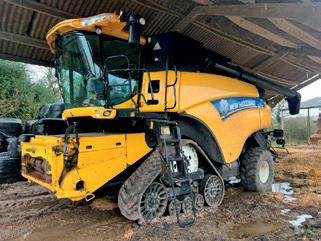

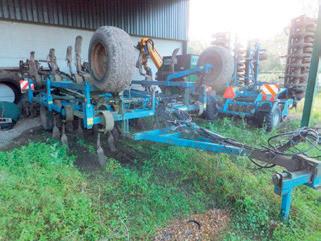
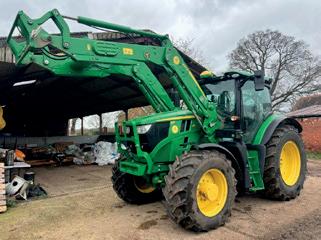










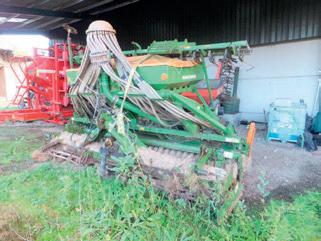









Friday 3rd May
McCartneys – 01905 769770
Melton Mowbray - May Spring Fling Sale
Saturday 4th May
Melton Mowbray Market – 01664 562971
Carlisle – Spring Spectacular
Friday 24th May H&H – 01228 406230
Skipton – Bank Holiday Blues
Monday 27th May CCM – 01756 792375








JD 8600I forager (17); JD maize header (16); JD T670 bale chaser; Tong beet washer/loader (21); Simba Solo 380ST 50 JD 8420T crawler (6383hrs; 05); JD 6215R 50KM (16); JD


Deutz M650 (9521hrs; 59); NH TG285 Super Steer (05); NH T6050 Plus (08); JCB Fastrac 3155; Valtra A104 (68); MF 390 c/w loader (M); Fendt Favorite 615SL 26 LOADERS: 2 JCB 3CX Sitemasters; Manitou 629dumper 20 QUADS: JD XUM 865M Gator (19); JD 855 Gator (17); Pola54 GRAIN TRAILERS: Stewart
Triffitt 10/11T 21 BALE TRAILERS: Clough BP 16 32ft; Bailey 33ft 16T 28 STOCK TRAILERS: Bailey -Trek & IW 606; IW DP120 c/w decks 130 GP TRAILERS: 2 Chieftain low load; Boss welfare unit; IW 36
2 McHale V660; McHale F5500; 2 JD 960 (17 & 12); JD 690, 80 MOWERS: JD 388 & 328; Kuhn FC243D (14);
41 RAKES & TEDDERS: Claas Liner 3100 (14); Krone 69
19 DRILLS: 2 Vad. Rapide 4m; 2 Lemken Solitair 9 144 CULKuhn MM150 plough; Knoche DM60H discs (04); Kuhn 225 HEDGERS, BUCKETS: Shelbourne hedger; Strimech Pro Ag grab; 470 STOCK REQUISITES: 2 Lucas Raptor bed-A-Bale; McHale C430 straw
980 SPARES & WHEELS: 136 GROUNDCARE: Ransome
386 STONE & GARDEN: 600 SMALL PLANT: 550


60 X 30ft building PRODUCE: 400T maize silage
MURTON, YORK, YO19 5GF
Tel: 01904 489731 or online at www.ylc.co.uk










Agriconnect is a business unit within the Arc network, a global events, data, and media platform. Arc is a fast-growing global events, data, and media platform with a varied portfolio content led portals, magazines, and events.
Since 1844, the brands of Agriconnect have been the trusted source of information for farmers and with brands like Farmers Guardian, events, like LAMMA and Farm Business Innovation, and digital platforms, like FG Insights, Agriconnect continues to bring together the British farming community.
• We are now looking for a motivated and driven salesperson to join our Sales team.
• The main function of the role is to develop business through growth in revenue, yield, and to increase customer numbers. You will be required to identify new opportunities and influence companies’ media buying habits within the agricultural sector. Due to the ever-changing nature of the industry, this person will have the ability to spot new avenues and exploit market trends.
Hours: 35 hours per week – Mon – Fri
• Location: Preston – temporary hybrid remote
• Salary: Competitive, dependant on experience.
• Own, support and fully develop specific market sectors
• Conduct sales presentations by telephone, email or face to face to existing and prospective clients in order to develop existing business and generate new business wherever possible.
• Advise existing and new customers on the most effective solution to meet client needs within the Agriconnect portfolio.
• Continually seek and develop new sales & opportunities.
• Ability to accurately forecast future sales
• Keep abreast of all current trends, activities and relevant news within agriculture and specific sector
• An interest in agriculture
• Highly motivated & driven, with an ability to meet ambitious performance goals
• Be enthusiastic and motivated to continually explore new opportunities, whilst possessing a natural inquisitive nature
• Excellent communication written and interpersonal skills
We offer an excellent package including:
• A competitive basic salary
• 25 days holiday increasing to 27 after two years
• An extra day off on your birthday
• Free life assurance
• Contributory pension scheme
• Employee assistance programme
Arc has ambitious plans for growth, and this is an opportunity to be part of our continuing success story whilst enjoying a fabulous work/life balance. We strive to create a culture that is open and respectful, where differences are valued and celebrated. We want everyone to be able to reach their full potential, so we are committed to cultivating a company that promotes inclusion and belonging.
To apply for this role, please email amber.tabiner@agriconnect.com

Visit jobs.farmersguardian.com for the latest job vacancies in agriculture


Tortworth Estate, South Gloucestershire.

350 cow pedigree British Friesian herd calving in two blocks, the herd supplied by the Estate owners (part ownership considered). Muller organic milk contract.
Forage based system with approximately 570 acres of organic land available to the dairy, additional organic forage or cereal crops may be available on an annual licence.
Comprehensive facilities including new 24:48 herringbone parlour and single rate cake feeders, cubicles, silage pits and slurry storage.
The contract will operate for a term of 5-10 years by agreement.
The successful applicant to supply all labour and non-fixed equipment for the day to day operation of the dairy.
Substantial, five bedroom farmhouse and three bedroom annex are available for the use of the successful applicant.
Please contact Emma Bradshaw on emma.bradshaw@kiteconsulting.com for further details.


Area: Somerset
Salary: £23,402 per annum Contract: Fixed Term
This is a fixed term contract until 28th February 2026. The role is full time working 5 days out of 7 including some weekends and bank holidays.
About The Role
An exciting opportunity to assist with practical reserves management, as part of the Species Survival Fund, a 2 year project: Wetter For Waders: Enhancing Somerset’s Coastal Wetlands. You’ll be part of our team based across the Steart Marshes and Bridgwater Bay National Nature Reserves. This will include management of habitats, working with the farmers grazing the reserve, maintenance of infrastructure, survey and monitoring, and supervision of volunteers. Practical training will be provided as part of the role.
As one of the largest of wetlands managed by WWT and an integral coastal component of the wider Somerset landscape, this is a fantastic opportunity to learn about wetland conservation, restoration and creation. Be on the cutting edge of management techniques supporting the increase in abundance of rare and protected wetland habitats and species.
Wetter For Waders is funded by the Government’s Species Survival Fund. The fund was developed by Defra and its Arm’s-Length Bodies. It is being delivered by The National Lottery Heritage Fund in partnership with Natural England and the Environment Agency.
About You
To join as our Assistant Reserve Warden you’ll bring: Qualifications at GCSE standard (grades A – C or 4 - 9) or equivalent experience
• Experience of working in a similar environment
• Excellent observational skills.
• Experience of working in a customer service environment.
• Full UK driving licence as you will be required to drive to the reserve. We are looking for someone who can work as part of a small team, with a positive, proactive approach and an enthusiasm for nature conservation. For more information or to apply, head to JobsInAgriculture.com





Latest Jobs From Real Success
Herdsperson
Cullompton, Devon - REAL Success
We are seeking a Herdsperson to join our team in Cullompton, Devon with a 320 herd on an organic farm. Superb accommodation available.
Location: Cullompton, Devon
Closes: 15 May 2024
Job Sector: Animal Health, Dairy, Farm Work, Livestock
Contract Type: Permanent
Salary: £30,000.00 - £35,000.00 per annum
Herd Manager
Warwickshire - REAL Success
Due to the continued expansion of our dairy farming business, we are looking for a Herd Manager at one of our units near Ashby St. Ledges & Kilsby.
Location: Ashby St. Ledgers, Warwickshire
Closes: 15 May 2024
Job Sector: Animal Health, Dairy, Farm Work, Livestock
Contract Type: Permanent
Salary: £38,000.00-£45,000.00 per annum
Herdsperson
Edgmond, Shropshire - REAL Success
We are seeking a Herdsperson to join our team in Edgmond, Shropshire on our farm, working with 400 pedigree Holsteins.
Location: Edgmond, Shropshire
Closes: 15 May 2024
Job Sector: Animal Health, Dairy, Farm Work, Livestock
Contract Type: Permanent Salary: £27,181.00-£29,605.00 per annum
Assistant Herd Manager
Crediton, Devon - REAL Success
We are looking for an Assistant Herd Manager to join our team near Crediton, Exeter working with 300 grass-based Friesian cross Jersey cows.
Location: Edgmond, Shropshire
Closes: 15 May 2024
Job Sector: Animal Health, Dairy, Farm Work, Livestock
Contract Type: Permanent
Salary: £35,000.00-£41,000.00 per annum
For more information on any of these vacancies or to see all our current roles, please go to: JobsInAgriculture.com
We are looking for an auctioneer to join our McCartneys livestock team. The successful candidate would assist with all aspects of the markets including procurement of stock, weekly auction sales of prime/store stock and on-farm dispersal sales. Experience is preferred but not essential as full training will be given. The successful candidate must have the following:
• Positive attitude and hard work ethic
• Confident communication skills
• Ambition to progress
• Agricultural knowledge and experience
Positions available across the whole McCartneys region.
Competitive package and full training will be provided as well as enrolment onto the Livestock Auctioneers Association course at Harper Adams University.
PLEASE CONTACT JAMES AMPHLETT - 07972 653077 OR EMAIL JAMES.AMPHLETT@MCCARTNEYS.CO.UK
MCCARTNEYS LLP, WORCESTER LIVESTOCK MARKET, THE HEATH MEADOW, NUNNERY WAY, WORCESTER, WR4 0SQ
APPLICATIONS TAKEN IN STRICTEST CONFIDENCE

A fantastic opportunity has arisen for an enthusiastic and conscientious operator to join our small team in North Hampshire. The estate covers around 550ha, of which around 360ha is cropped. We have just started a Higher Tier Countryside Stewardship agreement and also have forestry operations and a shoot.
We are looking for someone who can carry out all the major arable operations. In addition, they will be a key member of the wider estate team, assisting with machinery maintenance and work in the woodland.
THE SUCCESSFUL CANDIDATE WILL HAVE:
A high level of attention to detail.
An ability to work autonomously
· A strong awareness of health and safety.
· PA1 and PA2. Telehandler, Chainsaw and PA4s are also desirable, but training will be given. The ability to keep complete, accurate, records.
In return, we offer a competitive remuneration package with accommodation, opportunities for further training and continuing professional development. The role is available from June 2024.



online?
can! Barry, a member of the off-line agency Friends1st says: “I joined ‘Friends1st’ because your many years of experience and dedicated work in bringing people together appealed to me. You’ve treated me as an individual rather than just a number. I highly recommend you to others.”
Call us on 0121 405 0941 today to find out how Barry’s experience could be yours too.
www.friends1st.co.uk/ christian-farmers-dating
•
•













Available in suitable batches delivered to most parts of the country
Continental Bull and Heifer calves 3-5 weeks old available now.
Quality store cattle sourced directly from Welsh/Shropshire Borders Farms, delivered to your farm.
Delivery Nationwide.
Livestock Supplies Ltd
Ashley: 07831 887531 Office: 01829 260328
www.livestocksupplies.co.uk
Five Red and Black Limousin stock bulls
17-22 months. Some Semen tested. TB4 area.
Livestock Supplies Ltd
Ashley: 07831 887531, Office: 01829 260328, Will: 07769 974476
Wilf Lomas - 01606 832142 or 07769704628
TOP PEDIGREE REGISTERED HEREFORD BULLS AND HEIFERS.

Younger bulls also available
Tel Edward: 07770 457453 N. Yorkshire (P)


60 p060.indd 60
All home bred, quiet to handle. Delivery available. 07885 594143 or 01394 460408 (East Anglia)

For sale large selection of Bulls, all semen tested. Aged 17 - 24 months. From easy calving lines, with excellent temperament. £3,800 - £5,000. Also, Heifers & Cows in calf, please enquire. Elite Health Status, plus TB4, just tested.
Visit www.elderberrylimousins.co.uk for pics, videos & info.
Tel: 07825 868939 (Barry) or 07436 076636 (Paul) East Yorks (P)
Can deliver or arrange transport nationwide.





























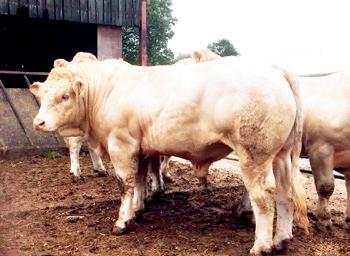






























Molasses based liquid feeds offer a cost-effective solution for dairy, beef and sheep rations
High sugar options to drive forage utilisation and feed efficiency
Include magnesium to reduce the risk of grass staggers at turnout
Flexible load sizes from 1T to 29T
Interest free Tank Finance Scheme available
Richard Dobson 07764 344716
Angela Sutherby 07957 642669





Danielle Goatley 07710 075824
Georgina Chapman 07485 192774 Nutritionist | Technical Support Manager www.edfmanliquidproductsuk.com

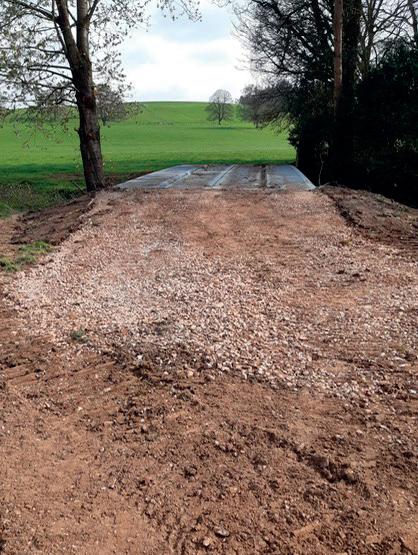



Only 18 Pairs Left!










• 30ft long x 8ft wide x 18 inch deep


• Very strong & durable would make good bridges for river crossing, dikes etc
• Based in Lancaster, Lancashire.
• Collection or haulier
• Transport can be arranged.
Only 18 Pairs Left! Call








£3250+VAT per flat, deals for bulk order.




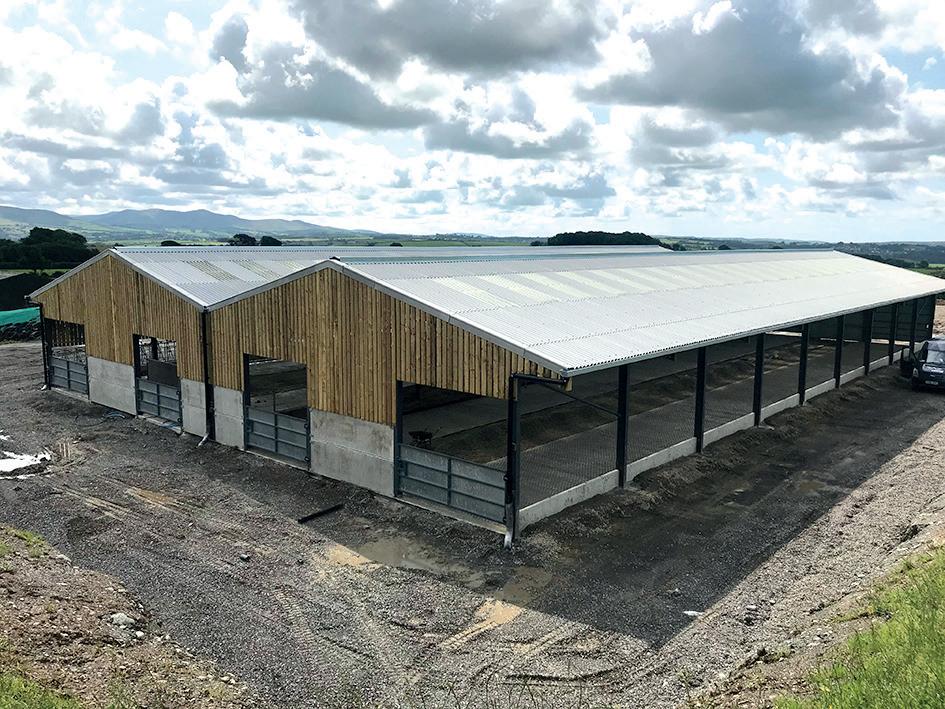












































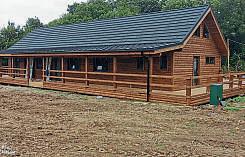





















Helen
Over the last month the weather has continued to be unrelenting, and it has undoubtedly taken its toll on farmers who now have completely saturated and even flooded fields and for those who have been trying to lamb in what has felt like continuous rain.
With all the incredibly wet weather we have seen, many farmers are turning to the Sustainable Farming Incentive (SFI) to see how this may assist them with the potential shortfall in income where they have not been able to sow crops or where crops have failed.
There is also the huge advantage of the guaranteed income which would be received under SFI.
Many farmers who have not been able to sow winter crops, or have a number of fields with failed crops, may have originally planned to sow a spring crop, but as the wet weather continued this looked increasingly unlikely.
Another option was to instead take advantage of SFI options and sow large areas of the farm in winter bird food, for example, to make up for the lost income.
Defra suddenly seemed to cotton on to this and, as a result of food security concerns, suddenly announced on March 25 that from midnight, any options which take land directly out of food production would be limited to just 25 per cent of your farm.
Many farmers are suddenly having to rethink their plans once again.
Trying to be more positive, the payment rates for many of the SFI options do remain attractive and some were increased in January.
Many options also have additional benefits to your business if taken up and delivered properly, hopefully helping you to reduce your input costs and improve soils.
This can be especially true for the likes of the nutrient and integrated pest management plans, legume fallow, multi-species winter cover crops and herbal leys.



Helen Proud
The requirements for the options are much more flexible than under historic schemes, meaning that they can better work with your system and crop rotation.
We also know that Defra is due to release more SFI options in summer, with many options moving across from Countryside Stewardship, but there are also completely new options, such as precision farming and no-till, summer cover crops, woodland and agro forestry and flood resilience options.
The merging of SFI with Countryside Stewardship to create one scheme will also reduce the huge confusion which farmers were faced with last year when deciding which scheme better suited their business.
There does not feel like a whole lot to be positive about at the moment and we all hope that the weather is set to drastically improve. I would suggest for anyone who has not looked at SFI to really consider whether the scheme could help them.
If you currently have an SFI agreement, you may also be able to take advantage of additional options, including new options which are coming in, so you may wish to revisit your agreement in light of the continued challenges.
Helen Proud is a registered valuer, associate and rural chartered surveyor with youngsRPS.
Call 01434 608 980, or email
helen.proud@youngsrps.com


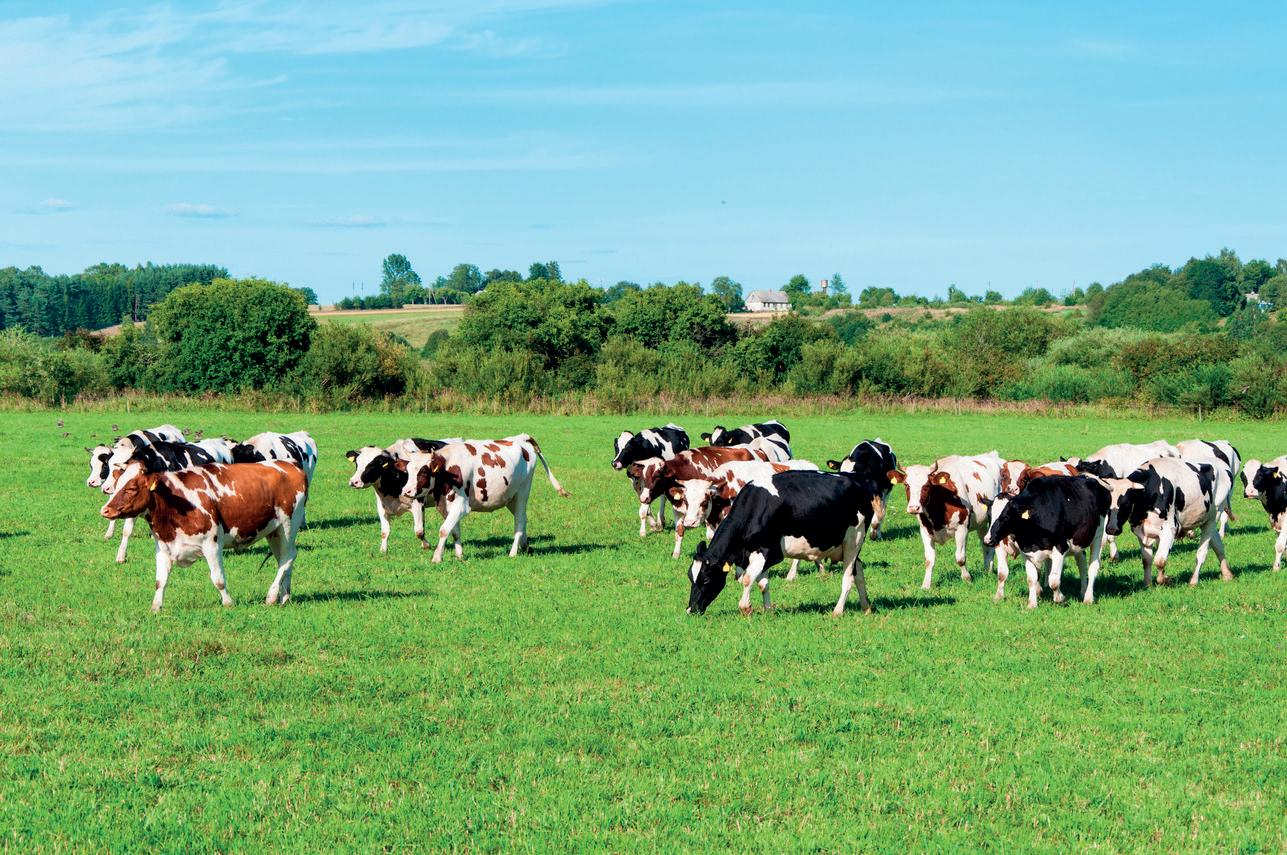






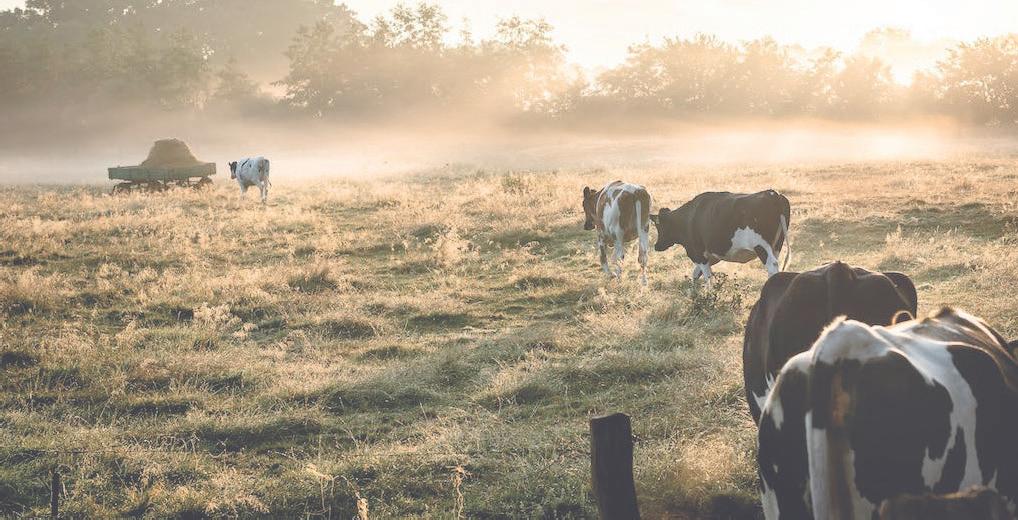


- 39 Acres of superb summer grazing, between Leek & Ashbourne. Well fenced, natural river water, excellent access. Suitable for Sheep or Cattle. Tel: 07710 843445
Must have yard, building, small amount of land and modest accommodation. For relocation of agricultural/horticultural business. Anywhere in the UK considered. Contact 07719 995742
Farmers Guardian, Fginsight.com and fgbuyandsell.com (hereinafter referred to as ‘Farmers Guardian) may contain advertisements, links to other Internet websites or online and mobile services provided by independent third parties, including websites and telephone contacts of our advertisers and sponsors (what we call “Third Party Sites”), either directly or indirectly. It is your decision whether you purchase or use any third party products or services made available on or via Third Party Sites and you should read below carefully. Our Privacy Policy does not apply to Third Party Sites. In no circumstances do we accept responsibility for your use of Third Party Sites or in respect of any Third Party products. By Third Party Sites we mean websites, online or mobile services provided by third parties, including websites of advertisers and sponsors that may appear in Farmers Guardian. By Third Party Products we mean products or services provided by third parties.
Farmers Guardian contains advertising and sponsorship. Advertisers and sponsors are responsible for ensuring that material submitted for inclusion on Farmers Guardian complies with international and national law. Farmers Guardian (nor its websites) is not responsible for any error or inaccuracy in advertising or sponsorship material.
Any agreements, transactions or other arrangements made between you and any third party named in, on (or linked to from) in Farmers Guardian and its websites are at your own responsibility and entered into at your own risk.
Farmers Guardian promises to develop and operate with reasonable skill and care and will use reasonable efforts to promptly remedy any faults of which it is aware.
Farmers Guardian does not provide any other promises or warranties about its products and services. Farmers Guardian is provided on an “as is” and “as available” basis. This means that Farmers Guardian does not make any promises in respect of Farmers Guardian or the services and functions available on or through Farmers Guardian, Fginsight.com and fgbuyandsell.com or of the quality, completeness or accuracy of the information published on or linked to from Farmers Guardian, Fginsight.com and fgbuyandsell.com other than as expressly stated above.
The above disclaimers apply equally to your use of Farmers Guardian, Fginsight.com and fgbuyandsell.com without limiting the above; Farmers Guardian and its websites are not liable for matters beyond its reasonable control. Farmers Guardian does not control third party communications networks (including your internet service provider), the internet, acts of god or the acts of third parties.
Farmers Guardian liability will not be limited in the case of death or personal injury directly caused by Farmers Guardian negligence in those countries where it is unlawful for Farmers Guardian to seek to exclude such liability.
Any individual, who is in doubt about entering into a loan agreement, should seek professional advice or consult an authorised person who can assist in relation to entering into a credit agreement. Before acting on any information you should consider the appropriateness of the information having regard to these matters, any relevant offer document and in particular, you should seek independent financial advice.
All loans, loan participations and financial products or instrument transactions involve risks, which include (among others) the risk of adverse or unanticipated market, financial or political developments and, in international transactions, currency risk. Lending against non-traditional physical collateral exposes investors to specific risks such as the potential for fraud, theft, damage and illiquidity.





Sites
1- 1000 acres required for residential development. If you think that your land has potential for development, or you have been approached by a developer, then you will need expert advice that is not available at traditional sources. Michael Rutherford is a specialist agent acting and negotiating for landowners. Contact me for a confidential and expert consultation at no cost. All areas of the UK covered.








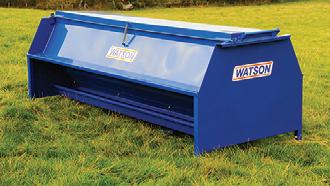



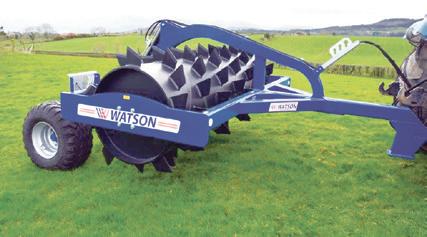

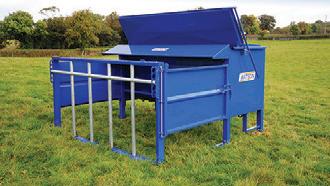





















































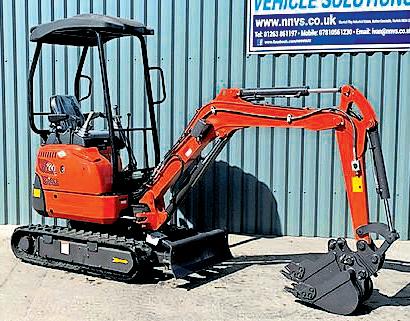



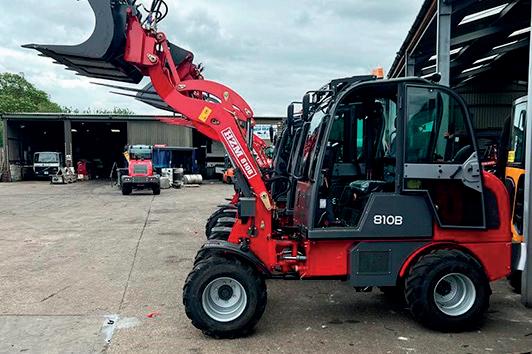































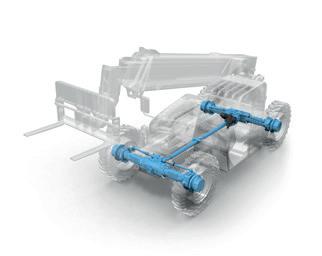







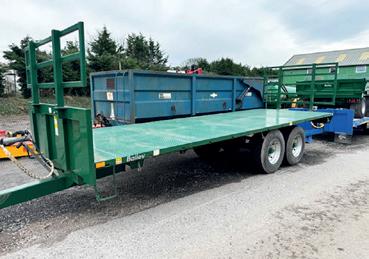
















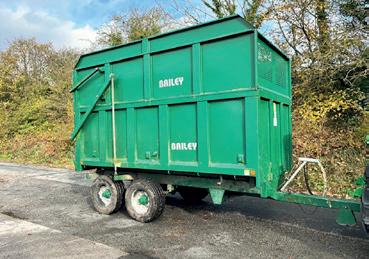
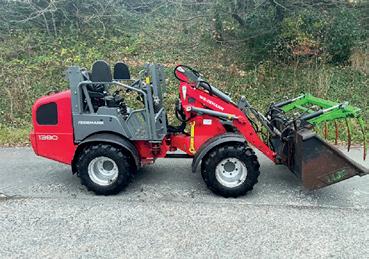
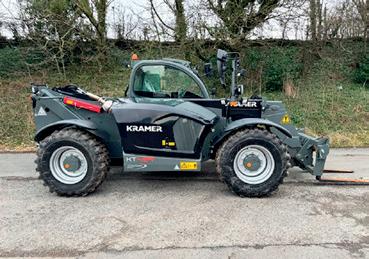









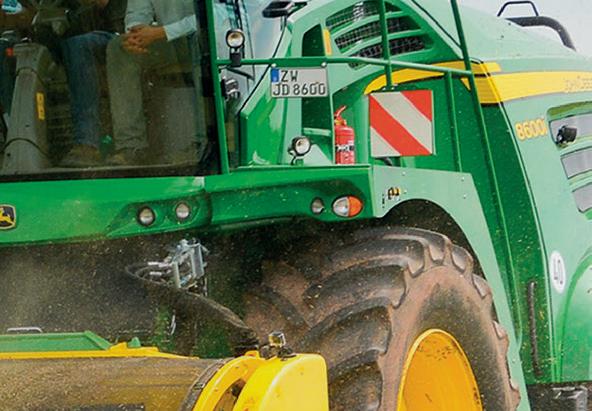
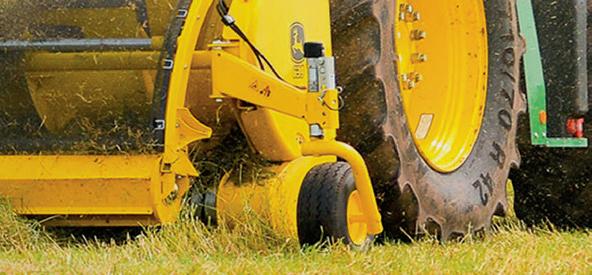

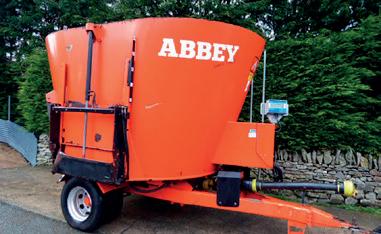
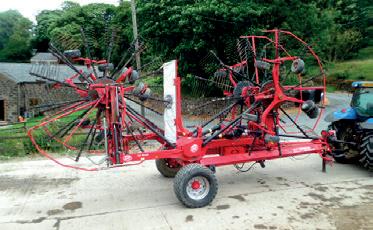












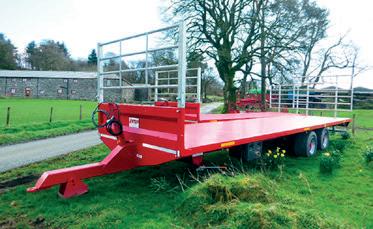
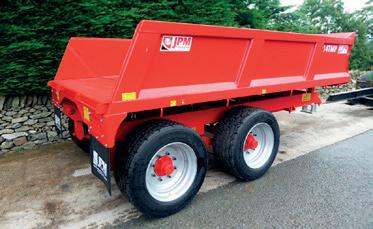
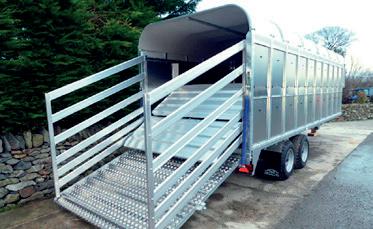


Most machines owned and maintained by us from new and all stored undercover and for sale due to replacements on order.
Please see our website from pictures www.easternfarms.co.uk Charles - Eastern Farms Ltd
T: 07834 233152 E: charles@easternfarms.co.uk Huntingdon, Cambridgeshire UK








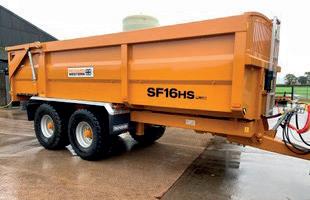



NEW S 55 TWIGA HEDGE / VERGE CUTTER, 1.2m head, manual roller, Pilot hydraulic proportional controls. 18’ (5.5m) reach. Linkage mounted. £19,750 + vat.





SNIPER 225 HD, Flail mower, Hydraulic side shift, Linkage mounted, Cutting width 7’5” ( 2.25 ) Adjustable rear roller. £4,500 + vat.


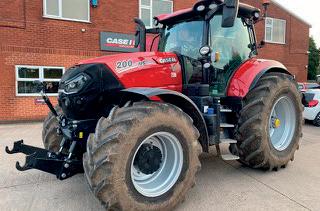



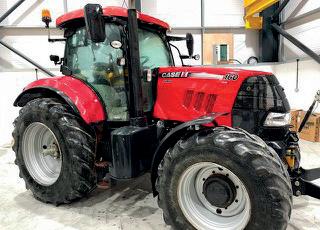


NEW ISUZU DMAX
DOUBLE CAB AUTOMATIC
+ VAT.









+ VAT
ISUZU DMAX DL40 DOUBLE CAB, canopy, lots of spec. 2021, 65735 miles
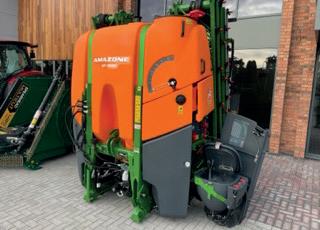




WEIDEMANN
TELESCOPIC FORKLIFT,
NO VAT
ISUZU DMAX UTAH DOUBLE CAB AUTOMATIC 2019, 44130 miles





JCB 520-40 TELESCOPIC FORKLIFT, 2017, 2800 hours,











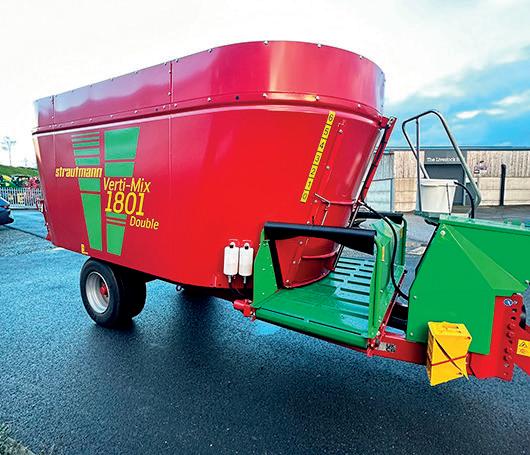


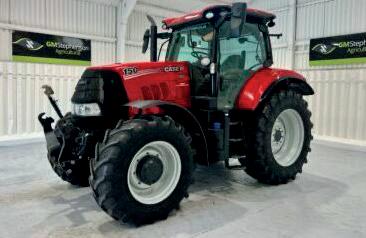




















When it comes to considering a new material handler, a number of leading manufacturers come to mind. James Huyton takes Manitou’s current range-topping pivot steer offering on-test to see how it performs.



Manitou’s MLA-T 533-145 V+ ST5 is no newcomer to the pivot steer market having made its debut back in 2017.
During the intervening seven years, Manitou has continued to make improvements to its range-topping pivot steer.
The handler’s name may appear somewhat of an alphabet soup, so what does the array of numbers and letters actually mean?
The MLA indicates the articulated nature of the machine, while 533 denotes the maximum lift height and capacity of 5.2 metres and 3,300kg, respectively.
The V+ indicates the machine’s variable speed hydrostatic transmission and, finally, the ST5 designation displays its stage V engine

emissions generation. Farmers Guardian put one to the test on a North West dairy farm to see if the Manitou cut the mustard among its market contenders.
Some readers may remember Manitou’s acquisition of the design rights to Irish firm Redrock’s pivot steer in the mid-2000s. However, Manitou says the current model has been designed from the ground up by the French manufacturer and is assembled in the brand’s Italian Castelfranco factory.
A pivot steer handler’s ability to tackle tight spaces and negotiate corners around compact livestock yards has made them a firm favourite on many UK farms, often with more traditional buildings.
Tasked with mucking out, loading ration and general yard duties gave a good insight into how the MLA pivot steer would perform.



PACKING a multitude of regulatory emissions features into any machine’s engine bay is no easy task, but has become a commonplace requirement for all manufacturers when fitting stage V engines.
Manitou has made a great effort to incorporate the engine from German-manufacturer Deutz into the handler’s design without a significant compromise to rear visibility.
Much of the diesel particulate filtration (DPF) system is neatly packed below the contoured bonnet leaving just the exhaust tip on show.
Regular users of any handler in tight spaces will be aware the bonnet will likely take a knock or two over its service life.
Reflecting this, the manufacturer has incorporated a sectional bonnet design which divides the assembly into three parts which can be changed individually depending on the damaged area.
Under the bonnet, users are greeted by a well laid-out engine bay with many serviceable components brought from remote locations for easier access.
Hydraulic and diesel filters clustered at the rear left-hand quarter, with the oil filter being more awkwardly located through a gap in the engine bay.
MANITOU refers to the MLA’s M-Vario Plus transmission as a next-generation hydrostatic (continuously variable transmission) system, which utilises a single pump to drive two motors into the driveline.
Manitou claims this system provides the MLA with more pushing power when needed at speeds up to 19kph.
When travelling at 19kph and above, the machine switches to a single motor. In use, operators could feel a notable jump as the unit switched between motors.
As with most hydrostatic CVT transmissions, no operator intervention was required to change modes.
Returning to the yard from higher-speed road travel, the single-motor operation would often remain, until a higher tractive force of the two motors was required.
On occasion, a blip of the

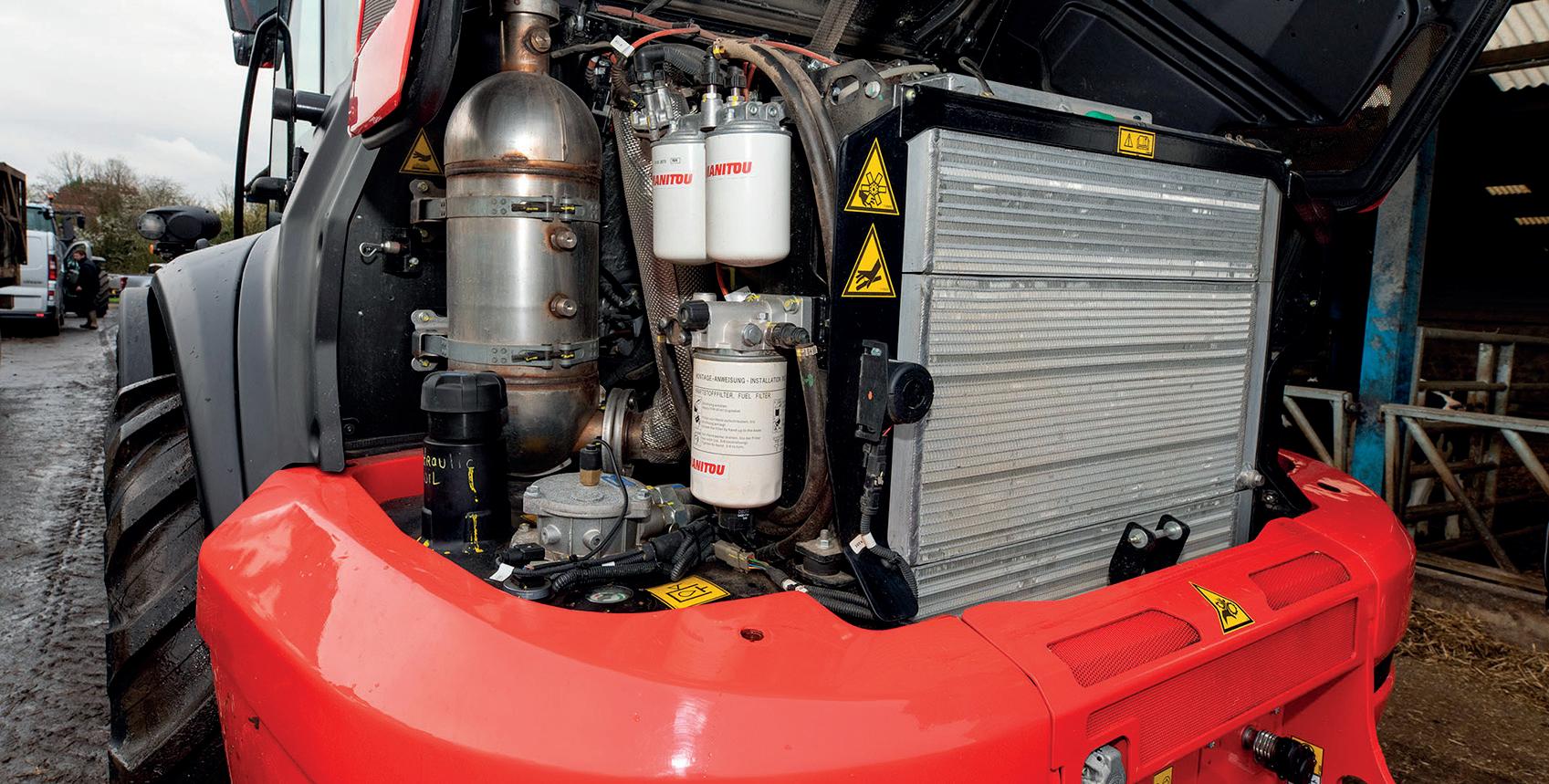
To address this in part, Manitou has added a detachable hose to the machine to aid the release of spent oil.
Both fuel and Adblue filling points were located under the bonnet and protected by the counterbalance casting.
With the radiator mounted at the rear of a pivot steer, this often reduces the risk of straw and dust build-up compared to rigid machines with side-mounted engines. For users in particularly dirty environments, the MLA can be specified with an optional reversing fan on the radiator.


throttle could be used to engage the system for loading work.
The choice of transmission type between hydrostatic and torqueconverter can often be chosen purely by operator preference.
Some users will prefer a transmission with selectable gears over hydrostatic, partly due to the nature of a hydrostatic continually
offering an increased speed with increased engine throttle.
To allow more speed control and partially counter this, Manitou has provided a speed limitation system. Controlled through a dial to the right of the joystick, it can set the operational speeds from 0-18kph. This can allow the operator to set a maximum

Two motors engage in the hydrostatic transmission system to give greater pushing power on yard applications.
forward speed, irrespective of the engine rpm.
In addition, a hand throttle can be used to set the engine speed to suit the job at hand.
When loading farmyard manure, this provided singular control of the forward speed and inching through the throttle pedal, with a set engine speed.
Continues over the page.

Specification
■ Engine: 143hp four-cylinder Deutz
■ Lift capacity: 3,300kg
■ Lift height: 5.2 metres
■ Transmission: Hydrostatic (40kph)
■ Wheelbase: 2.5m
■ Height: 2.7m
■ Wheel size: 500/70R 24
■ Price as tested: £131,000
FOLLOWINGsupplyissueswith cabinsassembledbyasubmanufacturerinthemid-2000s Manitouoptedforanin-housedesign andbuildforthecurrentMLA.
Notably,thecurveddesign oftherearcabinwindowsimproves rearvisibilityinconjunctionwith thesweepingshapeofthebonnet.
Unlikesomebrands,the manufacturerhasretainedaccess doorsateachsideofthecabin, withapin-backfunctionandtop openingforventilation—both viewedasawelcomefeature.
TheElitespecificationmodeltested includedafullLEDlightingpackage mountedonboththecabandboom.
Manitouhascarriedmuchof thebrand’sstyleandfeaturesinto thecabin,includingitsergonomically designedjoystickwhich,aftersome timespentonthemachine,hada veryintuitivefeeltoitsdesign.
Notablyoneofthejoystick’s lessintuitivefeatureswasthe deadmanbutton,denotedinblue.
Pressingthebuttonactivated thejoystickforuse,butperiods ofnojoystickmovementledto thesystemre-lockingwhichcould occasionallycausesomeirritation.
Manitousaysthispush-button designhasbeenreplacedon2024 machineswithathermaltouch sensingmodulewhichaccounts
fortheoperator’shandonthe controlstounlockthesystem.
Theunitusesafullydigitaldisplay onthedashboardfortheusual gaugesandfluidlevels.
Thedashboarddidcontain allthedailyinformationanoperator wouldrequire,butitssizeand crowdednaturecompromised theabilitytoreadmuchofthe informationataglance.
Themainoperatingarmrest, however,hadaclearandwellpresentedarrayofdialsandthe fullyretractableconsolemade accesstotheoffsidecabineasier.
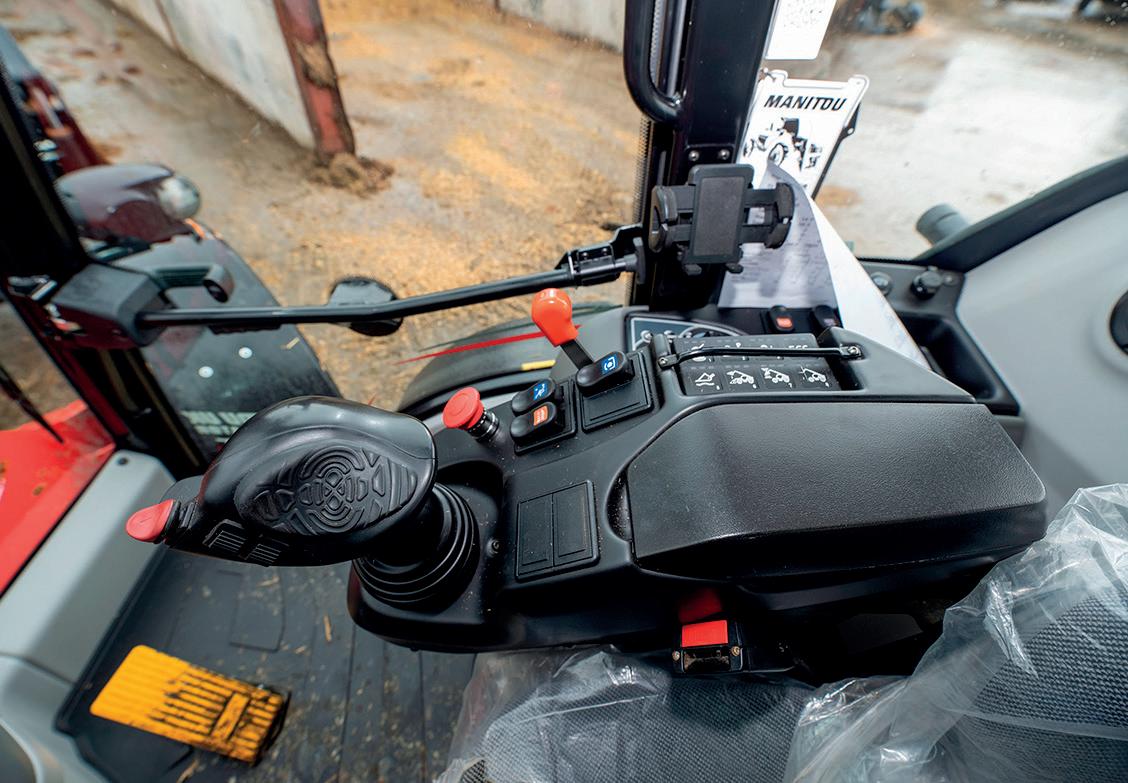

Thetestmachinewasalsowell equippedwithasizeablecoolbox incorporatedintothecabin.Asplit floormatalsomadeforeasierremoval andcleaning.











UNLIKE other manufacturers, Manitou has opted for a twincoupled system, which directly links the motion of the front axle with the rear and removes any lateral oscillation between the front and rear steering sections.
Four wheel ground contact is provided with a pivoting rear axle, similar to the design of a rigid machine.
The manufacturer claims this chassis layout provides greater boom stability when working at height, as the mass of the engine and cab are used to keep the boom stable.
This design method also provided greater protection of the prop shaft and main hydraulic hoses via the underside with the fitment of a steel connecting plate.
Mounted directly under the boom, the main hydraulic valve chest was easily accessible through the removal of four bolts and a panel, which gave full access to the area for servicing.
Located on the other side of the pivot point, the pump sits at the rear of the cabin.
This layout enables the manufacturer to simplify the hydraulic hose routing through the pivot and reduce the number of hoses subject to constant movement.
The Elite specification model featured was supplied as standard with Manitou’s Intelligent Hydraulic system.
The system allows an increased quantity of hydraulic functions offered on the machine.
These include a return to dig feature, bucket shake, constant flow for bucket brush and independently adjustable oil flow for third services.
Multiple functions can be enabled to function simultaneously.
During the test, farmyard manure was loaded from a midden with a bucket and, when clearing a pen, a fork and grab were used.
On both occasions the return to dig and bucket shake functions aided the operator both in emptying the bucket and, quickly bringing the bucket back to a set height from the floor ready for the next cycle.
When using the grab, the oil flow rate to the third service was easily adjusted by an in-cabin dial.
The hydraulics were viewed as responsive during daily loading tasks around the yard, with different operation modes provided.
Put in dig mode, the handler produced more capacity to push, lift and load without overloading interference. Pallet mode increased the hydraulic output and made the transmission more sensitive to finer movements.
In addition, three selectable modes also gave the operator choice of boom suspension, fixed hydraulics or auto which engaged boom suspension once the machine travelled at speeds greater than 10kph.



THE Manitou MLA surprised our test team with its power and performance for a machine that sits slightly smaller in stature and rated power than its competitive counterparts.
Like many machines, brand familiarity counts for a lot with prospective buyers with the look and feel of some of the machine’s design features not suited to all users.
However, any prospective pivot steer buyers should view the MLA as a worthy competitor to other market options.
Serviceability, long-term maintenance and repair had been considered with filter locations, remote greasing points and the option an auto lubrication system.
The location of the valve chest in relation to the pump appeared
to have been designed to aid longer service life, and make the replacement of failed hoses easier.
The cab design and glazing made for good all-round visibility, although the test machine would have benefited from the optional reversing camera.
The range of adjustable operational settings made it a very configurable machine, easily adaptable to multiple operators and tasks.
Although the test machine offered a view into the top specification option of the range, it was clear to see the manufacturer had put a lot of thought into the design and build of the MLA to tempt prospective buyers away from other established pivot steer manufacturers.


Feeding even a small herd of cattle can be a labourintensive business, and choosing the tools for the job can present dilemmas.
The trailed feeder-mixer wagon is universally popular in the UK, with self-propelled machines considered to be the preserve of larger herds.
But Stephen Potter, who rears pedigree Blonde D’Aquitaines at West Harptree, Somerset, thinks otherwise. He has used a 13-tonne capacity Siloking 1612 Prestige, imported by Kverneland, for 10 years.
He says: “The animals have to be fed every day, and a trailed machine can tie up a telehandler and tractor for several hours.
“We use a contractor for all of our fieldwork, so really only need a tractor to pull a slurry tanker. The telehandler is used for cleaning out and bedding down, and taking it out of the equation for feeding frees it up to give added flexibility.”
The farm’s JCB 542-70 telehandler offers plenty of power and capacity, and the current model was recently purchased.
“We would normally only aim to keep a telehandler for five or six
The milling head is driven by a chain on the offside, which can be vulnerable when working on the edge of the clamp.

Although feed wagons seem to be getting bigger, there still remains a place for smaller self-propelled units. Jane Carley reports.


years, but we get good value out of them in this way and the last machine justified the significant investment for this one,” says Mr Potter. The herd stands at 60 cows and 12


replacements, calving in the autumn and spring.
Running a family enterprise on 110 hectares, Mr Potter has been breeding cattle for 44 years and manages the farm alongside an abattoir business in Swindon. He is slowly building up the herd size and employs one herdsman.
“The Blonde bull we have is a good provider of females, so he is good to use for suckler replacements which are high growth and later maturing. I have used a Devon bull on heifers and tend not to keep the calves from heifers,” he says.
Rations are kept simple: calved cows get maize in addition to the silage and hay fed pre-calving; and youngstock get maize, grass silage and barley, plus a soya-based 40 per cent protein mix.
Mr Potter says: “We make our own silage, but the goal is bulk as we are in the Countryside Stewardship scheme. In 2023, we were unable to make any hay due to the conditions, so the hay we are feeding now is two years old.”
Mr Potter purchased his first feeder, an Italian-built machine, some 27 years ago. Difficulties in sourcing parts led him to look elsewhere when it came to finding its replacement, and in 2014 he swapped to a Siloking 1612 Prestige.
It features a two-metre-wide milling head with reach up to 4.2m high, which cuts material from the clamp using integral knives before transferring it to the tub for mixing.
“The head leaves a clean and tidy
Feed is dispensed into low troughs in the traditional buildings, and reach was a challenge in one shed.




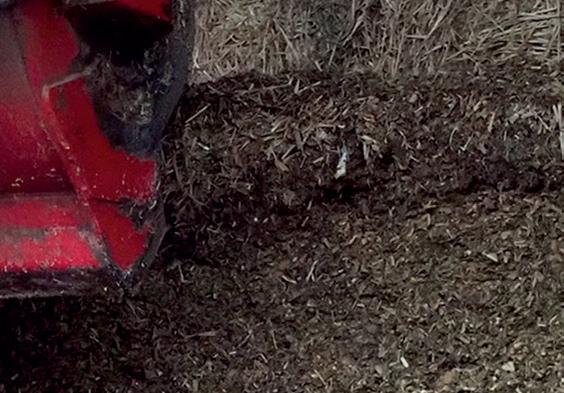
face on the clamp and weighs the ingredients accurately into the tub,” he says.
“Its only fault is that the chain drive for the head rotor is on the side and it is easy to catch it on the edge of the clamp and dislodge it, as the guard has to be fully open for the head to work.”
After transfer to the tub via the elevator, a single auger with flights and counter knives processes the material; barley and protein mix are combined in an Alvan Blanch horizontal mixer and added to the tub via a hopper.
Mr Potter says that, impressively, he has not had to replace the flights or knives in 10 years, and that the mechanism makes a homogenous, palatable mix.
He says: “It takes only about 10 minutes to do the mix, and the single vertical auger design means there are no dead spots, so it is consistent. There is nothing to block and it has one large bearing which is well protected and makes for a highly reliable machine.”
Powered by a 143hp Volvo fourcylinder engine, the 7.7m long feeder wagon has a three-point chassis with a pair of steering wheels at the rear. At just 2.65m tall, it can also fit into lower buildings.
Mr Potter says: “The rear steering took a bit of getting used to, but is highly manoeuvrable around the buildings – more so than a tractor and wagon. The front wheels are directly under the engine, so provide plenty of grip on slippery concrete.”
With hydrostatic transmission and a heated cab, he says that it offers a good operator environment; a basic recording system monitors the load for the 1,5002,000kg capacity tub and the quantities are fed out.
It was originally supplied by Uphill Machinery, but when that company ceased trading the fitter transferred to local JCB dealer RECO, so continuity of backup has been assured. Mr Potter says that there is good access to the engine for maintenance.
“Build quality has proved to be very good; there is wear and tear in the form of a damaged plastic moulding at the front and one other dent, but that has been it,” he says.
The ration is fed into troughs, and the Siloking has a lower tub base than its predecessor, which means that it has to be further away from the edge for the chute to throw over correctly; one feed passage had to be widened to accommodate this.
“When I buy another one, it will have a taller base,” says Mr Potter.
Feeding continues year-round; the wet conditions locally mean that animals are housed from mid-November to the end of April, while finishers are kept indoors.
Mr Potter estimates that the Siloking could feed 140 cattle in an hour, and a pair of smaller machines could be a good investment for larger herds.
He says: “You are totally reliant on the feeder wagon; if you have a large herd and a single high-
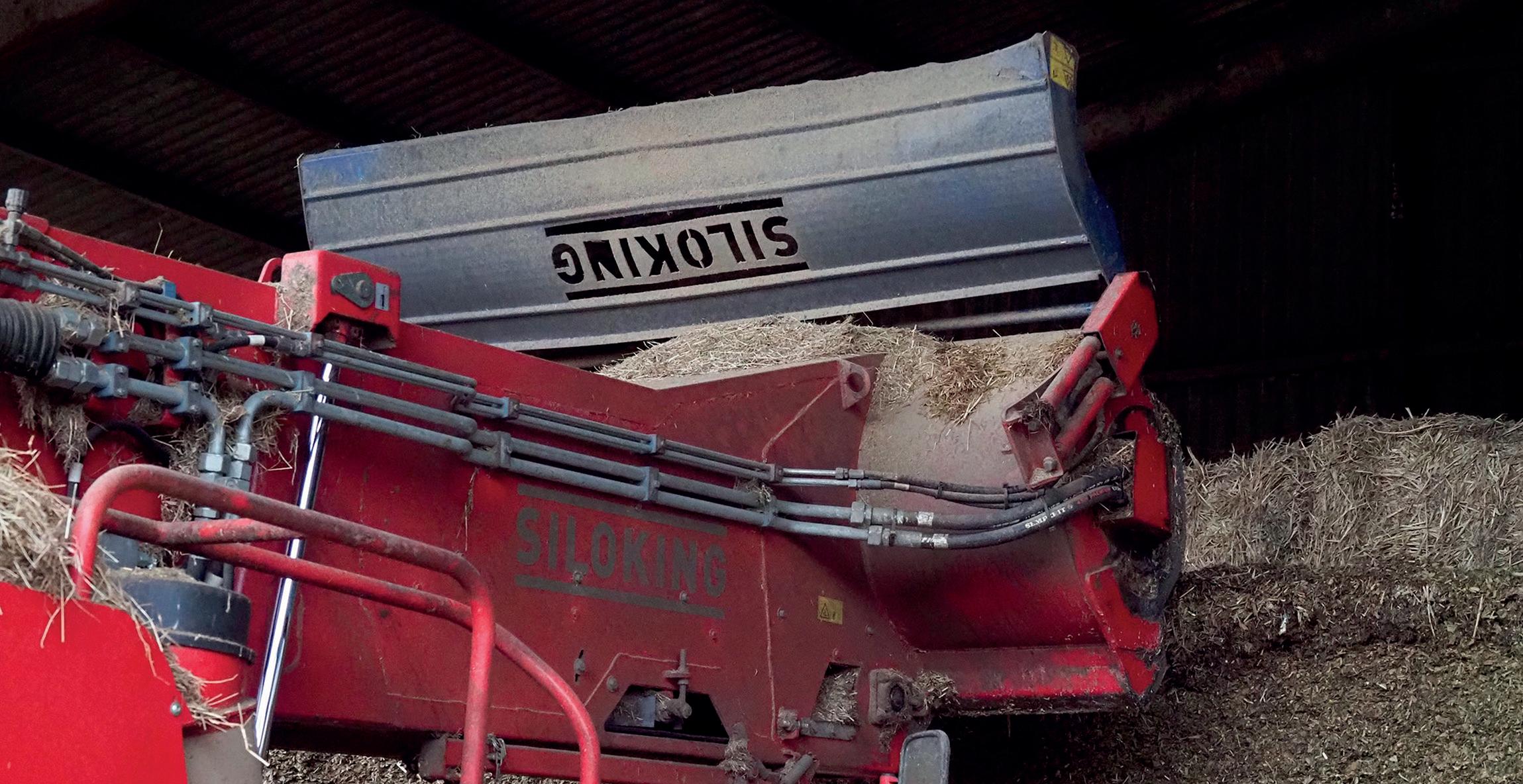
capacity machine, you cannot feed if it breaks down. Yet, there is no second-hand market for the smaller machines as most farms


look to trailed feeders, so I may have to continue using this one as long as it remains serviceable.”





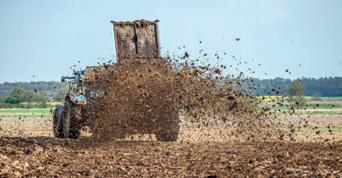







Italian telehandler manufacturer Dieci has introduced a new flagship to its pivot steer range, expanding the line-up to three models. Toby Whatley reports.
Lesser known to some, Italian manufacturer Dieci produces both rigid and pivot steer machines for the agricultural and construction sectors.
The business has a strong presence it its home market and has made changes to its UK and Ireland-focused pivot steer range.
Added as a new flagship T80 model to sit above the existing T60 and T70 models, the machine features a redesigned cab, which claims to offer users more legroom, a visually improved instrument panel and improved visibility with changes to the glass surfaces and an increased height of the operator seat.
A new joystick and armrest has been included to provide improvements in machine functionality.
A maximum lift capacity of 3.5 tonnes is offered to a maximum height of 5.2 metres.
Hydraulic flows of up to 224 litres/min are claimed with the capability to offer four-way simultaneous flow sharing alongside constant pumping for motorised attachments. Power is

provided by a 4.4-litre, 153hp FPT engine powering through its VS Evo2 transmission. Dieci says this design is an electronically-con -
trolled hydrostatic which provides a maximum forward speed of 40kph in addition to a lower-rpm Eco and creeper function.

NORTHAMPTONSHIRE-based Lynx Engineering has expanded its machinery offering with the introduction of the Agribumper range from Dutch manufacturer Safetractors BV.
The system is designed to improve the on-road safety of tractors by adding a machine-width barrier within the front linkage, which can be incorporated with a weight block or toolbox.
The system uses a pair of daytime running lights, indicators, width marker poles and reflector chevrons to improve the visibility of the machine.
Agribumper claims the design of many tractor headlights does not adequately show the machine’s
size and width. Fitting an illuminated width marker improves the visibility of the machine –and its respective size – to other road users.
A version of the marker system can be mounted to the sides of the machine linkage which leaves the front linkage and pto free to carry additional weight or implements, which prevents the bumper from being removed for different tasks. Alternatively, the Agribumper can be supplied with an additional ballast system from 350-2,000kg.
Lynx will be displaying the range at events throughout 2024, with all versions of the system offered in the respective brand colours of the tractor it is operated with.
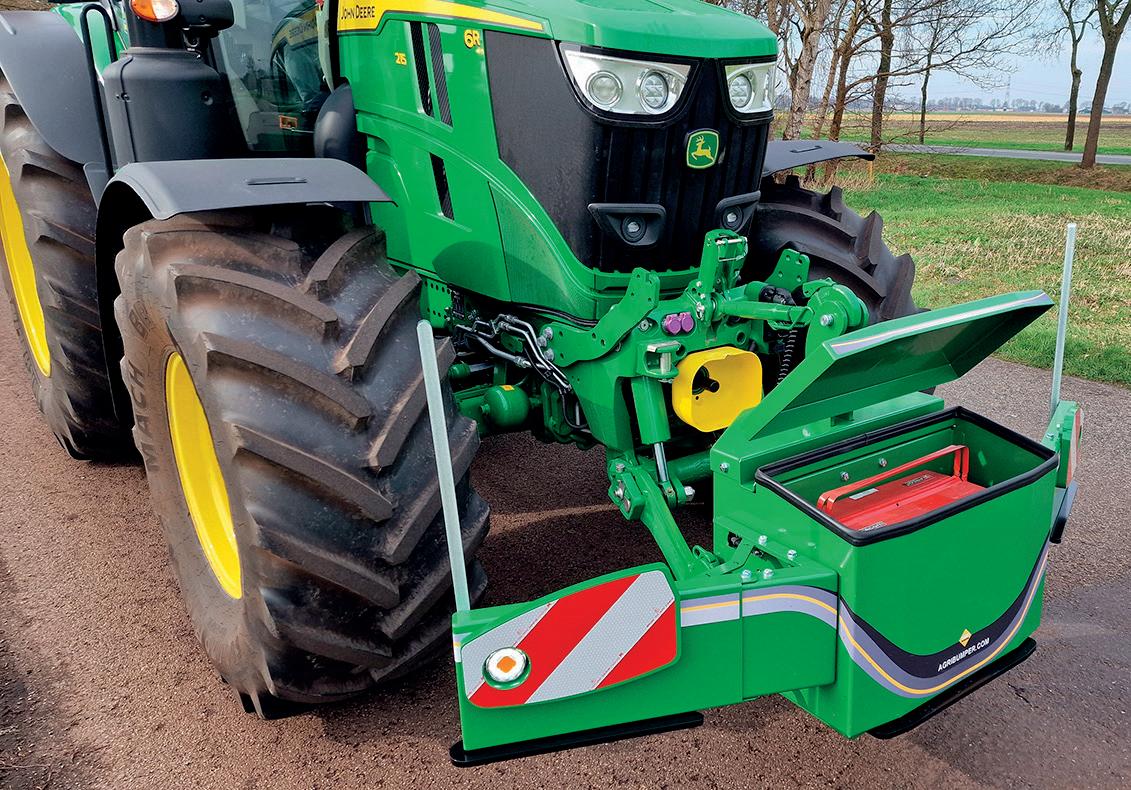












There is often a perception when entering that you have to be the biggest and the best, but we aim to showcase innovation, dedication and adaptability, no matter the size and scale of the business.








Edited by Katie Jones – 07786
856 439 – katie.jones@agriconnect.com
Optimal establishment of clover swards is vital for farmers to experience the benefits of nitrogen fixation and improved productivity. Katie Fallon reports.

ONE of the most underused crops onfarm, clover holds many benefits for farm businesses, from mitigating the environmental impacts of fertiliser use, to improving productivity in livestock systems.
That was the message from William Fleming, grassland specialist and area sales manager at Germinal GB, at a recent AHDB ‘curious about clover’ event, held at Harrison and Hetherington’s Borderway Mart, Carlisle.
Not only can clover help with nitrogen fixation in the soil and improve soil structure, said Mr Fleming, but clover swards can also result in increased dry matter intakes due to the high palatability of clover among sheep and cattle.
Mr Fleming said clover swards can also have higher protein levels, higher digestibility and result in higher overall herbage yields.
He said: “Studies have shown increased milk yields in herds which were fed rations including clover leys.”

Clover leys
Due to the multiple benefits of clover within livestock systems, particularly surrounding its nitrogen-fixing qualities, Mr Fleming suggested clover could help make livestock systems more sustainable.
TO get the most out of clover swards and ensure optimal nitrogen fixation, consultant Andre van Barneveld, of Graise Consultancy, said good establishment of swards was key and he shared some ground rules for establishing clover in the UK.
He said: “Successful clover establishment revolves around creating a suitable environment for the target species and minimising competition.”
He advised removing the previous sward, any weed burdens and unwanted grasses was key to the successful establishment of clover.
To ensure optimal nutrient efficiency and environment for legumes, soil pH and nutrient content is key when looking at clover establishment, particularly the calcium and magnesium ratio.
Mr van Barneveld said: “The more you learn about soils the more you realise that this ratio is the driving factor for almost everything in the soil.”
He advised looking at calcium together with magnesium when carrying out soil tests.
“The optimum ratio is 1:6, six times the amount of calcium as magnesium.”
The correct phosphorus (P) and potassium (K) levels are also required for successful clover establishment, and Mr van Barneveld advised nitrogen was not required at the time of sowing.
He said: “We want root development which drives the system and drives growth. If the plant has excessive nitrogen, it will affect photosynthesis.”
He explained nitrogen fertiliser was one of the biggest emitters of greenhouse gas (GHG) emissions in the agricultural industry, with a total of 390Kt of nitrogen fertiliser added to UK grasslands each
He advised waiting until the plant was well established, and at the two-leaf stage of growth before applying slurry or farmyard manure.
Mr van Barneveld advised a soil temperature of 10-15degC when sowing clover.
“Moisture is really important. You need enough moisture to get the seed established, but not swimming.”
He also advised a sowing depth of no more than five to 10mm, and recommended rolling fields before and after sowing.
“Rolling before sowing helps to create a firm seed bed to hold the moisture in and help the seed establish, but we do not want to be squashing the soil giving it no air to breathe. Be mindful and make careful decisions around rolling as the moisture must be right.”
year, equal to 1.4 million tonnes of carbon dioxide produced during manufacturing.
As a result, Mr Fleming said reduced nitrogen use was a key player in reducing agriculture’s environmental impact and highlighted the importance of clover swards in achieving this.
He said: “There is the fear of Government enforcing legislation on agriculture to reduce GHG emissions. We do not want to be in a position where we are forced to make changes.
“We have to try and mitigate that, which is where clover comes in due to its ability to fix nitrogen.”
Studies have shown increased milk yields in herds which were fed rations including clover leys
AN increase in liver fluke problems is also putting cattle at risk of clostridial diseases, such as black disease, says Dr Kat Baxter-Smith, veterinary adviser with MSD Animal Health.
Dr Baxter-Smith says the liver fluke threat in 2024 is expected to be later than normal due to unusual weather patterns in 2023.
This, she says, means cattle livers are in danger of being rejected because of fluke and, in some cases, this liver damage could also allow the clostridial bacteria C. novyii to gain a foothold with rapid death often the result.
Dr Baxter-Smith says: “Consequently, associated black disease is emerging as a significant and potentially catastrophic issue.
“The tissue damage caused by flukes migrating through the liver provides an ideal breeding ground for clostridia bacteria. Clostridial toxins kill quickly, and these diseases present few clinical signs before death.”
To counter this, Dr Baxter-Smith advises using a broad spectrum clostridial disease vaccine. And she says the rise in liver fluke infections and associated black disease is not the

only reason why broad-spectrum clostridial vaccination has become more popular.
She says it was once the case that blackleg was the only clostridial disease cattle producers were aware of, but now additional clostridial bacteria, such as C. sordellii and C. perfringens A, have also been identified as causes of sudden death on UK cattle farms.
Scotland
39.1kgdrymatterperhectareperday (15.8kgDM/acre/day) 28.8 6.5 16.6
The North
41kgDM/ha/day (16.6kgDM/acre/day) 29.4 7.4 19.2
Wales
33.4kgDM/ha/day (13.5kgDM/acre/day) 27.3 8.1 14.1
The South
34kgDM/ha/day (13.8kgDM/acre/day) 30.9 8.6 7.2
Grass growth Soil moisture (cb)
Soil temperature (degC) Rainfall (mm per week)

FOLLOWING recent heavy rainfall, concern has been raised about forage quality because of mineral leaching from the soil.
Iodine, in particular, has been identified as an essential micronutrient required by cattle which has been lost as a result of recent weather conditions.
Emily Hall, of Nettex, says an iodine deficiency is linked to thyroid enlargement and calves being stillborn.
Soil health is a main contributor to iodine losses and heavy rainfall which causes surface run-off and soil degradation has left parts of the UK at risk.
Dr Baxter-Smith says: “The sheep industry already recognises the importance of broad-spectrum vaccination against clostridial diseases, but more cattle producers are recognising the benefit.
“Over the last few years, there is increased incidence of different clostridial diseases in far from typical circumstance.”
Shane Brewer, of soil testing specialists Eurofins Agro UK, says that with such heavy rain this year, farmers should be analysing soil more regularly to establish mineral losses.
He says that understanding the effect of adverse weather conditions offers farmers the opportunity to adapt nutrient management programmes to put back into the soil minerals which are lost through leaching.
■ Slightlylowerrecordedsoil temperatureshascurtailedgrowthin theregions.Grassgrowthispredicted tofallbelowthefive-yearaverage overthenextweektoabout20kgof drymatter(DM)perhectareperday (8kgDM/acre/day)mainlydueacold spellintheweatherforecast
■ Therecentheavyrainhasleft groundconditionstenderwhichhas
limitedtheopportunitiesforgrazing andfertiliser/slurryapplications
■ Grassqualityremainsgood, withametabolisableenergyof 11.2andproteinof18.4
■ Weeklygrassmeasuringiscritical tokeepcontrolofaveragefarmcover; useofagrassbudgetingtoolwill helptoidentifywaystocorrecta surplus/deficit
GrassCheckGB is a collaboration between The UK Agri-Tech Centre, Agri-Food and Biosciences Institute, Rothamsted Research, AHDB, Hybu Cig Cymru, Germinal, Handley Enterprises, Sciantec Analytical, Yara, Pilgrim’s UK and Quality Meat Scotland. Regular updates will appear in Farmers Guardian.
A focus on the milking routine can be a useful tool to help reduce mastitis incidence and vets can play an important role in this. Wendy Short finds out more.
rVet observation offers valuable insight
A VET visit during milking time can help to reduce the incidence of mastitis by pinpointing possible causes, says vet Will Sommerville, of the Wiltshire-based George Vet Group.
He adds that milk bacteriology testing prior to the vet visit will highlight the specific pathogens linked to herd mastitis. This will help to identify potential infection sources and allow for targeted treatment.
Before the observation session, which usually takes place during afternoon milking, Mr Sommerville says he will review the herd’s mastitis history and look at the timing of recorded cases.
“If most cows have clinical mastitis cases in the first 30 days of lactation, the infection source is likely to be associated with environmental conditions in the dry and calving periods.
“Meanwhile, a spike in case numbers post-30 days is usually connected to the milking environment, or contagious mastitis.”
He says taking action to minimise the risk of mastitis should start before the cows enter the parlour.
“It is important to avoid rushing the cows into the parlour as it causes stress, which in turn will inhibit milk let-down and predispose the cow to teat damage and subsequent infection,” adds Mr Sommerville.
“Correct udder preparation is another critical factor and the aim is to have a period of 60-90 seconds between first touch and cluster application. Every operator is different, so the number of cows handled at a



A case of mastitis is estimated to cost the business £300 on average, so a rise in cases should prompt investigation into the milking routine, as well as a check on the parlour setup.

time will vary, according to the speed of preparation.”
He has a recommendation for the pre-milking hygiene routine.
“The goal is to have clean, dry teats and the gold standard is to use a dip cup containing a rapid-kill disinfectant, followed by a wipe with a dry paper towel. Spray solutions do not always achieve optimum coverage and while medicated wipes save time, they are not fully effective.”
If most cows have clinical mastitis cases in the first 30 days of lactation, the infection source is likely to be associated with environmental conditions in the dry and calving periods WILL SOMMERVILLE
Mr Sommerville reminds milkers that applying the cluster too soon increases the risk of mastitis and it will not speed up milking in the long term, due to poor milk let-down. This will be evident because cows may fidget, or even kick off the cluster, due to discomfort. The same applies to the behaviour at the end of the process, when it can be a sign of over-milking.
During milking, he recommends a strict hygiene routine for the operator.
“Research has shown that freshlywashed hands can still be harbouring the mastitis-causing bacteria, staphylococcus, for example.
“Therefore, gloves are a must, and the re-usable latex type are the best option. Gloved hands should be washed at the end of each line of cows in a general detergent, or in diluted peracetic acid.”
Checks on milking systems which use automatic dipping and flushing and automatic cluster removal may also be carried out during the vet visit.
“All four liners on the unit should be thoroughly flushed with automatic systems and they should achieve coverage of most of the barrel and teat. A system failure may mean that only the tip of the teat is being treated. If that is the case, the timing and liquid volume settings may need adjustment.
“For parlours using automatic cluster removal systems, evaluating the flow rate for cluster removal activation is very important,” says Mr Sommerville.
“Incorrect settings can lead to over-milking and exert high pressure on the teat end. The standard setting is about 450ml per minute for cows milked twice a day, but it may need to be altered to suit individual herds.”
If over-milking is suspected, Mr Sommerville recommends conducting a post-milking strip yield test, which involves stripping each quarter for 15 seconds and measuring the level of collected milk. It should be within a range of 40-100ml per quarter.
Teats should also be examined post-milking, he adds.
“Excessive pressure from poor milk let-down or over-milking can lead to hyperkeratosis, which is a thickening of the skin which lines the teat canal and the external orifice. It has been associated with a heightened risk of clinical mastitis. There will be a proliferation of skin and a roughening of the teat, with ‘fingers’ of keratin that are often brown in colour.
“Hyperkeratosis is thought to predispose the cow to mastitis, because it prevents the teats from being thoroughly cleaned and disinfected. It can often be traced back to problems in the parlour system,” he adds.




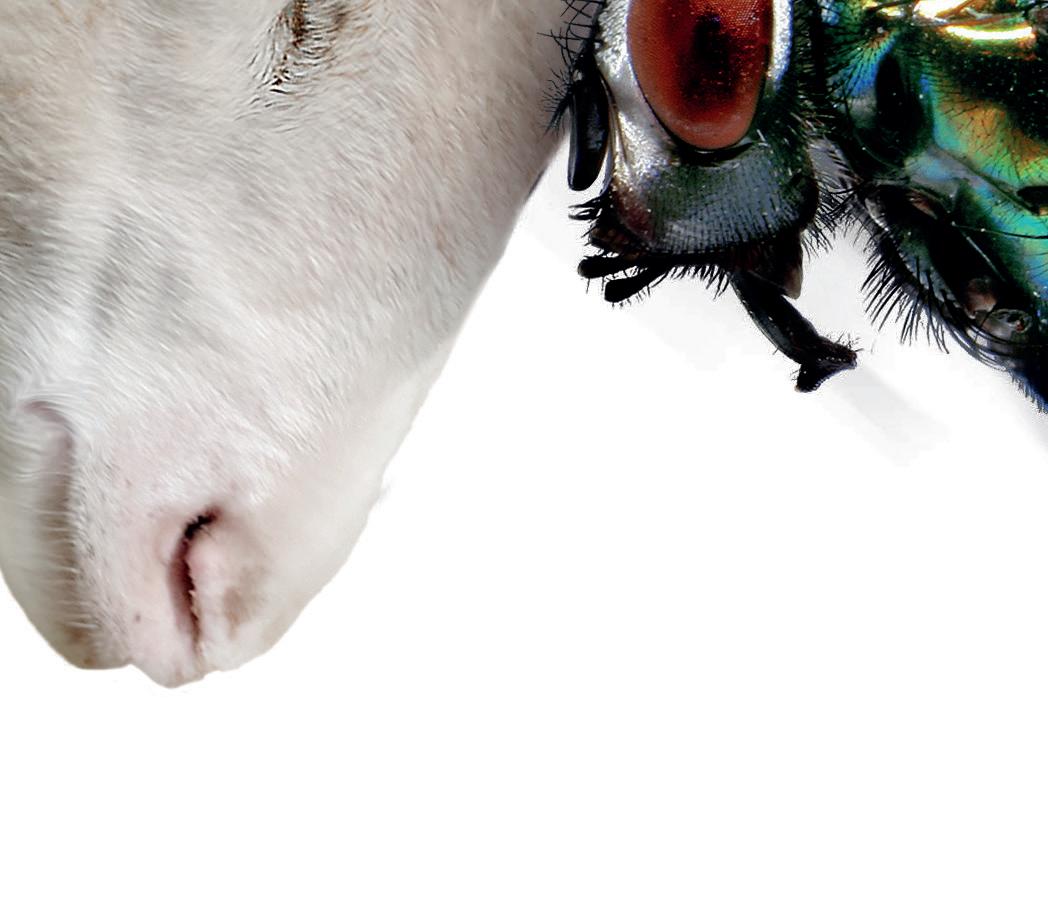



first with CLiK Preventative treatment of ewes and lambs is always the most cost-effective strategy against blowfly strike.1













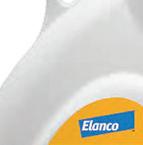
















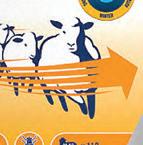








To find out more on preventing blowfly strike on farms visit: www.farmanimalhealth.co.uk Weeks’ prevention 8 16



References: 1. K Lihou, Cost of blowfly strike, PM-UK-23-0023
For further information call Elanco Animal Health on +44 (0)1256 353131, or write to Elanco UK AH Limited, Bartley Way, Bartley Wood Business Park, Hook RG27 9XA CLiK™ contains 50mg/ml dicyclanil. CLiK™ EXTRA contains 65mg/ml dicyclanil. CLiKZiN™ Pour On contains 12.5mg/ml dicyclanil. Legal category: POM-VPS Information regarding the side effects, precautions, warnings and contra-indications can be found in product packaging and leaflets; further information can also be found in the Summary of Product Characteristics. Advice should be sought from the
The Pitt family are fourth generation farmers based at Ganderland Farm near Bromyard, Hereford.
Andrew Pitt farms with his wife, Elaine, and father, Alan, with an aim to produce cattle for the store ring and deadweight market using Simmental genetics.
Their 142-hectare (350-acre) unit is situated among some of Herefordshire’s richest soils, and neighbours the Worcestershire border.
The system includes 12 hectares (30 acres) of wheat, 12ha (30 acres) of barley and 10ha (25 acres) of fodder beet, which is grown to help the farm run as self-sufficiently as possible.
There is a flock of 500 Suffolk and Texel cross ewes, which are put to pure Charollais and Texel cross rams and lambed in two bunches during February and March, with 200 ewe lambs kept as replacements.
The rest of the lambs are fattened to 40-45kg and sold liveweight in Hereford market or deadweight through ABP. Mr Pitt rents 33ha (80 acres) of grass for the sheep.
But the heart of the farm’s system, and Mr Pitt’s passion, is the 120-head of Simmental-bred suckler cows.
In the early 1990s, the farm only had a few cattle, but in the middle of that decade a decision was made to increase numbers.
Originally, the farm carried British Blue and Limousin-bred cows, but Mr Pitt said he found they lacked some of the hardiness and longevity he required for his system.
Ease of management and good fleshing ability were two of the main attractions to the Simmental breed for the Pitt family, and 25 years later it is still ticking boxes. Ellie Layton reports.


He says: “A few local farms had Simmental breeding and the character of the cows and the progeny at foot caught my eye, so it started from there.”
Ganderland Farm has mainly heavy red clay soils, so the cows are summered outside following calving until early November, depending on the conditions underfoot.
“We are not susceptible to flooding, but do not want to turn the ground
up. To enhance grass recovery, cattle are kept in until after calving, when they are turned out with their calves at foot,” says Mr Pitt.
All the cows are calved from late April to early June, with more than half calving in the first six weeks.
Mr Pitt says: “Our aim is to keep a tight calving pattern so we can produce a consistent end animal for the


market. The breed is very prolific, and we often have five or so sets of twins, but in 2023 we had eight, which has put a few cows out of sync.
“We have built the herd up to a number we want to maintain, so we select about 25 heifers as replacements every autumn, keeping in tune with the genetics and the cow type we have worked hard to develop.
“Health status is high on our agenda, so keeping our own heifers gives us security and keeps the herd heading in the direction we want.”
Heifers are calved early in the block, as Mr Pitt says he aims to give them a good chance to settle in-calf early as a second calver.
Despite being advised to calve his cows at two years old, Mr Pitt bulls his heifers at 24 months, ready to calve at three years old.
He says: “I understand that there is a push to reduce age at first calving, but I have not made the decision to push the calving age later without evidence. We trialled a selection and found our type of cows are suited to calving when they are more mature.
“Once they have fully developed, I believe it ultimately helps their longevity and allows them to stay in our system longer.”
When selecting breeding stock, one of the most important things for Mr Pitt is easy calving, which has led him to pelvic score all of his potential replacement heifers.
Pelvic scoring is carried out on the heifers at the start of the year, when







they are bovine TB-tested prior to being put to the bull. The pelvis is measured rectally along the horizontal and vertical axis to identify any heifers with a small pelvis.


These heifers will have a higher chance of difficult or caesarean calvings, and it is recommended they are removed from the herd.
Mr Pitt says: “We find the results interesting; a big heifer does not necessarily mean a big pelvis and the same for a small heifer, which is where our selection has previously been misled.


“We find pelvic scoring a cheap and effective way of selecting the heifers for breeding, compared to a caesarean or keeping a heifer that will not be retained in the herd for the duration.”
The farm keeps accurate records, allowing them to record the success of this pelvic scoring process, which they say has been high.



We find pelvic scoring a cheap and effective way of selecting the heifers for breeding
ANDREW PITT
ago and we have not looked back since. Since implementing the scoring, we have not had a caesarean and the process plays a big part in producing cows with longevity.”
However, Mr Pitt says that by continually selecting the heifers with the largest pelvises, there will ultimately also be an increase in mature cow weight. Therefore, he says he is working to maintain modest cow size.
Mr Pitt says: “We work closely with our vet, Nick Gibbon, who suggested pelvic measuring to us about 10 years


Five stock bulls are run at Ganderland, all of which are supplied from the local Bowley pedigree Simmental herd based near Leominster.
Mr Pitt says: “I choose bulls for a variety of reasons and stick true to my preferred type. I have purchased bulls from Bowley now for nearly 20 years, so the farm manager will get a selection ready for me.


■ A family-run beef, sheep and arable farm
■ Herd of 120 pure Simmental cows
■ Feed and cereals grown on-farm to keep costs down
■ Mixed grazing helps to keep grassland clean
“There are about 150 bulls housed when I go to look as I buy them at 14 months old, so there are plenty to choose from.
“They are chosen for their size, and I like some shape going into the second thigh. But, if they do not have a good temperament, they are not an option – no matter the potential.




‘Our aim is to keep a tight calving pattern’, says Andrew Pitt.


cows are nice and quiet, so I do not want this to change.”
Although colour is not a deciding factor, Mr Pitt does say he prefers the darker coloured cattle with a white belt and says they work well for him, often finishing quicker.


He does not like to overwork bulls to support their longevity, so each bull runs with up to 25 cows each, which helps to keep calving tight.
“Docility is a big factor in our herd; I am not as young as I once was and our

At the beginning of February, before calving, the cows are fed a ration of silage, rolled oats and minerals alongside chopped straw at different rates depending on their body condition score.


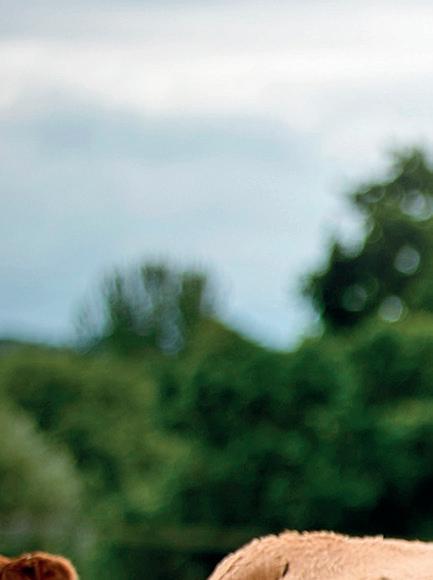








If there is surplus fodder beet from lambing, cows will be buffer fed to promote milk as soon as they have calved. Cows and calves stay in for a week after, and are then turned out to graze.

When coming back inside, Mr Pitt separates the bulls and heifers. Bulls are penned in the yard at the home
farm and fed a silage, wheat, beans, molasses, mineral and creep ration.
When the soya price is high, Mr Pitt feeds beans as a protein replacement, but says this is done with caution due to an increased risk of cattle developing laminitis. He says he has found mixing bicarbonate of soda in the ration reduces the risk of cattle going off their feet.


He says: “Most of the bulls will go off the farm at 14 months old, with the best leaving at 12 months with a target weight of 700kg to kill out at 400kg.
“To keep an eye on margins, we weigh the bulls frequently and use a forecast to track their progress by using their daily liveweight gain and previous groups’ progress.

“Our system is all about cashflow so, depending on the farm’s position, we sell the cattle as stores in Hereford market or deadweight to ABP Shrewsbury, as long as we have a clear bTB status.

“This has been a major problem over the years, although we are hoping we are seeing the light at the end of the tunnel, which has been heavily influenced by the local badger cull.”







The increasingly unpredictable nature of lungworm outbreaks in UK cattle and concern over reduced efficacy of cheap and easy-to-use anthelmintics is prompting a re-think over best practice disease control. Farmers Guardian reports.
rWormer resistance a big talking point
SPEAKING to dairy farmers attending a spring turnout topics meeting organised by the Dalehead Veterinary Group and Farm Gate Vets near Lancaster, Colin Mason from the SRUC disease surveillance centre in Dumfries said questions were now starting to be asked about anthelmintic efficacy.
He said: “Looking forward, we should be worried about resistance issues. Resistance to wormers has been a big talking point in sheep, but we are now starting to suspect a similar situation is developing in cattle. The days of using blanket worming treatments are numbered.
“This has worked for many years because quite simply it has worked, does not cost much and is easy to do, particularly when using a pour-on product. But this is not a sustainable disease management policy.”
Often thought of as a disease primarily in first or second season grazers, Mr Mason said that according to 2016-2020 VIDA data, nearly half (47 per cent) of all lungworm diagnoses are now found in adult cattle.
“Lungworm outbreaks are very unpredictable, but disease generally occurs at the back end of the grazing season as worm burdens build up in naive cattle turned out to grass.
“In the last five to 10 years, we have


Dairy farmers may need to re-think lungworm control as questions are being asked about anthelmintic efficacy.

even started seeing disease outbreaks over winter.
“This may well be because of climate change, possibly because stock remain outside for longer in warm, wet conditions – and well beyond the point when any wormer treatment has worn off.
“Whatever the reason, clinical disease may occur in adult cattle late in the season due to a lack of immunity from natural challenge, immunosuppression due to concurrent disease or a very high worm burden,” said Mr Mason.
Lungworm infestation occurs when cattle eat grass contaminated with larvae from the worm dictyocaulus viviparus, which migrates to the animal’s lungs.
Once there, they develop into adults and produce eggs that are then coughed up and swallowed.
Eggs that hatch in the digestive system are then passed out of the animal through faeces as larvae to contaminate pasture – ultimately starting the lifecycle over again once consumed by grazing livestock.
Mr Mason is a big believer in
vaccination against lungworm pre-turnout, seeing it at as the gold standard disease management policy moving forward.
“If naive cattle are correctly vaccinated before being turned out to face a pasture-based worm challenge, in my view they should not need treatment for lungworm over the entire summer.
“We used to use huge quantities of this vaccine many years ago – and very successfully, but usage dropped away when pour-on wormers were launched. We need to get back to what is a proven, more sustainable disease management practice.
“Unlike long acting anthelmintics, which kill the parasite and reduce or even prevent ongoing exposure and necessary build-up of immunity, vaccination allows cattle to develop immunity to lungworm thanks to the use of irradiated larvae in the husk vaccine.
To help safeguard against financial losses from lungworm and potential developing resistance with long acting anthelmintics, Mr Mason encouraged farmers to work with
In the last five
to 10 years, we have even started seeing disease outbreaks over winter
COLIN MASON
their veterinary professional on a farm parasite control plan.
“Aside from generalised recommendations to implement a vaccination policy and to limit anthelmintic use, it is difficult to offer ‘one-size-fitsall’ lungworm control advice.
“Every farm grazing situation is different, so always discuss your disease risks, ages of animals affected and the worming treatment policy you currently favour to come up with the right sustainable parasite control plan for the future,” he said.



All prices quoted in p/kg.

















Figures show livestock numbers first, then average price per head.
Source: LAA/MartEye
Source: IAAS/ScotEID


Source: LAA/MartEye
Primestock throughput, price and price change (p/kg).
Week ending April 21, 2024.
MARKET prices dipped at auction marts in England and Wales this week, despite improvement in both dairy sired cull cows and pigs.
Sheep prices dropped the most by 19.6p/kg to 386.1p/kg.
In the cattle rings, young bulls fell by 4.5p/kg to 260.6p/kg, while heifers decreased by 2.9p/kg to 271.7p/kg.
Steers also reduced in value by 2.0p/kg to 270.5p/kg, in spite of dairy sired cull cows increasing by 6.3p/kg to 161.7p/kg.
Pigs shot up in value by 12.9p/kg to 172.4p/kg, despite a decline in cutters and baconers.
As Farmers Guardian went to press on Wednesday (April 24) UK LIFFE wheat prices for May 2024 were trading at £177.90/tonne, up £4.40/t on the week.





O/SdeadweightpricesfortheweekendingApril20,2024.
E
U 878.5
DeadweightsheeppricesarecollectedfromasampleofGBabattoirs.Thesampleaccountsforabout one-thirdofdeadweightsales;pricesquotedp/kgareaveragesforallqualities12-21.5kg.



GOOSTREY: Mon, hay, square bale to £158/tonne, round bale to £172/t; haylage, square bale to £174/t; barley straw, square bale to £178/t; wheat straw, square bale to £144/t; mixed straw, square bale to £130; silage, square bale to £106; fodder beet to £44/t.
BIODIVERSITY NET GAIN: English:Defra estimates£25,000-£200,000/unitexcluding VATandassociatedfees,subjecttolotsize. LasttenderMarch8,2024,nextApril19,2024.
NUTRIENT NEUTRALITY: Long-termsales alltypesagricmanexcludingspecialisthabitat creation.Nitrates£3,000-£4,000/unit(£18,000£206,000/ha);phosphates£50,000-£65,000/ unit(£2,000-£169,000/ha). CARBON: Woodland Carbon>£35/WCU>£25/PIU.May2023WCG reverseauctionaverage£19.76. WATER: English abstractionlicenceslessthan£3-£15/cu.m.
Source: Townsend Chartered Surveyors




January 2024
Source: AHDB
1.Thiscontractwillreceivea1.33pplguaranteedminimumpayment.
2.Thiscontractwillreceivea0.50pplmemberpremiumpayment.
2.Thiscontractwillreceivea1.54pplTescocheesegrouppayment.
3.Thiscontractwillreceivea1.00ppldirectpremiumpayment.
4.Thiscontractwillreceivea0.40pplactual13thpayment.
5.FormerlyGlanbia-Llangefn.
Retailerpricesupplementsareincludedwhereapplicable.Supplementslistedareinadditiontolistedmilkprices.
UK milk deliveries in January 2024 were down 0.3 per cent on the year at 1,241 million litres. Cumulatively, this was 0.4 per cent down on the year to date. January 2024 GB milk deliveries were down 0.6 per cent for the same period at 1,024m litres. GB milk deliveries for the year to date were 0.5 per cent down.















Organic dairy farmer Sophie Gregory has thousands of followers on social media and she is using it as an opportunity to go behind the scenes of the sector. Emily Ashworth finds out more.
HAVING fallen in love with the industry, Sophie Gregory’s mission is clear: farming is a great place to work and everyone should have access to it.
Farming on the Dorset and Devon border near Lyme Regis, Sophie and her husband Tom are organic dairy farmers.
For Tom, farming has always been his passion, but for Sophie, it was something she took a risk for. It was certainly the right decision though, after formerly training as an accountant.
Farming across 567 hectares (1,400 acres), she is passionate about the sector and through social media, her current Nuffield Scholarship and education and charity work, showcasing her views on the organic sector and career opportunities is at the forefront of all Sophie does.
Sophie and Tom have always farmed organically, more so because it ‘suited the farm’ and, as Arla farmers, they were part of the co-operative’s regenerative farming pilot.
“There are eight farms in the UK trialling different things – we meet up twice a year and, as a European group, twice a year,” says Sophie.
“My husband is leading our [trial] which is composting our farm manure.
“It is quite a wild farm; there is a lot of nature here already and [it is] low input. We have been growing herbal leys for quite a while and have been using clover too – it is really good for the soil.”
Her current Nuffield Scholarship is an extension of her love for organic. It is titled: What is the future for organic dairy farming?
She wants to research into successful – and unsuccessful –organic dairy markets in other countries, while exploring how to really connect to the consumer.
The goal, she says, is to find something that will impact her own business as well as the organic sector.
“We are struggling as an organic dairy farm,” she says.
“Consumers do not really understand what [organic] means and whether it warrants them paying extra for it on the shelf. They are confused about what they are paying for.
“It is different in other countries, so how do we bring that back to the UK?
“Sri Lanka brought organic in overnight and it destroyed the economy; it is the obvious one to see where it went wrong.
“India has a huge volume of organic, partly because they are small-scale.
“Taiwan is 25 per cent organic and there is a huge policy around getting to 50 per cent, but there are huge subsidies around it and they see organic as the environmental solution.
“I will be going to America because organic dairy means something different there – if you had a pizza with an amount of organic produce on it you can call it organic.”
Milk sales, she says, are ‘pretty stagnant’. Couple post-Covid-19 life with the cost of living crisis and it is no wonder consumers are shopping differently.
But she does believe consumers want the story and they need to know
more – they are aware of no chemical or fertiliser use, but not what else they get from organic.
The other looming question is, does the sector need more support in terms of policies?
She says: “Denmark and Sweden have a really successful dairy industry – their aim is 30 per cent organic.
“Sixty per cent of foodservice has to be organic in Denmark and they hope this will lead to people buying it for their homes.
“They have a budget range organic, a middle range and high, and it is very accessible.
“In the UK it is like a premium brand which puts people off; that is how shoppers associate it and people think it is not for them.”
On Instagram, she is making waves as ‘the farmer in training’.
With almost 13,000 followers, what began as a way to document what she was learning, quickly became an educational platform for others.
And she says her followers are split – 50 per cent are farmers, 50 per cent are not.
Her latest ‘skimming the cream’ series has seen her look at the people behind the sector, all of whom help to bring people a pint of milk – think accountants, farm advisers, agricultural bank managers.
“The aim is to illuminate the jobs that are not visible, but that play a crucial part in our dairy journey,” says Sophie.
“It seeks to showcase the diverse career opportunities within our industry, shining a light on potential pathways for the next generation.
“It is a great career and it can be
I had no idea I could be a farmer, I thought it was only if your grandpa or dad was in farming
SOPHIE GREGORY
really well paid, but people underestimate that.”
Sophie is part of a charity called Discover Farming.
A multitude of people fund it and it sponsors scholarships for those who want to study agriculture at university or want to take a year out and do a course.
They also put events on at shows, where everyone brings their own thing to their tent, which is focused on careers in farming.
She has recently secured a Farming in Protected Landscapes grant to help her convert some old buildings into an on-farm classroom.
She says: “Some of these kids are not used to being outside, so it is a 50 per cent grant towards that and it will be done this year.
“The education system is not set up for every child.
“They should know that agriculture can be a career. I had no idea I could be a farmer, I thought it was only if your grandpa or dad was in farming.
“But it is also about learning where your food is from; we have to see it as a bigger thing than just what


#FarmingCAN is a consumerfacing campaign which aims to showcase the value of agriculture to the public.
If you want to take part and share farming’s story, visit farmersguardian.com/FarmingCAN


is going in people’s mouths, it is about the health of the country.
“So many people are obese and have health conditions – some of this could be changed by learning where your food comes from and how to cook a good meal.
“It is for farmer-to-farmer meetings too.
“We host farm walks, and it will become a hub of the farm.”
Sophie has a young team working at the farm alongside her – some of whom have come from social media, and the difference of every day is something she enjoys.
She says: “I cannot imagine doing anything else at four in the morning.
FIND OUT MORE
To find out more about #FarmingCAN visit farmersguardian.com/FarmingCAN
“The people in the industry are so supportive and I do not think it has been as exciting as this for a long time. It is hard work and tiring, but 99 per cent of the time I love my job.”
Monmouthshire
Kate farms alongside her husband Jim on their farm near Abergavenny, Monmouthshire. Farming 122 hectares (300 acres), the main enterprise consists of 800 breeding ewes and cider made on-site from their orchards. She is a mum of two, runs Kate’s Country School on-farm and is the woodland creation officer for Stump Up For Trees.
Like many of you reading this, I have been pretty fed up, so I have dug deep to find some positives for this month’s article after deleting a few drafts that were a bit depressing. Here we go...
The long, hard lambing season has finally finished, the weather is changing, the farm is greening up and it is heartening to see ewes and lambs basking in the sunshine. The plans for next week, fingers crossed, include harrowing, getting some muck on and working the ground ready for grass seed and spring corn; so pretty much all the tractor work we have not been able to do so far this year.
The first swallow arrived on April 14, a week later than usual. The days are getting longer and the cider orchard is in bloom, despite Jim’s dodgy pruning (he sometimes gets carried away with the chainsaw).
Following inspection, the 6,000 saplings we have planted on the farm over the last couple of years in shelterbelts and hedgerows have had a 95 per cent success rate and are looking really well.
The sunshine helps and not just

‘I have dug deep to find some positives after deleting a few depressing drafts’
with the ground conditions. Exposure to sunlight triggers a release of serotonin in our brain. Serotonin is known as the happy hormone, boosting our mood and helping us to remain calm and focused. Sunshine also triggers the production of vitamin D, which helps boost our immune systems and with so many lurgies around at the moment, this is welcomed. Sometimes we take our health for granted.
I was hoping my back issues might be fixable but unfortunately, during a
recent visit to the hospital following an MRI scan, I was told I have to make some lifestyle changes. It turns out I had a fracture a few years ago which we have tracked back to a doughnut incident (attached to the back of a boat, not the sugary kind).
Some of the manual farm work is going to be tricky but it could be worse and, as the saying goes, ‘when life gives you lemons, make lemonade’ (makes a change from cider).
With that in mind, although I can no
longer run (I love running), I am dusting off my pushbike and hope to be heading out on two wheels soon. That said, an electric bike is beginning to sound very appealing as we live in quite a mountainous area.
In conclusion, my happiness prescription is to be kind to yourself, get out in the sunshine (hoping that it is still with us when you read this), list the things you are grateful for and surround yourself with positive, supportive people. Keep smiling.
A BIT of an ‘off-the-wall’ column for you this week, courtesy of John Kings, one of the forecasters here at weatherweb.net. Basically, I cannot claim credit for the data below.
John brought to my attention an interesting news story in recent weeks, which has focused around the number 18. Now, this in no way holds any statistical weight (well, at least I think it doesn’t), but it is a fun theory to explore.
You see, it all centres around the fact that in the 18 months to March 2024, England received record amounts of rainfall. In Greece, torrential rain gave a year’s rainfall
falling in just 18 hours. And then in Dubai, a couple of weeks ago, 18 months’ worth of rainfall fell in just one day.
John then looked at the rainfall records for Birmingham since 1920, and he found that there have been nine days when rainfall was exactly 18mm (I know, a totally pointless statistic, but fun anyway).
Using the number 18 again, and drilling down further into rainfall data, this time going back as far as 1793, we can ascertain more interesting facts.
Among them is this one: there is a clear cluster of wet 18-month
periods which occur in the 24 years since the start of the millennium.
So this then raises the question of, although we usually look at 12-month rainfall to give a trend over time of whether conditions are getting wetter or drier, should we actually be looking at the 18-month trend to give us a better indication as to what might be happening? This requires more work.
In the meantime, John continues to dig through the statistics to come up with more generally useless, but perhaps occasionally handy, guidance.
Well – you have got to have fun.

Cumbria James Robinson
Yorkshire Helen Stanier
‘Polish
IAN GARNETT
Cheshire
Ian farms in partnership with his family near Knutsford, Cheshire. They manage 700 commercial pedigree Holstein/Friesians on 445 hectares (1,100 acres).
Replacements are homereared and cows are on a composite system. Ian is a representative for Sainsbury’s Dairy Development Group and sits on the AHDB Genetics Advisory Forum.
Goodness gracious, what a spring. Never, in my 40 years of full-time farming, let alone part-time from the age of being able to wear wellingtons, have I witnessed a deluge like this before.
Last year, April 20 saw the first maize seed sown. This year we are at least 10 days behind that. For now,
cultivating maize ground with chisel ploughs, to allow a little bit of drying, is the best we can hope for.
Over the years, due to increases in phosphate and potassium indexes, we have reduced the purchase of complete fertiliser to complement these indexes. Regular slurry application has helped us to hedge our bets.
Our fertiliser arrived a while before Christmas with no phosphate or potash as ordered and we felt we had been quite well organised. However, fast-forward to April and with very little slurry spread on our grassland in order to avoid any run-off, it will be interesting to see how it all works out.
That said, fertiliser applications started off reasonably well on light land but deteriorated quickly. So much so that here we are past the middle of April and locally, the heavier ground appears to have received next to nothing.

pile. Surely the dual wheels will help I thought, and I suppose after 200 acres, yes they have. But now, with confidence a little too high, when we sink, goodness we really do sink.
That said, light land has youngstock grazing and a sizeable chunk of milkers are grazing at the home farm. The heavier land may become grazable by the time you read this, but this week’s good forecast so far has amounted to yet more rain, so watch this space.
of fuel moving slurry from one full lagoon to another where pumping has created a little spare room, only to then fill that lagoon and the whole process starts again. It reminds me of my little one at bathtime with plastic cups being filled and emptied, only much less fun.
So for us, time to dig out the dual wheels. After a prolonged search for them – last seen before the Spice Girls formed – we finally chanced upon them right at the back of said fertiliser NAME ADDRESS
Do not mention slurry. We are fortunate to have six month’s worth of slurry storage capacity here and yet we have spent countless man-hours and litres

I am always conscious that any trouble here at home may be less than that in other countries. The Polish lads here on-farm, while enjoying a little Friday evening get-together, informed me that the Polish government is suggesting Polish families dig underground shelters. I think this puts some of our challenges here on-farm into context.
Sendinyourcorrectentriestobeinwithachanceofwinning£20worthof Love2shopvoucherseverymonth.Sendto:CrosswordNo.1242,Farmers Guardian,Unit4,FulwoodBusinessPark,CaxtonRoad,Fulwood,Preston,PR29NZ.
8 Enraged over wading bird (8)
9 Route that is for member of crew setting up rock group equipment (6)
10 Citrus fruit, lemon mostly put back in pot with time lacking (6)
11 Strangely boring empty sound for 5, say (8)
12 Cereal substance; South American success (4)
13 This feline pet gutlessly consumes frenzied canaries (7,3)
15 River pressure to observe, it’s said, where water maybe ultimately goes (4-3)
16 Work for computer technology; make every effort to succeed (2,3,2)
19 Hanger-on to get hard and crusty, sweet, baked food (6,4)
21 Tramp returning in darker times (4)
22 Ram included in genuine counterargument (8)
24 Jauntily in a risky way losing head (6)
25 Bit of snack with Schwarzenegger, a butty perhaps (6)
26 Funny locations, not ace for settler in an area (8)
1 Apportion local tea in a fashion (8)
2 Sovereign ruler writes about weapon overcoming first of icebound Antarctic dwellers (7,8)
3 Unfinished during short competition, allowed time finally (10)
4 Second exploiters are vermin controllers (7)
5 In west, east, and north, river bird (4)
6 Unusual contraption for essentially curbing one’s impact on global warming (6,9)
7 Is retrograde to make mistakes on a mountain range (6)
14 In musical drama ballet from time to time is not workable (10)
17 Plan and database for an impractical person (8)
18 Cunningly pack old gadget for securely fastening (7)
20 Pressure salesman indeed to settle in advance (6)
23 Oddly targeted plant (4)
Answers to crossword 1240: Across: 1 Stable, 5 Copers,
Technical, 3 Bison, 4 Exhaust, 5 Cabbage, 6 Partridge, 7 Roast, 8 Sloped, 9 Herons, 15 Envelopes, 17 Vegetable, 18 Beside, 19 Descent, 20 Sparrow, 21 Shield, 23 Easel, 25 Halve.
The first of AHDB’s four reports into farm assurance across the world has rightly focused on the two countries who have benefited the most from Liz Truss’ time in Government by virtue of their free trade deals: Australia and New Zealand. Both now enjoy enhanced UK access to retailers with – you guessed it – lower standards. Farmers are justifiably not amused.
In his letter to Farmers Guardian (April 19), Aberdeenshire farmer Patrick Sleigh said: ‘All farmers will certainly be welcoming the second review into Red Tractor and farm assurance’.
The key here is assurance in general and not just Red Tractor which, after 20 years in existence, is long overdue a reassessment given how it has been ratcheted up for no discernible benefit in terms of premium.
Indeed, half the sheep industry has got by without any form of assurance, which is no surprise given only about 20 per cent goes into retailers anyway, with exports and halal commanding
a far greater share of the market. Day-to-day ‘delivery’ of Red Tractor and other schemes has become little more than adding more modules and cost in response to the latest fad or welfare expose in order to be seen to be doing something, meanwhile heaping more costs on an already struggling industry.
With Red Tractor’s mea culpa on the Greener Farms Commitment (GFC) still ringing in the ears of farmers, it does seem strange that it appears to remain of the view that its expensive and burdensome ‘prescription’ for possible market access remains relevant. Clue: it does not, given its almost non-existent role in exports.
To quote the great Bill Jolley, chief assurance strategy officer at New Zealand’s Ministry for Primary Industries, when he spoke to the World Food Congress in Tokyo in 2019: ‘Third-party audit is little more than a money-making scam and should be confined to the dustbins of history’. And New Zealand depends almost
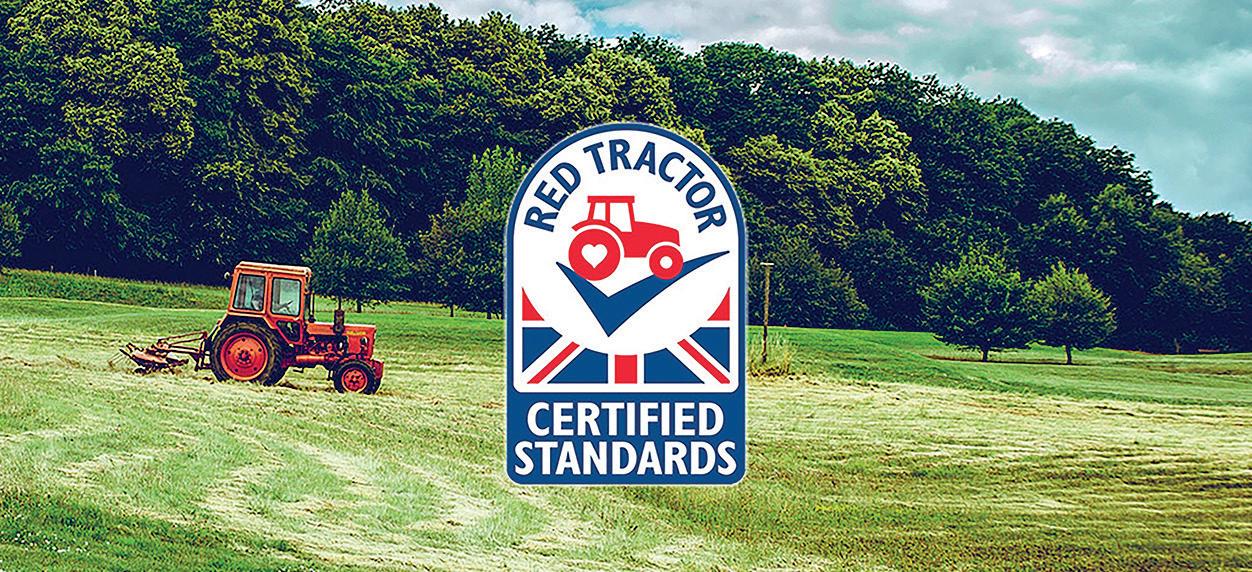
exclusively on international market access – I rest my case.
Red Tractor’s own research shows high consumer recognition for its logo. But that logo recognition is purely based on British consumers and not the global markets where UK high-quality meat and poultry must be sold for UK farmers and processors to prosper and remain in business.
Even without knowing the outcome of AHDB’s three other reviews (key EU countries, North America, and South America/Brazil) it is almost certain that their farmers will be operating without the micromanagement and ‘dodgy’ behind-closed-door dealings (like GFC) of Red Tractor’s management and staff.
It is time to push Red Tractor, and most of the other irrelevant schemes, out to an old shed and leave it there only to be seen as an exhibit on future Open Farm Sundays. Fine, you might say, but what is the alternative? Well, it is staring us in the face.

NORMAN BAGLEY

Head of policy at the Association of Independent Meat Suppliers
against what can be delivered by the Animal Health and Welfare review visit – and we have found that the vast majority of retailers’ requirements can be covered. Where a few gaps exist, on-farm veterinary inspection at a modest additional cost can be used, and any remaining issues can be addressed electronically or remotely.
Then, imagine if the UK’s trade negotiators and levy boards presenting in export markets were able to say that all British livestock and poultry is independently checked both on-farm and at the point of kill by veterinary surgeons.

Animal Health and Welfare reviews are a credible alternative to Red Tractor assurance, says Norman Bagley.
Defra’s funded Animal Health and Welfare on-farm veterinary reviews are a complete game changer in terms of credibility. What amounts to competent authority audit is worth 10 times any third-party audit in terms of world trade. Add to that real-time movement data via Livestock Information, which should keep the Chief Veterinary Officer happy in the event of a disease outbreak, and there you have your basic assurance.
At the Association of Independent Meat Suppliers, we have completed a full gap analysis comparing the existing third-party assurance schemes
Add to this that production and processing for fresh meat, frozen meat and poultry – as well as meat and poultry products – is inspected by the Government’s own Food Standards Agency, all promoted under the globally recognised Union Jack within the UK’s great export strategy.
What is not to like?


